-
CONTACT US if you have any problems registering for the forums.
You are using an out of date browser. It may not display this or other websites correctly.
You should upgrade or use an alternative browser.
You should upgrade or use an alternative browser.
Zurers in Italy - May 2016 (mostly Sicily)
- Thread starter Jim Zurer
- Start date
Day 15: Agrigento
Italy 2016: Monday May 16
Our good luck with the weather continues. We get into the car and drive down to the "Valley of the Temples", which are actually located on a ridge with good views over the sea. This is our third visit to Agrigento and it is just as thrilling as on our previous trips. We spend about two hours looking at the temples which are in various states of restoration. The temples are spread out over about 2 km so you walk along the Via Sacra that connects them. (There is actually a shuttle bus that runs back and forth with rides costing 3 Euros and I confess that we did ride it back to the parking lot when we were finished.)
Here are a representative sample of the sights in the Valley of Temples....a picture is worth a 1,000 words.
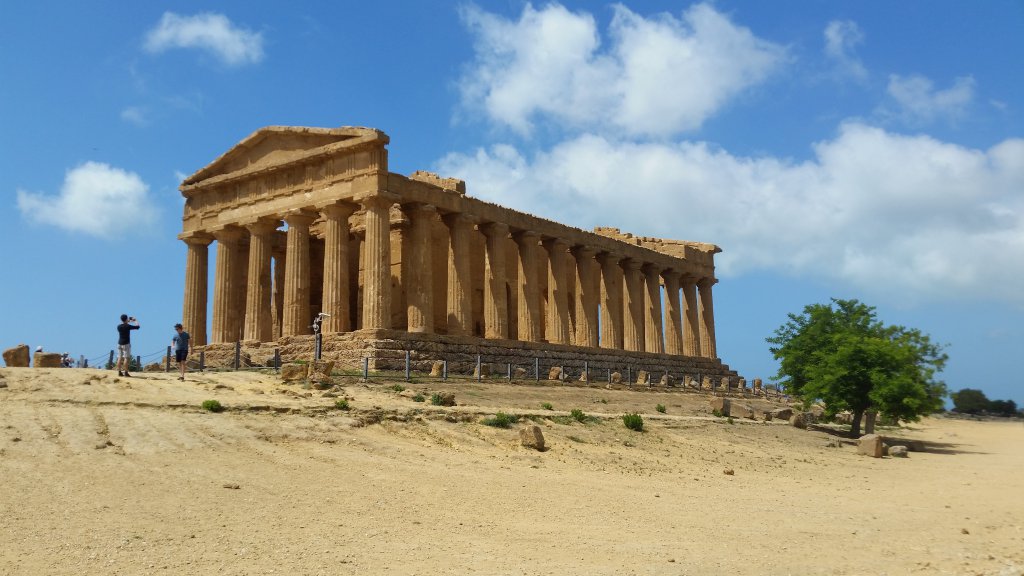
photo by J Zurer
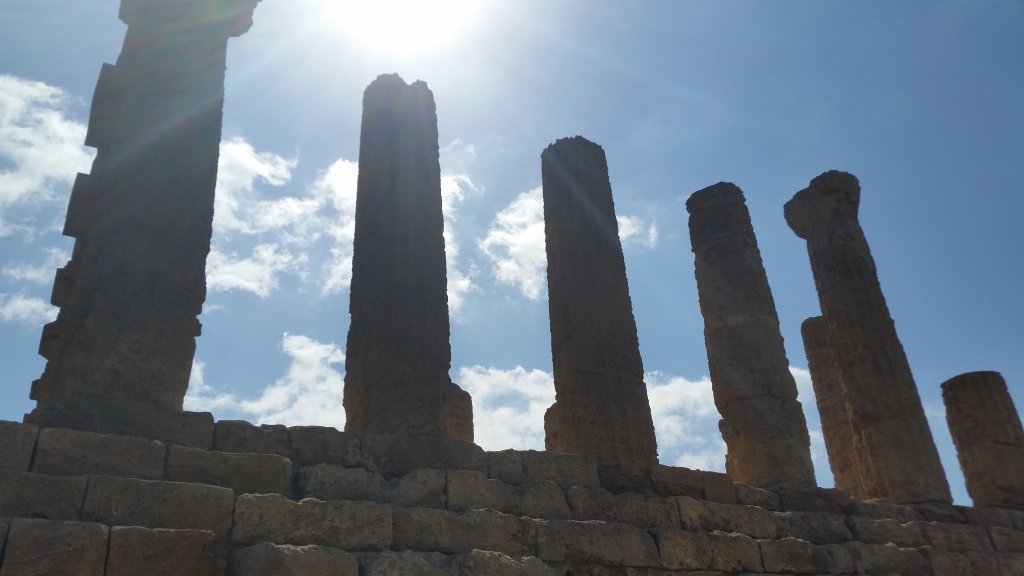
photo by J Zurer
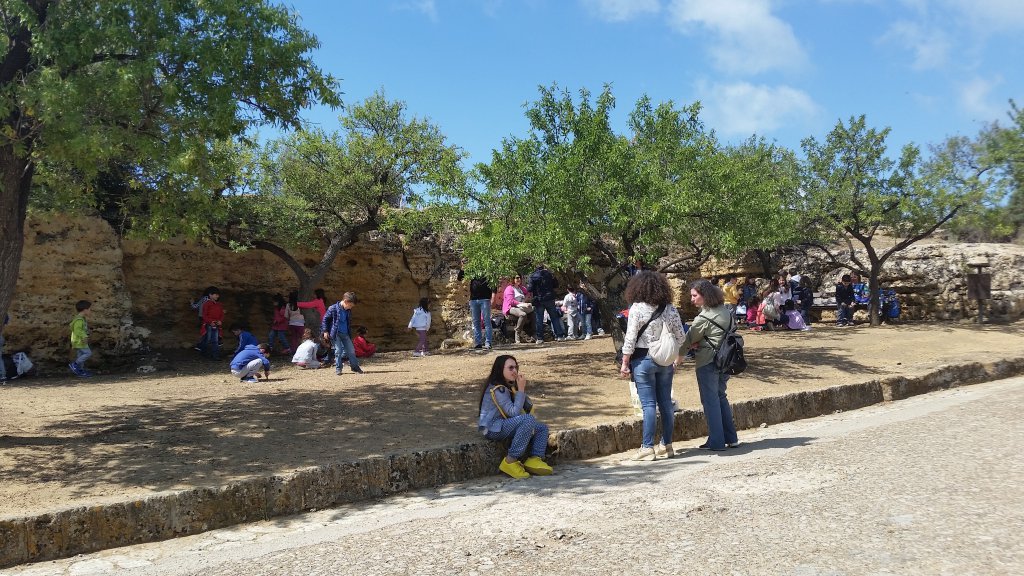
photo by J Zurer
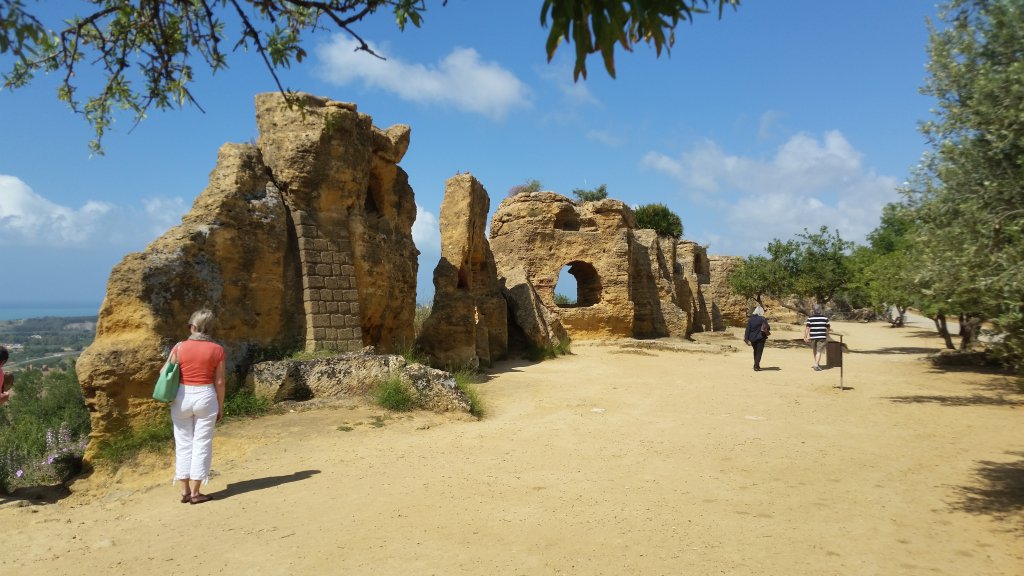
photo by J Zurer
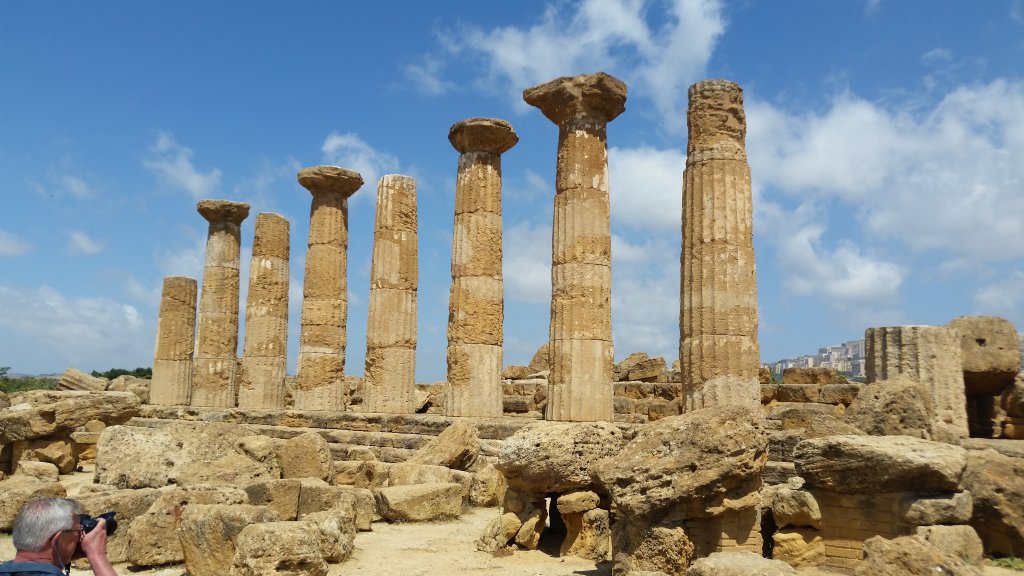
photo by J Zurer
After we have "done" the temples, we get in the car and head for the beach town of San Leone to find some place for lunch. After riding around for a bit, we stop and go into Il Pescatore, a very spiffy restaurant with tables on the street that are encased in a glass "box". The food is a bit more creative and refined than we bargained for but lunch was mostly very good. Diana's prosciutto e melone and Sicilian salad (oranges, olives and fennel) were fine but the small fried shrimp not so good. My fried fish were well done but the tomato salad was just okay. Not a big deal.
Traipsing around temples all morning and having a glass of wine with lunch generally means some resting up time at the hotel and doing some work.
We have several false starts for dinner....places I had identified were either too far to walk, closed on Mondays or fully booked. We end up at a place in the centro storico--Naif--which is okay but the meal is marred by the frequently encountered lagging service. The food is unmemorable save Diana's odd sformata of eggplant and my tasty swordfish dish.
We walk back through the quiet centro, take another peek at the temples from the balcony and go to bed.
Tomorrow...off to Selinunte for more wonderful temples.
Jim and Diana
Italy 2016: Monday May 16
Our good luck with the weather continues. We get into the car and drive down to the "Valley of the Temples", which are actually located on a ridge with good views over the sea. This is our third visit to Agrigento and it is just as thrilling as on our previous trips. We spend about two hours looking at the temples which are in various states of restoration. The temples are spread out over about 2 km so you walk along the Via Sacra that connects them. (There is actually a shuttle bus that runs back and forth with rides costing 3 Euros and I confess that we did ride it back to the parking lot when we were finished.)
Here are a representative sample of the sights in the Valley of Temples....a picture is worth a 1,000 words.
photo by J Zurer
photo by J Zurer
photo by J Zurer
photo by J Zurer
photo by J Zurer
After we have "done" the temples, we get in the car and head for the beach town of San Leone to find some place for lunch. After riding around for a bit, we stop and go into Il Pescatore, a very spiffy restaurant with tables on the street that are encased in a glass "box". The food is a bit more creative and refined than we bargained for but lunch was mostly very good. Diana's prosciutto e melone and Sicilian salad (oranges, olives and fennel) were fine but the small fried shrimp not so good. My fried fish were well done but the tomato salad was just okay. Not a big deal.
Traipsing around temples all morning and having a glass of wine with lunch generally means some resting up time at the hotel and doing some work.
We have several false starts for dinner....places I had identified were either too far to walk, closed on Mondays or fully booked. We end up at a place in the centro storico--Naif--which is okay but the meal is marred by the frequently encountered lagging service. The food is unmemorable save Diana's odd sformata of eggplant and my tasty swordfish dish.
We walk back through the quiet centro, take another peek at the temples from the balcony and go to bed.
Tomorrow...off to Selinunte for more wonderful temples.
Jim and Diana
Last edited:
Day 16: Agrigento-Selinunte
Italy 2016: Tuesday May 17
Sunny and bright...again. I can live with this kind of boring. We leave Agrigento along the coast route to Selinunte but want to stop first to see the Scala dei Turchi, a white cliff formation that juts into the sea just to the west of Agrigento.
According to the Lonely Planet guide, "one of the most mesmerising – and least publicised – sights in the Agrigento area is the Scala dei Turchi. This is a blindingly white rock shaped like a giant staircase that juts out into the sea near the small town of Realmonte. Named after the Arab and Turkish pirates who used to hide out from stormy weather here, it’s a popular spot with local sunseekers who sunbathe on the milky-smooth rock and swim in the indigo sea. "
We circle around a bit as the GPS in the car tries to get its bearings (the signs are a bit ambiguous for a big tourist destination) but finally we glimpse the "turkish stairs" from the road.
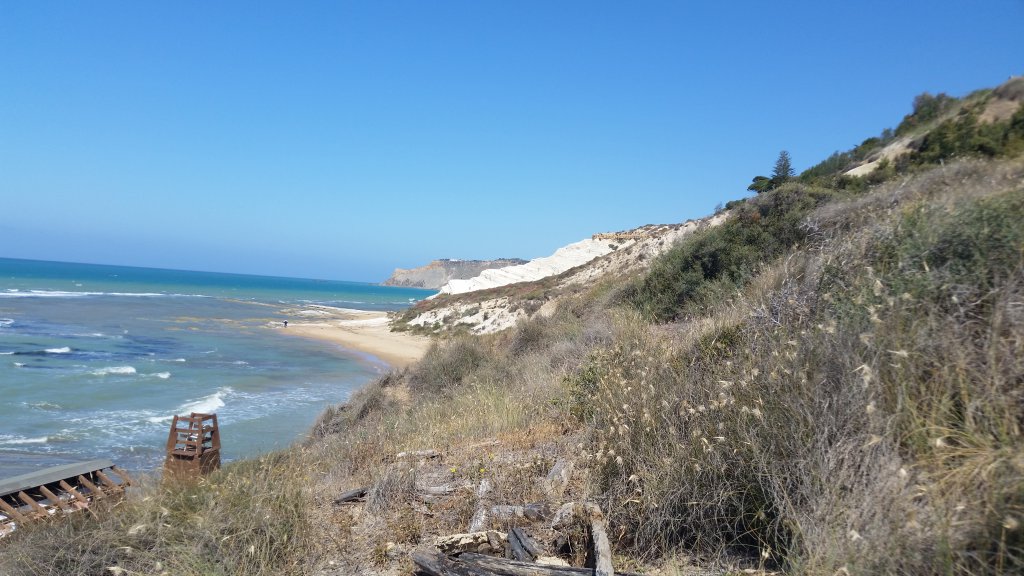
photo by J Zurer
Truth be told, it is not all that impressive from the top and to see it close up, you have to descend a couple of hundred steps and then walk along a beach for a while. I do the steps but forego the beach walk while Diana waits in the car.
Here are some photos that give you a better idea of the Scala....
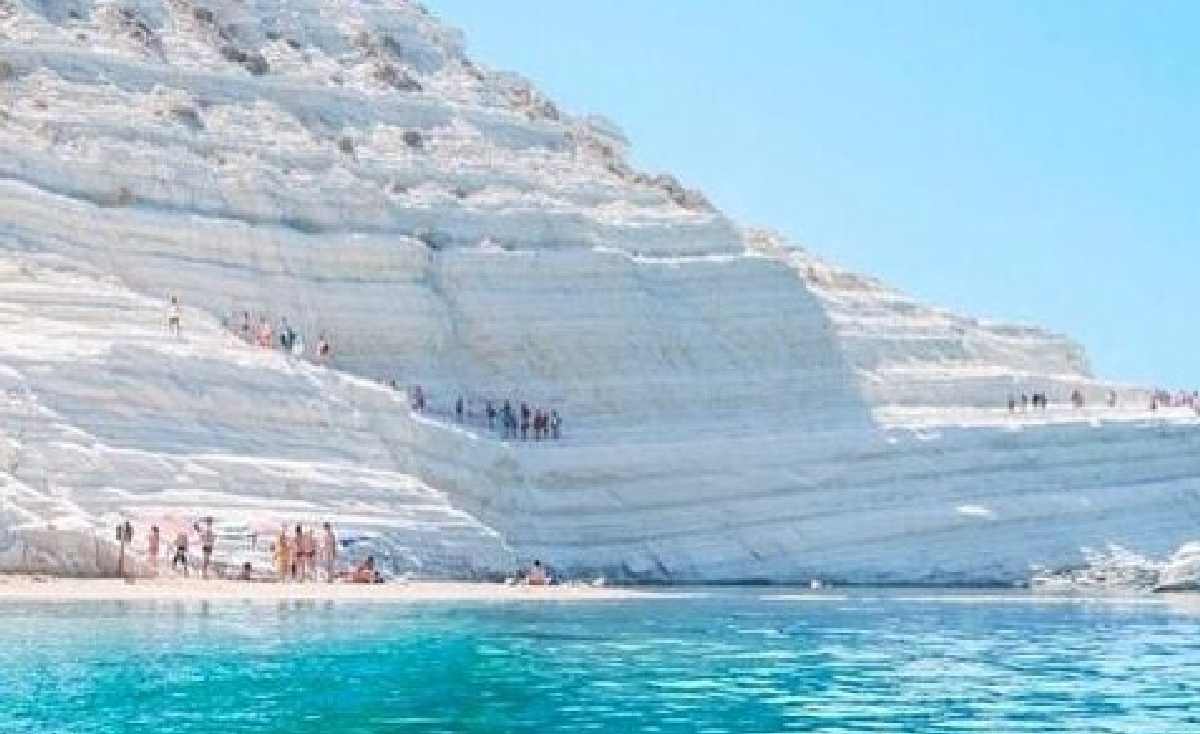
photo from tgcom24.mediaset.it

photo from d2c4sy6bxazc7p.cloudfront.net
Off again, we make a stop in the fishing port of Sciacca which is also famous for its baths. I once had a client who stayed at Grand Hotel delle Terme there but it is more of an attraction for Sicilians. We drive around the harbor (seeing some examples of the tiles that are made here...it is also a big ceramics town).
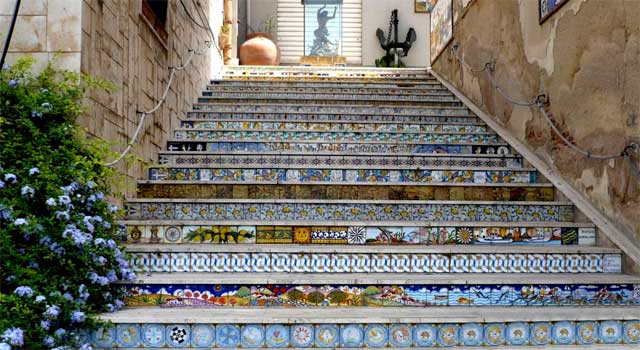
photo from italianspecialoccasions.com
but the traffic is too intense and the available parking scarce so we forego a visit to the well-regarded "centro storico". Next time.....
The drive goes through another very scenic area of Sicily...large well tended fields of olives and grapes that stretch for miles over the rolling countryside. Diana is impressed that there doesn't seem to be a weed in sight and speculates that they are the holdings of large companies which can afford workers to carefully tend the groves.

photo from www.vesuviotour.com
We stop in Porto Palo di Menfi to locate a restaurant--da Vittorio--that I want to try after having seen it featured in a travel program called "Sicily Unpacked" starring chef Giorgio Locatelli and art critic Andrew Graham Dixon. We are too early for lunch but we say that we will go to the hotel in Selinunte which is twenty minutes away, check in and then come back to eat. We are somewhat delayed when the car GPS goes haywire and runs us around in circles before we see the crucial hotel sign that directs us to the right location. (Note: always double check the route with Google Maps before entrusting the navigation to the car GPS). What should have taken twenty minutes has taken forty.
The Hotel Miramare is located on a non-descript strip along the water in Marinella di Selinunte. We stop in a handicapped parking space to unload our luggage and check in and immediately get back in the car and head back to the restaurant.
Our meal is fabulous...the best of the trip. The food is wonderful, the staff professional and welcoming, the setting lovely.
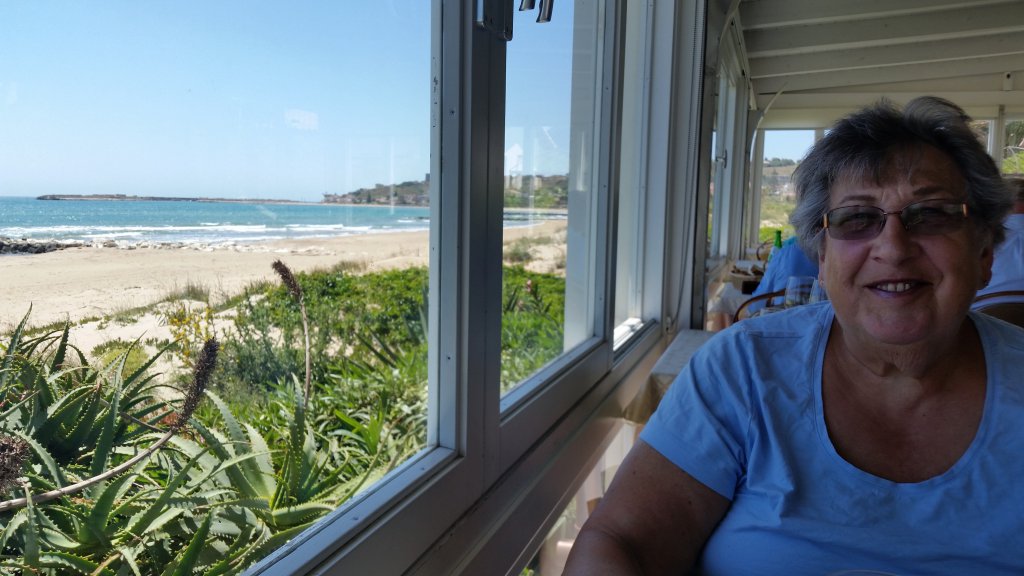
photo by J Zurer
After the best bruschetta with tomatoes (a "gift" from the chef), Diana has a spaghetti with shrimp and pistachios followed by a grilled orata....I have carpaccio of tuna and fritto misto. Shrimp were the best but the calamari were a bit tough. The waiter noticed that they remained mostly uneaten, asked why, I explained, and he brings a fresh plate of calameretti that were perfect. We share a pistachio semifreddo for dessert and a crisp white grillo to drink. Good chance that we will return tomorrow....
Here is a link to a clip from "Sicily Unpacked" that shows the visit to da Vittorio......
View: https://vimeo.com/36188109
We barely make it back to the hotel to collapse in the room .
No dinner tonight...a short walk around the town and a movie on the computer. (Blythe Danner and Sam Elliott in "I'll See You In My Dreams"--very well done film about love among the older set...which means us.)
Tomorrow Selinunte's temples...
Jim and Diana
NOTE: If you are interested in watching the Sicily Unpacked series, you can see them here for free.
View: http://www.dailymotion.com/video/x2jtrmi_sicily-unpacked-1-of-3_travel
View: http://www.dailymotion.com/video/x1yvcpl_bbc-sicily-unpacked-2of3_creation
View: http://www.dailymotion.com/video/x1yve9t_bbc-sicily-unpacked-3of3_travel
Italy 2016: Tuesday May 17
Sunny and bright...again. I can live with this kind of boring. We leave Agrigento along the coast route to Selinunte but want to stop first to see the Scala dei Turchi, a white cliff formation that juts into the sea just to the west of Agrigento.
According to the Lonely Planet guide, "one of the most mesmerising – and least publicised – sights in the Agrigento area is the Scala dei Turchi. This is a blindingly white rock shaped like a giant staircase that juts out into the sea near the small town of Realmonte. Named after the Arab and Turkish pirates who used to hide out from stormy weather here, it’s a popular spot with local sunseekers who sunbathe on the milky-smooth rock and swim in the indigo sea. "
We circle around a bit as the GPS in the car tries to get its bearings (the signs are a bit ambiguous for a big tourist destination) but finally we glimpse the "turkish stairs" from the road.
photo by J Zurer
Truth be told, it is not all that impressive from the top and to see it close up, you have to descend a couple of hundred steps and then walk along a beach for a while. I do the steps but forego the beach walk while Diana waits in the car.
Here are some photos that give you a better idea of the Scala....

photo from tgcom24.mediaset.it

photo from d2c4sy6bxazc7p.cloudfront.net
Off again, we make a stop in the fishing port of Sciacca which is also famous for its baths. I once had a client who stayed at Grand Hotel delle Terme there but it is more of an attraction for Sicilians. We drive around the harbor (seeing some examples of the tiles that are made here...it is also a big ceramics town).

photo from italianspecialoccasions.com
but the traffic is too intense and the available parking scarce so we forego a visit to the well-regarded "centro storico". Next time.....
The drive goes through another very scenic area of Sicily...large well tended fields of olives and grapes that stretch for miles over the rolling countryside. Diana is impressed that there doesn't seem to be a weed in sight and speculates that they are the holdings of large companies which can afford workers to carefully tend the groves.

photo from www.vesuviotour.com
We stop in Porto Palo di Menfi to locate a restaurant--da Vittorio--that I want to try after having seen it featured in a travel program called "Sicily Unpacked" starring chef Giorgio Locatelli and art critic Andrew Graham Dixon. We are too early for lunch but we say that we will go to the hotel in Selinunte which is twenty minutes away, check in and then come back to eat. We are somewhat delayed when the car GPS goes haywire and runs us around in circles before we see the crucial hotel sign that directs us to the right location. (Note: always double check the route with Google Maps before entrusting the navigation to the car GPS). What should have taken twenty minutes has taken forty.
The Hotel Miramare is located on a non-descript strip along the water in Marinella di Selinunte. We stop in a handicapped parking space to unload our luggage and check in and immediately get back in the car and head back to the restaurant.
Our meal is fabulous...the best of the trip. The food is wonderful, the staff professional and welcoming, the setting lovely.
photo by J Zurer
After the best bruschetta with tomatoes (a "gift" from the chef), Diana has a spaghetti with shrimp and pistachios followed by a grilled orata....I have carpaccio of tuna and fritto misto. Shrimp were the best but the calamari were a bit tough. The waiter noticed that they remained mostly uneaten, asked why, I explained, and he brings a fresh plate of calameretti that were perfect. We share a pistachio semifreddo for dessert and a crisp white grillo to drink. Good chance that we will return tomorrow....
Here is a link to a clip from "Sicily Unpacked" that shows the visit to da Vittorio......
We barely make it back to the hotel to collapse in the room .
No dinner tonight...a short walk around the town and a movie on the computer. (Blythe Danner and Sam Elliott in "I'll See You In My Dreams"--very well done film about love among the older set...which means us.)
Tomorrow Selinunte's temples...
Jim and Diana
NOTE: If you are interested in watching the Sicily Unpacked series, you can see them here for free.
Last edited:
Day 17: Selinunte
Italy 2016: Wednesday May 18
Sunny and warm this morning...again.
The hotel serves an old fashioned but satisfying breakfast. Most places now have a buffet but here they lay out portions of bread, cornetti, etc. on each table.
Before going to the temple area which is just behind our hotel, we want to revisit the Cave di Cusa, the quarries where the columns for the Selinunte temples were dug out. You can still see how the massives columns were cut out of the rock because there are a number of uncompleted operations visible and pieces of columns strewn around the grounds.
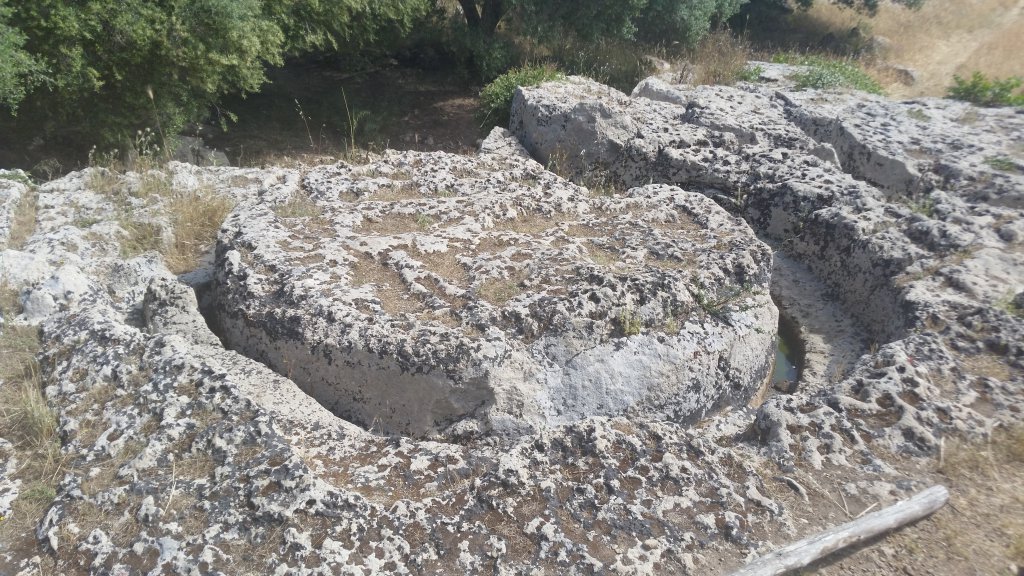
photo by J Zurer
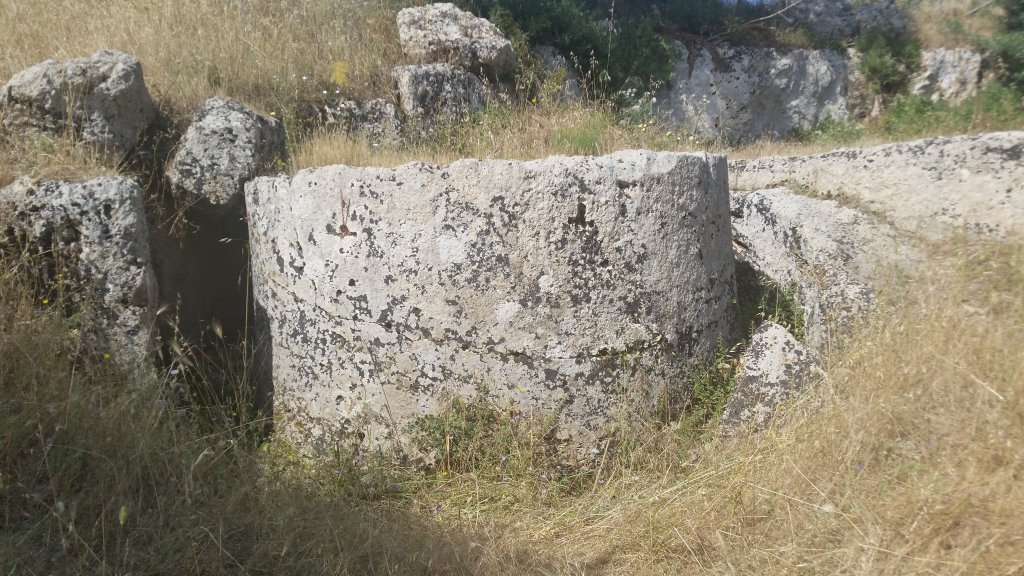
photo by J Zurer
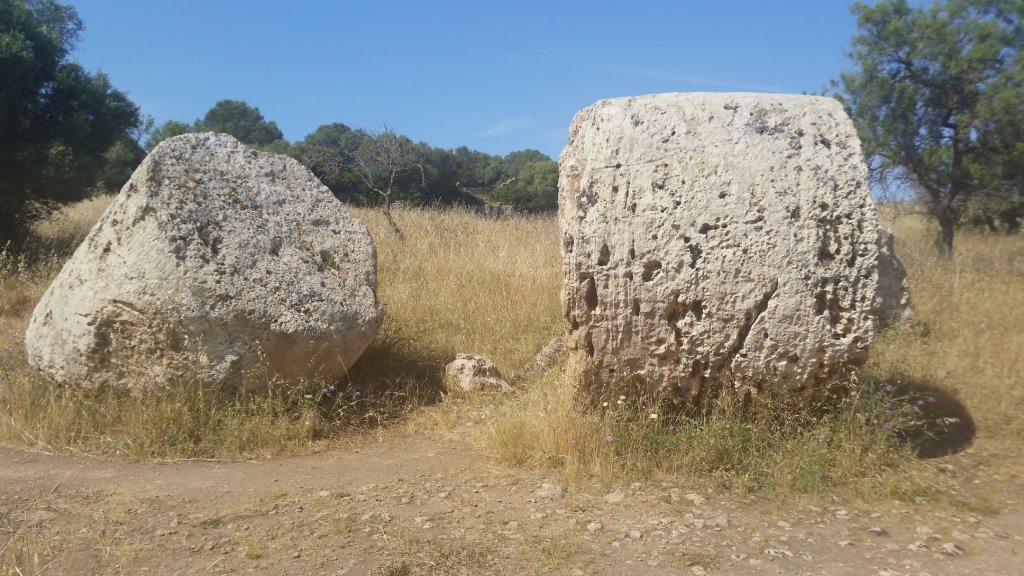
photo by J Zurer
We did have a bit of an adventure finding the Cave...the GPS actually was accurate but we were "alarmed" by the very rough, recently laid stone-paved road that led to the site. We decided to try and find an alternate route, which led us on a wild goose chase through back roads and farms before taking the risk on the "modern" rocky road. We were concerned because the tire pressure warning light was lit. The tires looked fine but we had a flat tire last year after being assured by the car rental office that the tires were okay even if the light was on. After we left the Cave di Cusa, we googled "tire store" but nothing came up in the nearby town. However, as we entered the town, we saw a pile of tires and a sign for a "gommista" right there. The "gommista" checked the pressure, added a tiny bit of air to one tire and sent us our way. However, the warning light was still lit....It took of bit of doing (including calls to Europcar) but it turned out we just needed to reset it, which we did.
The temples at Selinunte speak for themselves.....built during the 5th century BC, they are scattered over a ridge overlooking the sea. Only one temple is almost fully reconstructed...Temple E
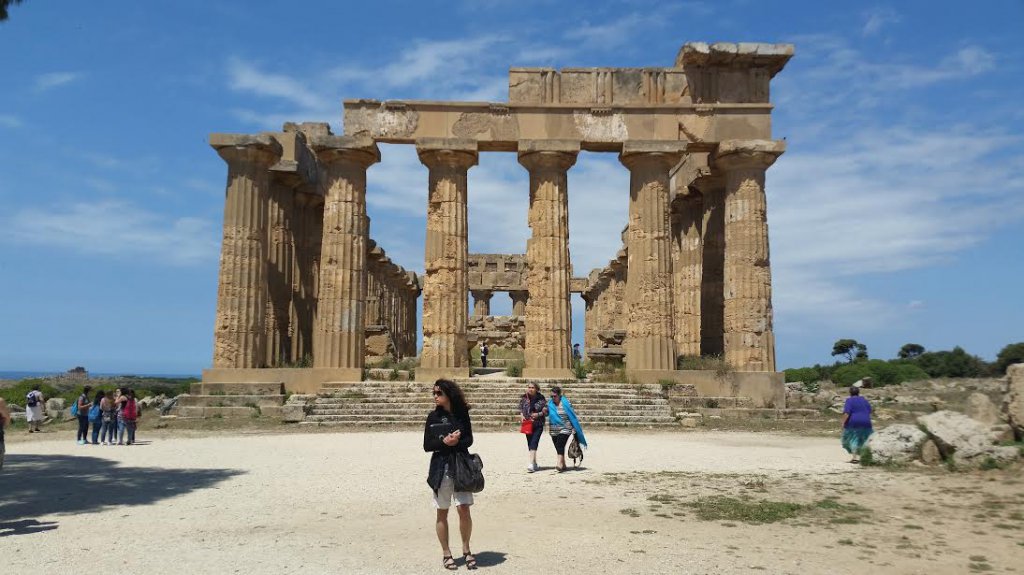
photo by J Zurer
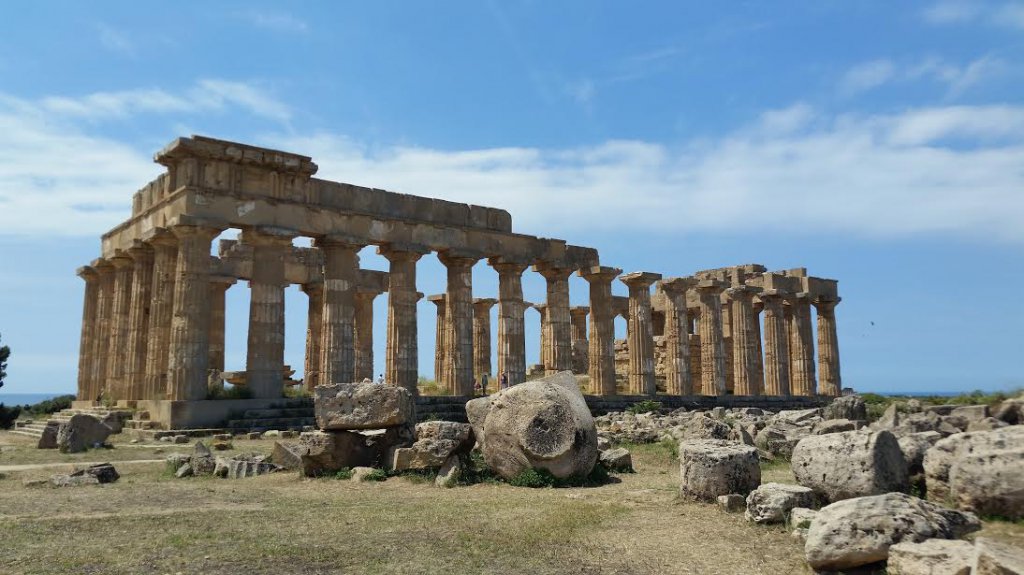
photo by J Zurer
...but the piles of rocks and columns also are thrilling to wander through and imagine them as they were, more than two thousand years ago.
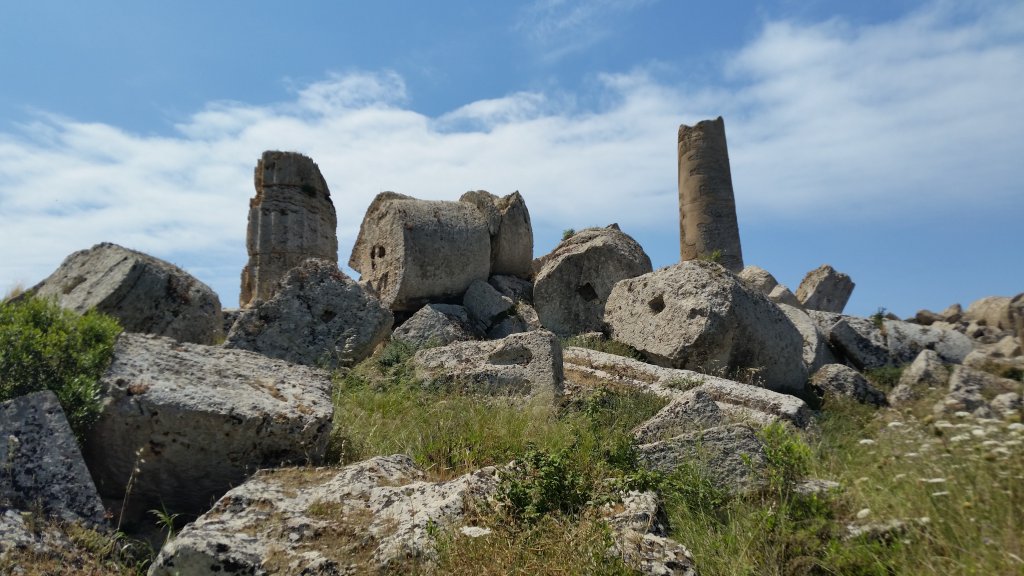
photo by J Zurer
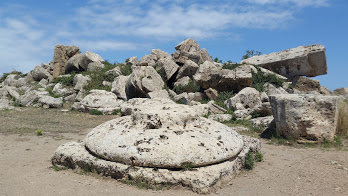
photo by J Zurer
One of the temples in the Acropolis has one row of eight columns that make a striking image.

photo from wikimedia
And I was taken by this single poppy growing out of the steps of Temple E.
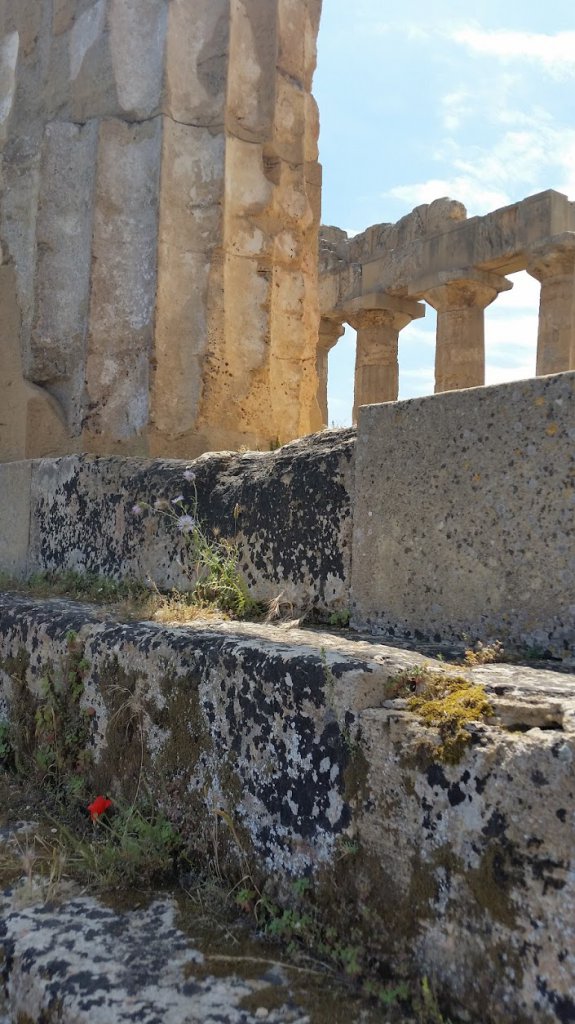
photo by J Zurer
After a couple of hours, we decide that we can't absorb any more and return to da Vittorio for lunch....we don't know when we will have another chance to come here. Lunch is not quite as magical as the day before...but it is still great. Diana has a plate of her favorite--spaghetti aglio olio (olive oil, garlic and a little peperoncino) and a grilled orata. I have Vittorio's special spaghetti with seafood and a gigantic slab of grilled tuna, cooked perfectly but too large to finish. We finish with a beautiful plate of fresh fruit--cherries, strawberries, nectarines. One interesting incident during lunch - Vittorio came out and started waving and yelling to a boat that seemed far off in the sea. It came closer, a zodiac was put down, six people sat in it, and it proceeded toward the restaurant. The passengers hopped out, waded onto the shore, dried themselves off and came in for lunch. Americans. Not George Clooney. Nice.
Back to Selinunte to recover from lunch....no dinner but we walk down the street to a bar for a prosecco and some snacks. This bar has set up makeshift tables and cushions on the steps across the street....an innovative use of public space.
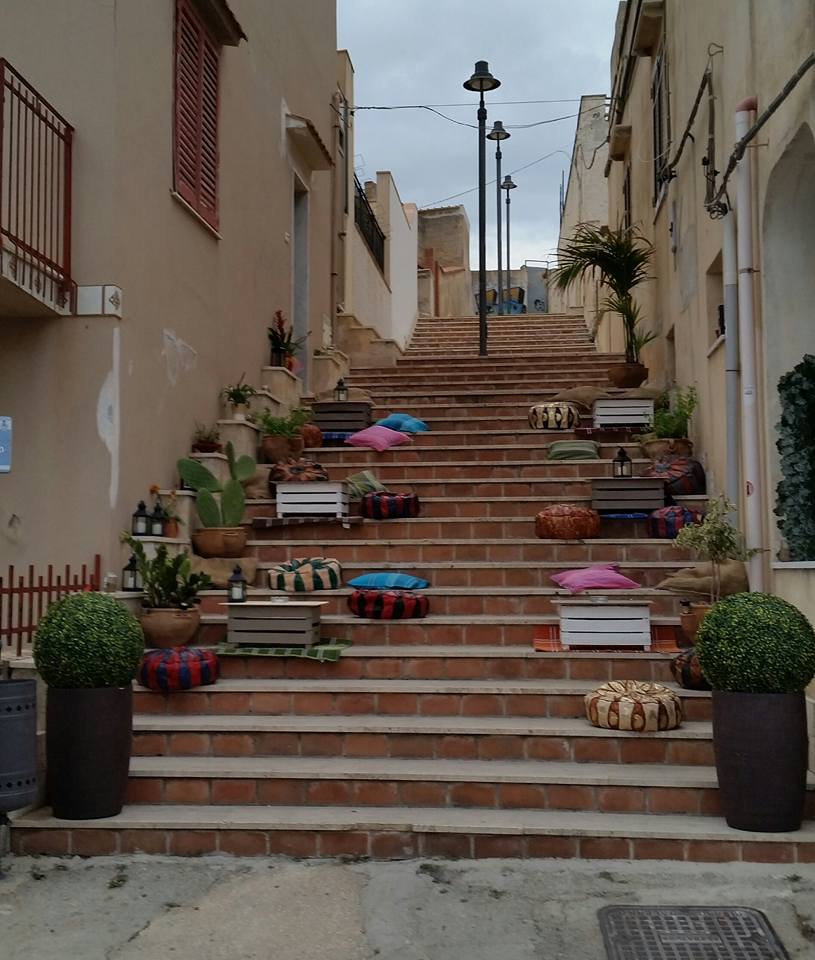
photo by J Zurer
As we finish, it starts to drizzle so we go back to the hotel and watch the two final episodes of "The Good Wife".
Tomorrow to Trapani and our long weekend with our friends, Maureen and Franco.
Jim and Diana
Italy 2016: Wednesday May 18
Sunny and warm this morning...again.
The hotel serves an old fashioned but satisfying breakfast. Most places now have a buffet but here they lay out portions of bread, cornetti, etc. on each table.
Before going to the temple area which is just behind our hotel, we want to revisit the Cave di Cusa, the quarries where the columns for the Selinunte temples were dug out. You can still see how the massives columns were cut out of the rock because there are a number of uncompleted operations visible and pieces of columns strewn around the grounds.
photo by J Zurer
photo by J Zurer
photo by J Zurer
We did have a bit of an adventure finding the Cave...the GPS actually was accurate but we were "alarmed" by the very rough, recently laid stone-paved road that led to the site. We decided to try and find an alternate route, which led us on a wild goose chase through back roads and farms before taking the risk on the "modern" rocky road. We were concerned because the tire pressure warning light was lit. The tires looked fine but we had a flat tire last year after being assured by the car rental office that the tires were okay even if the light was on. After we left the Cave di Cusa, we googled "tire store" but nothing came up in the nearby town. However, as we entered the town, we saw a pile of tires and a sign for a "gommista" right there. The "gommista" checked the pressure, added a tiny bit of air to one tire and sent us our way. However, the warning light was still lit....It took of bit of doing (including calls to Europcar) but it turned out we just needed to reset it, which we did.
The temples at Selinunte speak for themselves.....built during the 5th century BC, they are scattered over a ridge overlooking the sea. Only one temple is almost fully reconstructed...Temple E
photo by J Zurer
photo by J Zurer
...but the piles of rocks and columns also are thrilling to wander through and imagine them as they were, more than two thousand years ago.
photo by J Zurer
photo by J Zurer
One of the temples in the Acropolis has one row of eight columns that make a striking image.

photo from wikimedia
And I was taken by this single poppy growing out of the steps of Temple E.
photo by J Zurer
After a couple of hours, we decide that we can't absorb any more and return to da Vittorio for lunch....we don't know when we will have another chance to come here. Lunch is not quite as magical as the day before...but it is still great. Diana has a plate of her favorite--spaghetti aglio olio (olive oil, garlic and a little peperoncino) and a grilled orata. I have Vittorio's special spaghetti with seafood and a gigantic slab of grilled tuna, cooked perfectly but too large to finish. We finish with a beautiful plate of fresh fruit--cherries, strawberries, nectarines. One interesting incident during lunch - Vittorio came out and started waving and yelling to a boat that seemed far off in the sea. It came closer, a zodiac was put down, six people sat in it, and it proceeded toward the restaurant. The passengers hopped out, waded onto the shore, dried themselves off and came in for lunch. Americans. Not George Clooney. Nice.
Back to Selinunte to recover from lunch....no dinner but we walk down the street to a bar for a prosecco and some snacks. This bar has set up makeshift tables and cushions on the steps across the street....an innovative use of public space.
photo by J Zurer
As we finish, it starts to drizzle so we go back to the hotel and watch the two final episodes of "The Good Wife".
Tomorrow to Trapani and our long weekend with our friends, Maureen and Franco.
Jim and Diana
Last edited:
Day 18: Trapani - Supplement
Italy 2016: Thursday 19 May
This is a supplement to Maureen's guest column for Thursday, May 19.....
The weather is overcast and drizzly as we leave Selinunte for Trapani. We take the autostrada which is longer but takes less time. En route, we make a quick stop at the town of Gibellina Nuova. Destroyed by a severe earthquake in 1968, instead of rebuilding, the town was reconstructed 3 kilometers to the east. As part of the reconstruction, a number of modern artists contributed sculptures that are scattered around the new town.
However, whether it is the rainy weather or the drab 1970's architecture of the town or whether we missed the more impressive works, we are not charmed. We make a short circuit of the town, stopping to see some of the art and modern buildings but make a quick exit.
Some examples of the modern art and unappealing architecture...
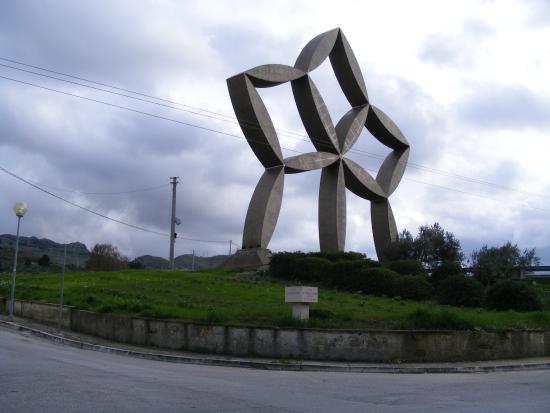
photo from tripadvisor

photo from panoramio
The option to stop at the beautiful Greek temple of Segesta (just off the autostrada) is scotched as we drive through a heavy downpour, but the rain stops as we enter Trapani. We negotiate the extensive modern town successfully. Most of the historic center has limited car traffic (which is a good thing because the streets are very narrow) so in order to reach the vicinity of our hotel, we have to make a big circle. We pull up in a piazza near the hotel (per instructions), unload the car, walk two blocks to the hotel and check in. It all works fine...we check in and then I move the car to the big free parking lot about 10 minutes away.
We hang out in the hotel until it is time to leave for the airport to pick up Maureen and Franco. Their plane is scheduled to arrive at 1:35 pm and we plan to go right to lunch. Luckily we stop for a gelato on our way to the car because their plane is an hour late.
The rest of the day is described in Maureen's guest post below.
Jim and Diana
Our friend Maureen Fant volunteered to submit a guest column during the suspension of the Zurers in Italy daily reports. I am somewhat reluctant to post it since she is a professional writer and the post is so good that my reports may seem ordinary in comparison.
Here is a link to Maureen's web page - www.maureenbfant.com - where you can find out about her books and articles about food and the classical world as well as her cooking classes and her archaeological/culinary tours, Elifant Tours.
Day 18: Guest Column: Trapani
Italy 2016: Thursday 19 May
Franco and I landed at Trapani airport after a delay (fault of Fiumicino, not Ryanair) that threatened to disrupt our carefully planned lunch on the nearby salt pans, but in the tradition of the greatest getaway drivers, Jim and Diana intercepted us as we stepped out of the terminal and we were off.
The stretch of coast between Trapani and Marsala, on the western extreme of Sicily, is known throughout the land as the source of the most delicious sea salt, still being made by (somewhat modified) traditional methods that depend on the combination of hot, sunny weather for months at a time combined with constant strong winds. Windmills and sweat have been replaced by electric pumps and conveyor belts as instruments of production, but otherwise you can grind a bit of history onto your next salad if you buy the lovely white crystals (as we of course did).

photo from www.witaly.it
But lunch at Trattoria del Sale, which is adjacent to the Museo del Sale (Salt , of course): as soon as we sat down, the waiter placed before us a terracotta pot of pesto trapanese surrounded by thick slices of the most delicious bread, probably made of durum wheat, but I can’t swear. Pesto trapanese consists mainly of tomatoes crushed with the particular sweet “red” (i.e., pink) garlic of Nubia, the hamlet in which our salt works were located. I will never be able to make it again unless I can procure that garlic, not in season till June, they all said. But that was just the beginning. We followed the pesto (not to be confused with pesto genovese) with excellent mussels steamed with lemon, caponata, octopus salad, then couscous with fish fillets (imperfectly boned) draped over the mountain of semolina. If you want to know about Sicilian couscous, just ask. There was also a tuna steak smothered in sweet and sour onions and a pleasant lemon sherbet (sort of ) in a glass.
Next came a tour of the salt museum, where the process of successive evaporations, breaking the crust, shoveling the wet salt, piling it up, covering the piles, and then grinding was explained to us. The characteristic windmills are just kept around for the tourists, our guide said. We had no objection.
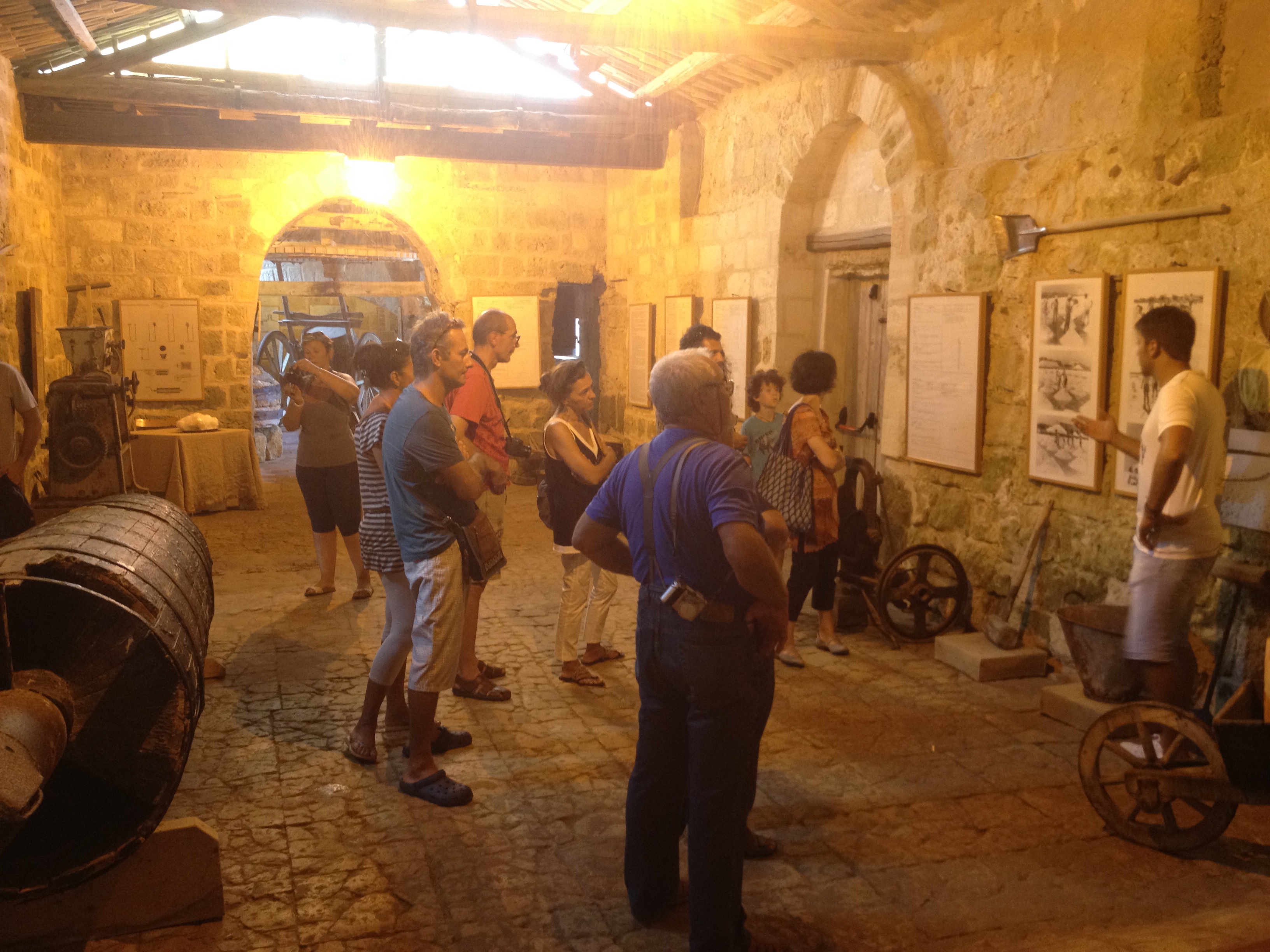
photo from fastntourist.files.wordpress.com
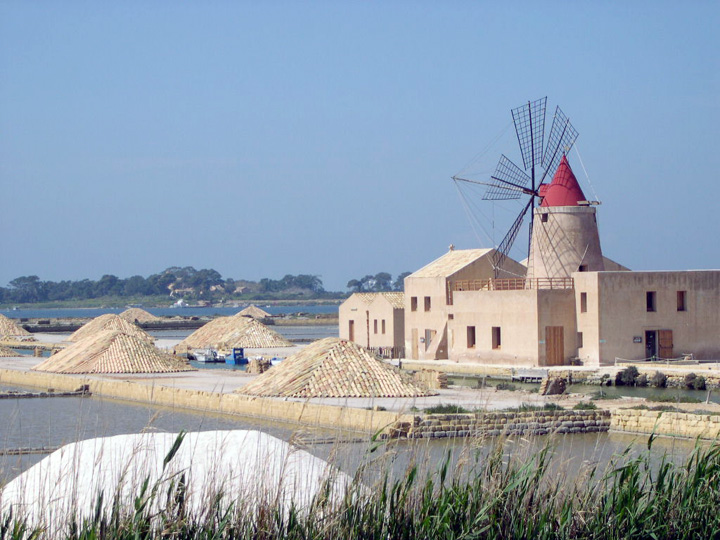
photo from www.sicilytaxiandtour.com
At this writing, we are waiting for water to be restored in our hotel, Badia Nuova, so I will skip describing our initial favorable impression at least until I can have a shower and think straight. The location, in the pedestrianized (mostly) center of Trapani, is great. At checkin they gave us cards for a welcome drink at the wine bar down the block (they’re going to have to give us more than that after this water thing), and, after a lovely long walk around the center and along the water (the historic center is a peninsula),

photo from panoramio.com
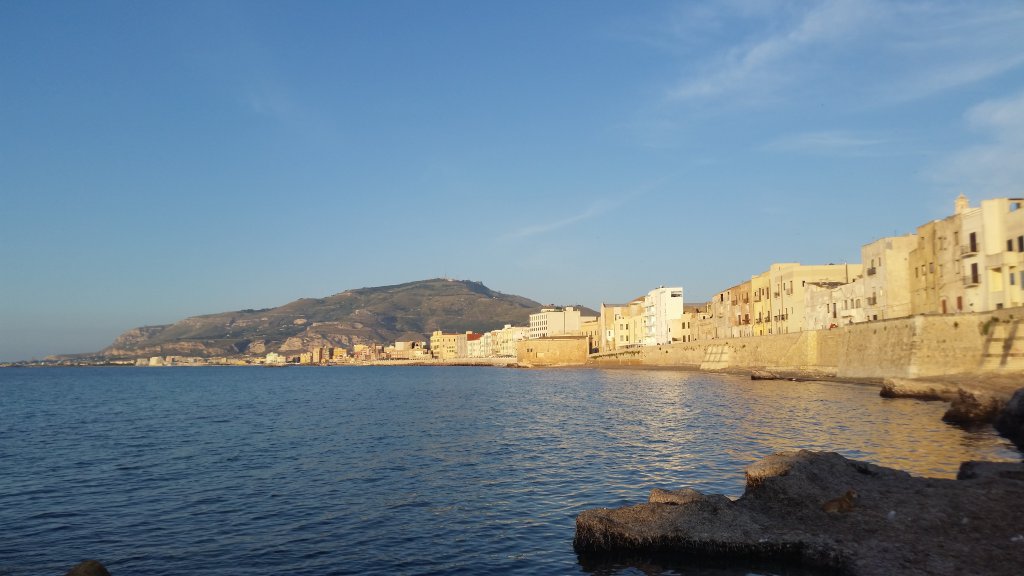
photo by J Zurer
we settled on the uncomfortable stools around a barrel at the wine bar and enjoyed a rosé prosecco which we thought would help us digest our late lunch, but then they gave us some bruschetta with pesto trapanese. That was it for our evening meal. We retired soon after.
But here are some more gastronomic notes. As we walked, Diana told me that in America cannoli shells were called something like “bougie” (if there is a spelling, she can correct it, but the sound was decidedly French, not Italian). I had never heard of this, but a moment later we saw a large pile of the very objects outside a nice bar. I went in and asked (apologetically) if they had a special name, and was told no, nothing special, it's just the “buccia” of the cannolo. Bingo. Not a special name but an ordinary word meaning the outside skin of something, same as an orange.
The second note: We also passed a little storefront panini place, where something called “cazzilli” were being sold and none of us knew what they were (such is Italian food that you can know practically everything about it and/or have lived here all your life — the former being my case, the latter Franco’s — and still encounter something new and you don’t even have to go to a remote corner of Sicily either. The trouble with cazzilli is that they sound like a certain bad word in Italian. I tried to get Franco to go in and ask what they were (me being a lady and all), but he wouldn’t. So I did and learned that they are a sort of potato croquette. Much ado about nothing. The man heard me explain to Jim that sfincione was sort of pizza, so he hastened to explain that the dough was completely different. But, thanks to Jim, I had the last word: Jim eyed panini di milza on the menu and I told the man that Jim loved panini di milza. That was clearly the first time he had met a tourist who could light up at the thought of a spleen sandwich. Unfortunately the couscous was still sitting heavily, so it remained all talk.
Maureen B. Fant
Elifant Archaeo-Culinary Tours
Italy 2016: Thursday 19 May
This is a supplement to Maureen's guest column for Thursday, May 19.....
The weather is overcast and drizzly as we leave Selinunte for Trapani. We take the autostrada which is longer but takes less time. En route, we make a quick stop at the town of Gibellina Nuova. Destroyed by a severe earthquake in 1968, instead of rebuilding, the town was reconstructed 3 kilometers to the east. As part of the reconstruction, a number of modern artists contributed sculptures that are scattered around the new town.
However, whether it is the rainy weather or the drab 1970's architecture of the town or whether we missed the more impressive works, we are not charmed. We make a short circuit of the town, stopping to see some of the art and modern buildings but make a quick exit.
Some examples of the modern art and unappealing architecture...

photo from tripadvisor

photo from panoramio
The option to stop at the beautiful Greek temple of Segesta (just off the autostrada) is scotched as we drive through a heavy downpour, but the rain stops as we enter Trapani. We negotiate the extensive modern town successfully. Most of the historic center has limited car traffic (which is a good thing because the streets are very narrow) so in order to reach the vicinity of our hotel, we have to make a big circle. We pull up in a piazza near the hotel (per instructions), unload the car, walk two blocks to the hotel and check in. It all works fine...we check in and then I move the car to the big free parking lot about 10 minutes away.
We hang out in the hotel until it is time to leave for the airport to pick up Maureen and Franco. Their plane is scheduled to arrive at 1:35 pm and we plan to go right to lunch. Luckily we stop for a gelato on our way to the car because their plane is an hour late.
The rest of the day is described in Maureen's guest post below.
Jim and Diana
Our friend Maureen Fant volunteered to submit a guest column during the suspension of the Zurers in Italy daily reports. I am somewhat reluctant to post it since she is a professional writer and the post is so good that my reports may seem ordinary in comparison.
Here is a link to Maureen's web page - www.maureenbfant.com - where you can find out about her books and articles about food and the classical world as well as her cooking classes and her archaeological/culinary tours, Elifant Tours.
Day 18: Guest Column: Trapani
Italy 2016: Thursday 19 May
Franco and I landed at Trapani airport after a delay (fault of Fiumicino, not Ryanair) that threatened to disrupt our carefully planned lunch on the nearby salt pans, but in the tradition of the greatest getaway drivers, Jim and Diana intercepted us as we stepped out of the terminal and we were off.
The stretch of coast between Trapani and Marsala, on the western extreme of Sicily, is known throughout the land as the source of the most delicious sea salt, still being made by (somewhat modified) traditional methods that depend on the combination of hot, sunny weather for months at a time combined with constant strong winds. Windmills and sweat have been replaced by electric pumps and conveyor belts as instruments of production, but otherwise you can grind a bit of history onto your next salad if you buy the lovely white crystals (as we of course did).

photo from www.witaly.it
But lunch at Trattoria del Sale, which is adjacent to the Museo del Sale (Salt , of course): as soon as we sat down, the waiter placed before us a terracotta pot of pesto trapanese surrounded by thick slices of the most delicious bread, probably made of durum wheat, but I can’t swear. Pesto trapanese consists mainly of tomatoes crushed with the particular sweet “red” (i.e., pink) garlic of Nubia, the hamlet in which our salt works were located. I will never be able to make it again unless I can procure that garlic, not in season till June, they all said. But that was just the beginning. We followed the pesto (not to be confused with pesto genovese) with excellent mussels steamed with lemon, caponata, octopus salad, then couscous with fish fillets (imperfectly boned) draped over the mountain of semolina. If you want to know about Sicilian couscous, just ask. There was also a tuna steak smothered in sweet and sour onions and a pleasant lemon sherbet (sort of ) in a glass.
Next came a tour of the salt museum, where the process of successive evaporations, breaking the crust, shoveling the wet salt, piling it up, covering the piles, and then grinding was explained to us. The characteristic windmills are just kept around for the tourists, our guide said. We had no objection.

photo from fastntourist.files.wordpress.com

photo from www.sicilytaxiandtour.com
At this writing, we are waiting for water to be restored in our hotel, Badia Nuova, so I will skip describing our initial favorable impression at least until I can have a shower and think straight. The location, in the pedestrianized (mostly) center of Trapani, is great. At checkin they gave us cards for a welcome drink at the wine bar down the block (they’re going to have to give us more than that after this water thing), and, after a lovely long walk around the center and along the water (the historic center is a peninsula),

photo from panoramio.com
photo by J Zurer
we settled on the uncomfortable stools around a barrel at the wine bar and enjoyed a rosé prosecco which we thought would help us digest our late lunch, but then they gave us some bruschetta with pesto trapanese. That was it for our evening meal. We retired soon after.
But here are some more gastronomic notes. As we walked, Diana told me that in America cannoli shells were called something like “bougie” (if there is a spelling, she can correct it, but the sound was decidedly French, not Italian). I had never heard of this, but a moment later we saw a large pile of the very objects outside a nice bar. I went in and asked (apologetically) if they had a special name, and was told no, nothing special, it's just the “buccia” of the cannolo. Bingo. Not a special name but an ordinary word meaning the outside skin of something, same as an orange.
The second note: We also passed a little storefront panini place, where something called “cazzilli” were being sold and none of us knew what they were (such is Italian food that you can know practically everything about it and/or have lived here all your life — the former being my case, the latter Franco’s — and still encounter something new and you don’t even have to go to a remote corner of Sicily either. The trouble with cazzilli is that they sound like a certain bad word in Italian. I tried to get Franco to go in and ask what they were (me being a lady and all), but he wouldn’t. So I did and learned that they are a sort of potato croquette. Much ado about nothing. The man heard me explain to Jim that sfincione was sort of pizza, so he hastened to explain that the dough was completely different. But, thanks to Jim, I had the last word: Jim eyed panini di milza on the menu and I told the man that Jim loved panini di milza. That was clearly the first time he had met a tourist who could light up at the thought of a spleen sandwich. Unfortunately the couscous was still sitting heavily, so it remained all talk.
Maureen B. Fant
Elifant Archaeo-Culinary Tours
Last edited:
Pauline
Forums Admin
It is fun reading your trip report as you are traveling Jim! We did a similar trip two years ago (similar to the first part of your trip). We skipped Catania and only had one night in Ortygia. Then we spent a week in Scicli and visited Ragusa, Noto and Modica.
Like you, I disliked Noto. When I booked my trip I thought we would regret not staying in Noto, because it was supposed to be the prettiest town. The day we were there I reached my limit with tourist things. There were too many people and too many tourist oriented shops. Plus we got a parking ticket for being stupid and then got short changed with the slow count at the post office when paying the ticket! Steve knew it was happening but happily gave up a couple of Euro to just get out of there.
We loved Scicli where we stayed. We had a lovely apartment and we enjoyed the town. I think Ragusa would be a very good place to stay and you chose well. We only had a day there but I would like to spend more time there.
How much you love travel and Italy comes through clearly in your report. I like to think of you both in Sicily now having a lovely time.
And how wonderful to have a guest post from Maureen Fant!! Her book "Dictionary of Italian Cuisine" is on my travel bookshelf and has been well used over the years.
Like you, I disliked Noto. When I booked my trip I thought we would regret not staying in Noto, because it was supposed to be the prettiest town. The day we were there I reached my limit with tourist things. There were too many people and too many tourist oriented shops. Plus we got a parking ticket for being stupid and then got short changed with the slow count at the post office when paying the ticket! Steve knew it was happening but happily gave up a couple of Euro to just get out of there.
We loved Scicli where we stayed. We had a lovely apartment and we enjoyed the town. I think Ragusa would be a very good place to stay and you chose well. We only had a day there but I would like to spend more time there.
How much you love travel and Italy comes through clearly in your report. I like to think of you both in Sicily now having a lovely time.
And how wonderful to have a guest post from Maureen Fant!! Her book "Dictionary of Italian Cuisine" is on my travel bookshelf and has been well used over the years.
Pauline
Forums Admin
It is one of those big Sicilian fixed menus...endless appetizers with the possibility of repeats of favorites, a skippable duo of pastas which were followed by plentiful and delicious plates of sausage, pork, lamb chops and a Palermitan specialty (that we had to look up on the internet)--stigghiola.
Jim, are you not traveling with Dana Facaros' Italian Food Decoder on your phone or tablet? We never go to Italy without it! Her definition: "A traditional Palermo snack, stigghiola are lamb intestines, typically grilled out on the street (sometimes wrapped around a leek or a scallion) and served with a little parsley and lemon. They are said to give the menfolk a little extra zip."
Dishes like these make me grateful to be a long time vegetarian - so I will never have to try this. Yuck!!
We loved the mosaics at Villa Casale. We have hunted out Roman mosaics all over England, France and Italy. But after seeing Villa Casale I feel like we never need look for mosaics again. These are the best!
Maureen has graciously submitted another post about our exploits in Mazara del Vallo and Marsala. Enjoy.
Day 19 - Guest Column: Trapani
Italy 2016: Friday, May 20
Up betimes and eggs for breakfast at the restaurant next door followed by a visit to the fish market. This is one of my favorite things to do anywhere because then you know what to order later in the day. Inspired by the six or eight kinds of unbelievably beautiful shrimp of every shade of pink and size, Diana and I had succulent little breaded baked shrimp at Cantina Siciliana that evening. But I am getting ahead of myself. We admired the massive quantities of tuna, two moray eels (which Franco wanted to buy and deliver to the hotel restaurant to cook for us that evening, but the rest of us managed to talk him down), anchovies and sardines galore, and other varieties of fish we simply never see in Rome, much less anywhere else.
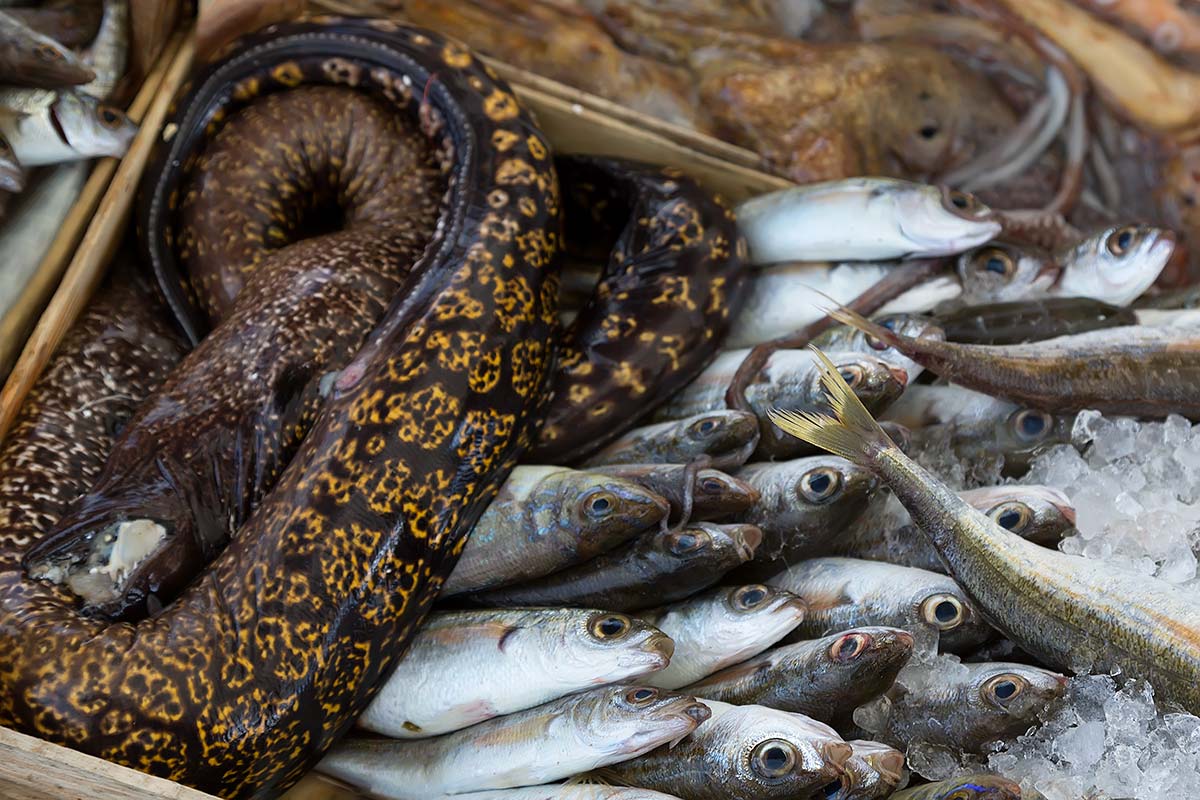
photo from www.cookiesound.com
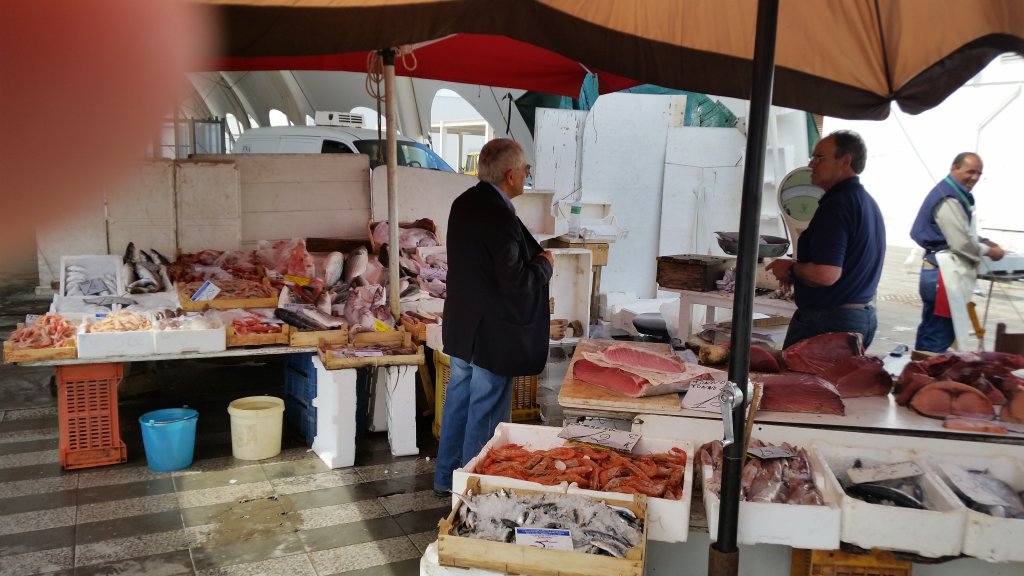
photo by J Zurer
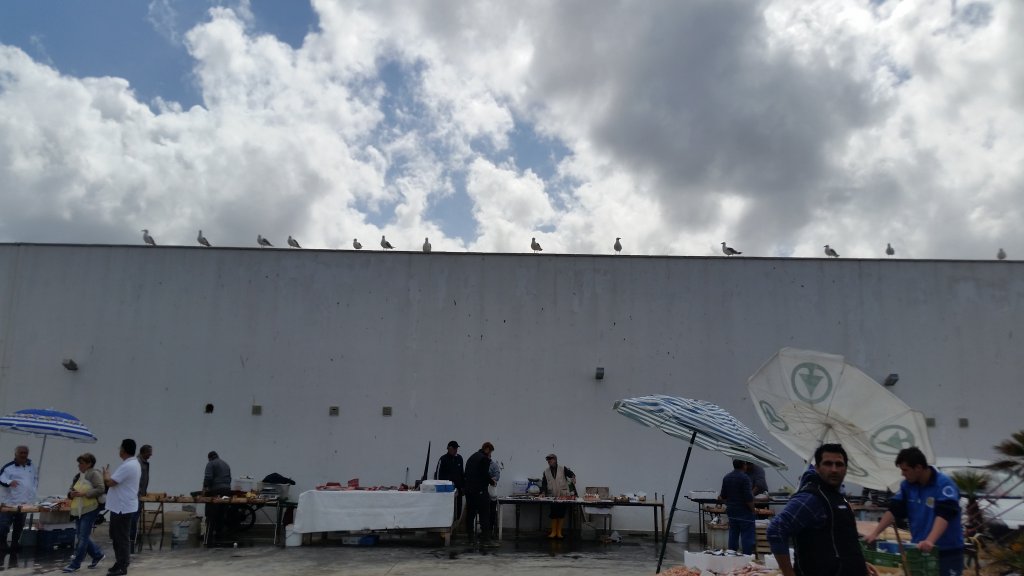
photo by J Zurer
From there we followed the car’s navigator deep into the Sicilian hinterland before emerging at the picturesque coastal town of Mazara del Vallo.
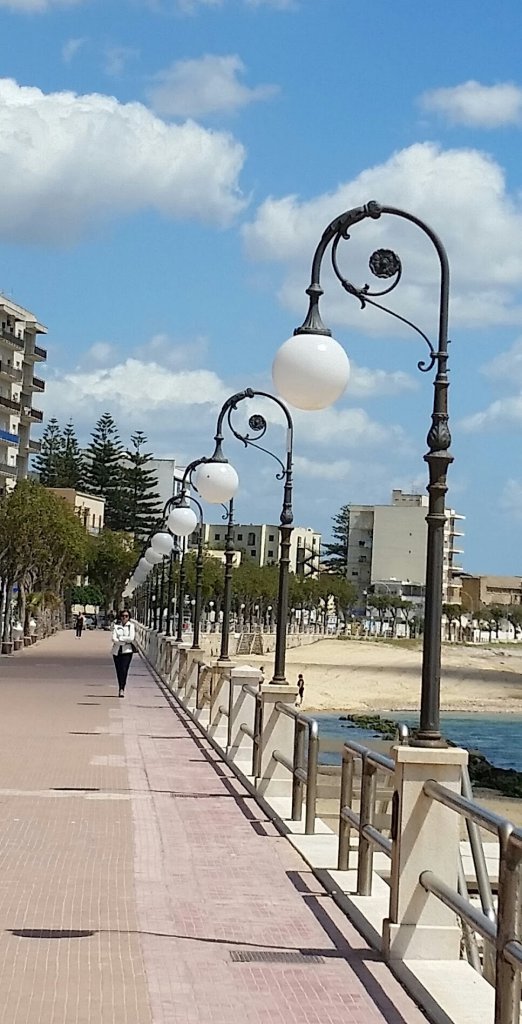
A few years ago Mazara’s claim to fame became a unique ancient bronze statue found in two dramatic stages by the crew of a local fishing boat. After painstaking restoration in Rome (and you simply have no idea, but watch the video in the little museum), the statue, having been studied and variously interpreted till its little crownless cranium was undoubtedly spinning, was shipped back to Mazara and put on display in a new purpose-designed museum in a church on Piazza del Plebiscito (the plebiscite, commemorated in many Italian street names, is the one that ended the monarchy). It is magnificent. The room is too dark, but it’s still a privilege to be able to view the statue.
The statue, which you should Google, is called the Dancing Satyr, Il Satiro Danzante, because it appears to be in the throes of an ecstatic dance, much like any number of female statues and reliefs from classical Greece on down to the Roman period. One leg is missing but the other is thrust out behind, while the torsion of the torso and the long, windblown hair make it clear that this is some kind of wild dance, and his facial expression and inlaid eyes (not empty sockets) show that he was clearly high on something.
In order to buy a book about the statue, we had to go to a bookstore, nothing being sold at the museum. The bookstore is called Le Bugie, The Lies, which should go into the global registry of inappropriate business names.
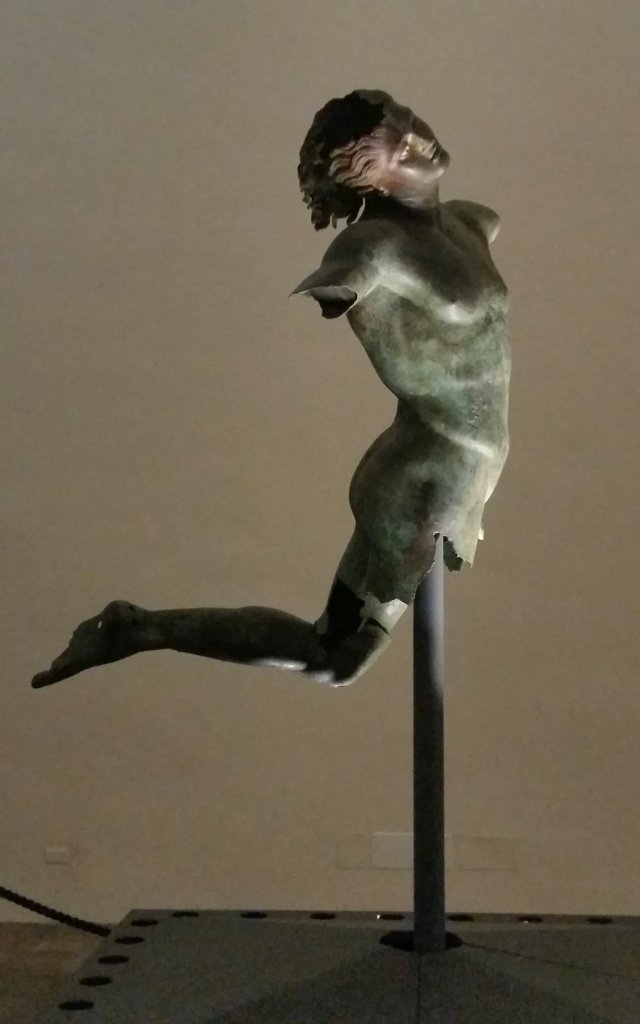
photo by J Zurer
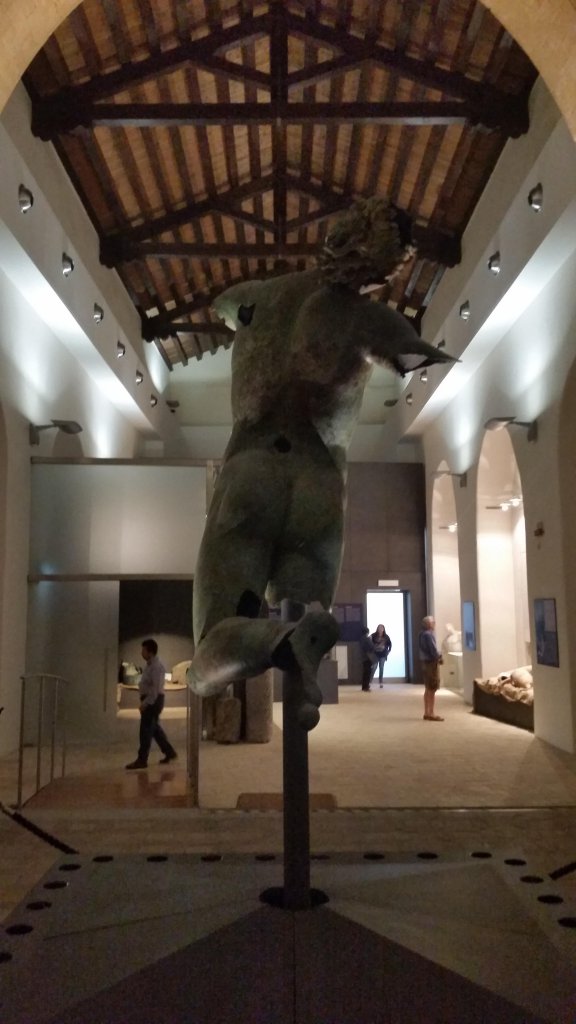
photo by J Zurer
Lunch, at Trattoria Scopari, was not at the same level, but was extremely enjoyable (lotsa caponata, octopus, spaghetti with sardines and fennel, more couscous), plus we got to feel superior to, and annoyed at, the four French people who ordered pizza margherita. I mean, seriously? Did they know they were in Sicily?
A half hour or so north, also on the coast, about halfway back to Trapani, lies Marsala, known for the wine, itself not half as well known as the world thinks. Marsala, which we didn’t taste, but which I know from a long ago (evidently failed) attempt at promoting itself, comes in varying degrees of sweetness and dryness and can, and should, be sipped, not just poured in a pan with a slice of veal. The town is very pretty except for a high degree of low-grade shops and eateries that nobody you know would be caught dead in. But after the gauntlet of the main drag, outside the Porta Nuova (or was it the other gate?), we traipsed through the interesting (enough) ruins of a Roman insula and bath complex with some nice mosaic floors.
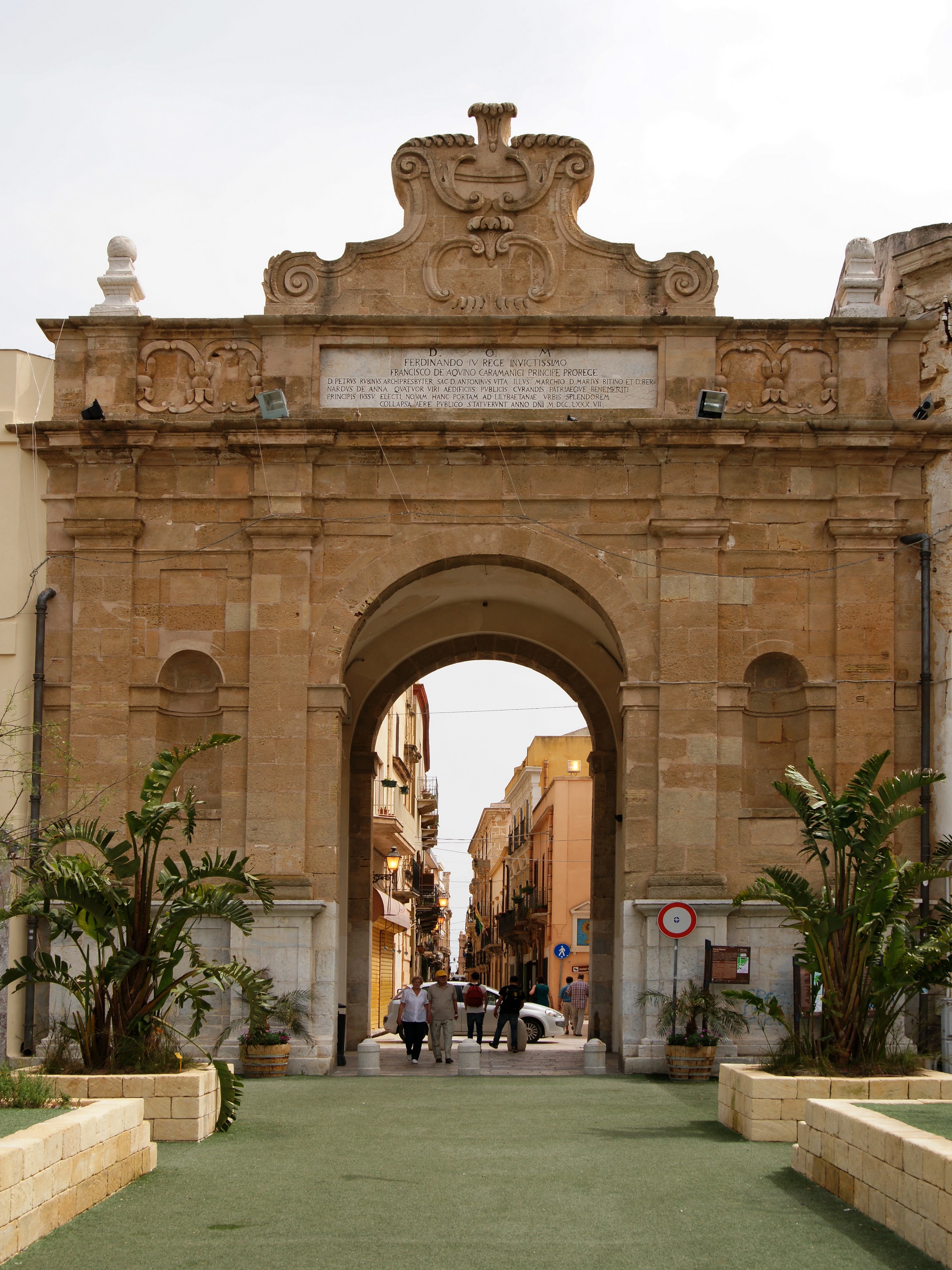
photo from wikimedia
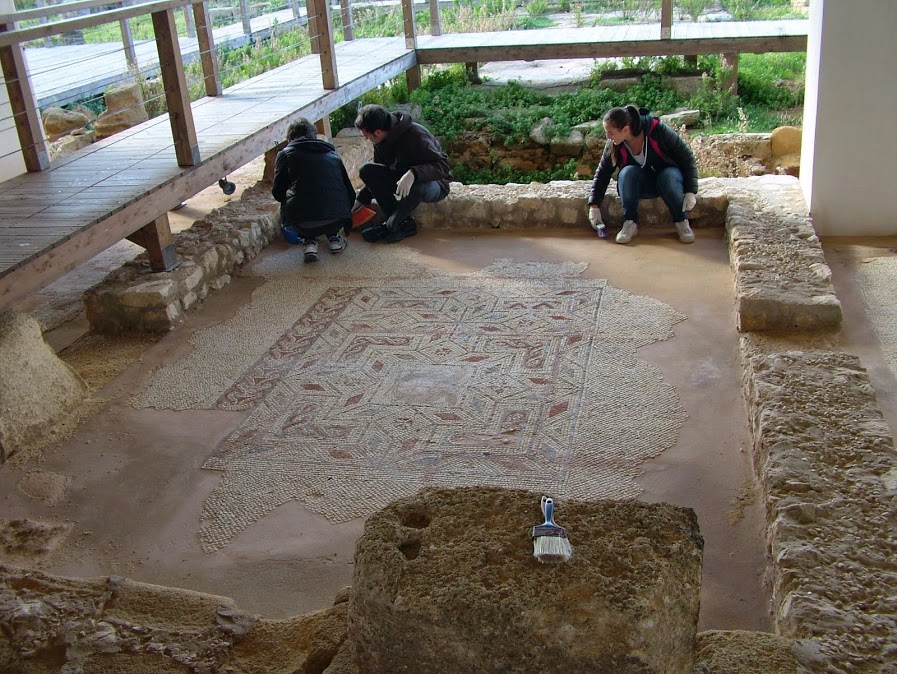
photo from www.lionsmarsala.it
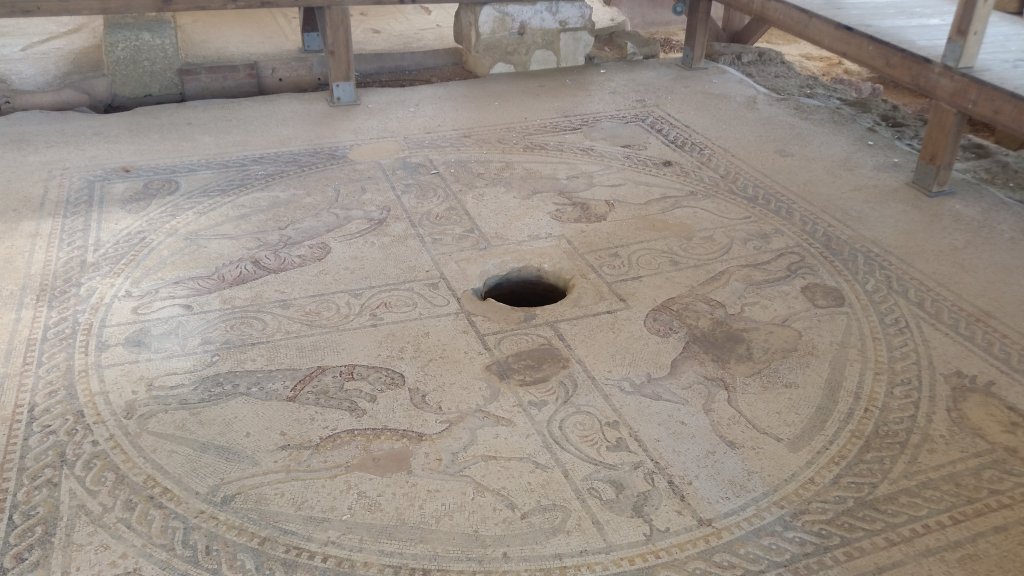
photo by J Zurer
Never go anywhere near a Roman mosaic without a spray bottle of water so you can surreptitiously render the colors visible. One of those corks that used to go in the ginger ale bottle before steam irons would be perfect if they still exist. More traipsing took us to a small collection of artifacts from ancient Lilybaeum, which is what Marsala was, a Punic city and site of a Roman naval victory in the Second Punic War (218 BC, if you care). Some pictures will suffice, and I will spare us all the blow by blow of the collection.
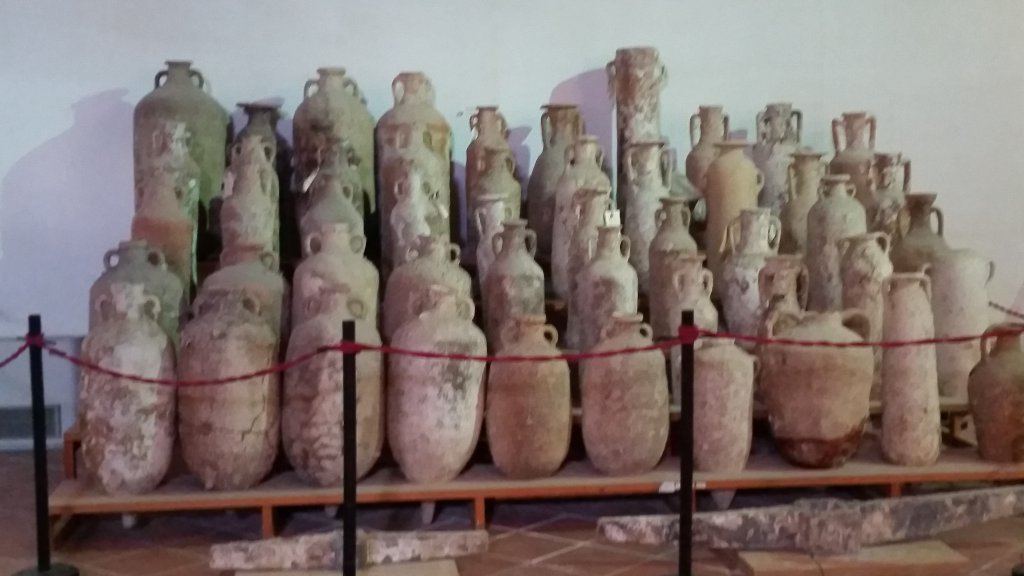
photo by J Zurer
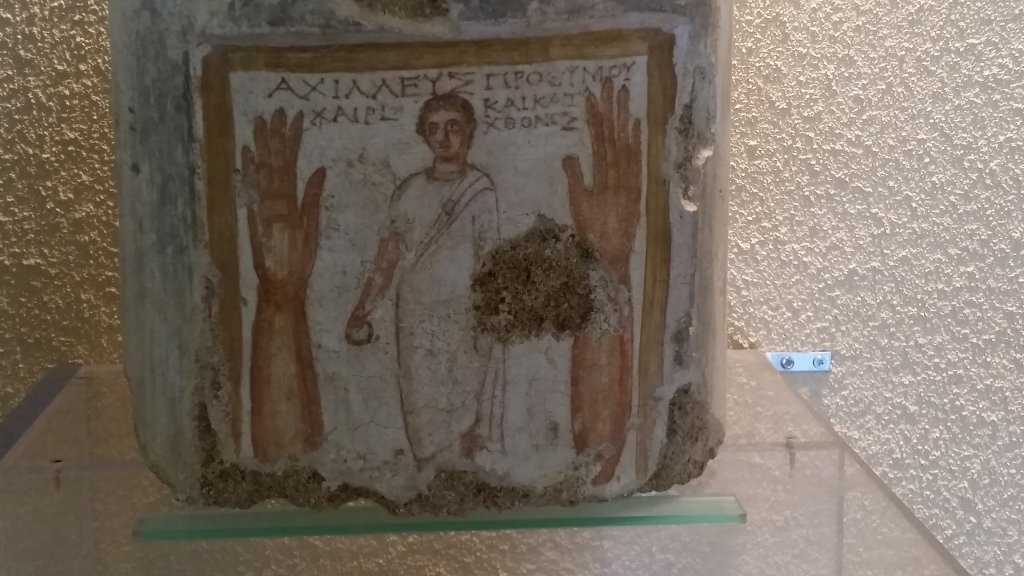
photo by J Zurer
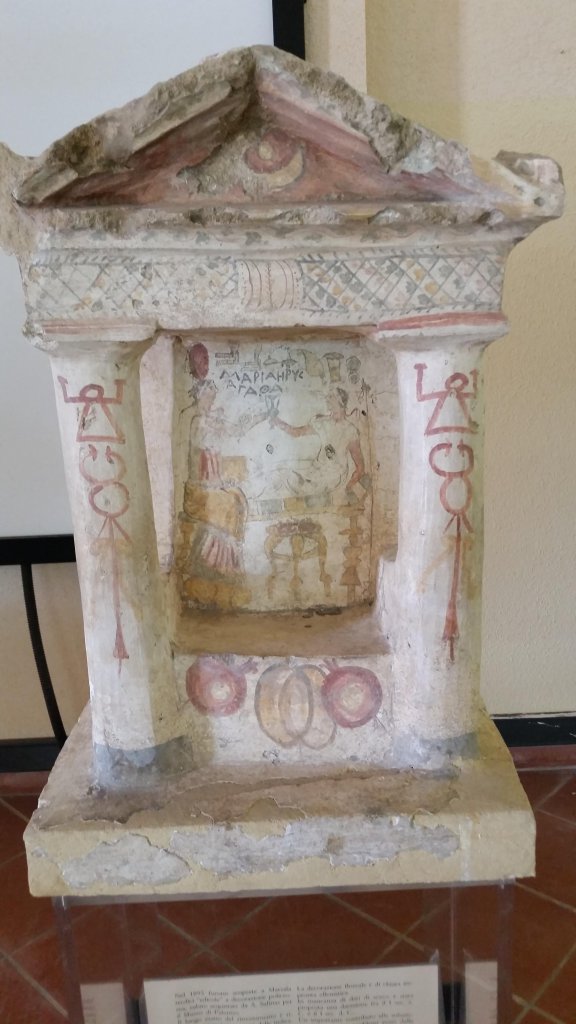
photo by J Zurer
We retired to our respective quarters and reassembled for aperitivi down the street with the barrels again, but indoors this time. We had enough appetite for a little dinner, which is where my tale began. At Cantina Siciliana, in the old Jewish quarter of Trapani (not that you could really tell), we learned of a new (to us) dish: sarde allinguate, sardines boned and butterflied, briefly marinated, and floured and fried. They were good, but a little goes a long way. Those shrimp were lovely, but the breading was overpowering. We also learned a new dessert, cassatelle alla trapanese, which have nothing to do with cassata alla siciliana; rather, they are ravioli-like pastries filled with smooth ricotta delicately marbled with chocolate. Seriously delish. Tiny glasses of sweet zibibbo wine appeared as the last act of our very full day.
Maureen B. Fant
Elifant Archaeo-Culinary Tours
Day 19 - Guest Column: Trapani
Italy 2016: Friday, May 20
Up betimes and eggs for breakfast at the restaurant next door followed by a visit to the fish market. This is one of my favorite things to do anywhere because then you know what to order later in the day. Inspired by the six or eight kinds of unbelievably beautiful shrimp of every shade of pink and size, Diana and I had succulent little breaded baked shrimp at Cantina Siciliana that evening. But I am getting ahead of myself. We admired the massive quantities of tuna, two moray eels (which Franco wanted to buy and deliver to the hotel restaurant to cook for us that evening, but the rest of us managed to talk him down), anchovies and sardines galore, and other varieties of fish we simply never see in Rome, much less anywhere else.

photo from www.cookiesound.com
photo by J Zurer
photo by J Zurer
From there we followed the car’s navigator deep into the Sicilian hinterland before emerging at the picturesque coastal town of Mazara del Vallo.
A few years ago Mazara’s claim to fame became a unique ancient bronze statue found in two dramatic stages by the crew of a local fishing boat. After painstaking restoration in Rome (and you simply have no idea, but watch the video in the little museum), the statue, having been studied and variously interpreted till its little crownless cranium was undoubtedly spinning, was shipped back to Mazara and put on display in a new purpose-designed museum in a church on Piazza del Plebiscito (the plebiscite, commemorated in many Italian street names, is the one that ended the monarchy). It is magnificent. The room is too dark, but it’s still a privilege to be able to view the statue.
The statue, which you should Google, is called the Dancing Satyr, Il Satiro Danzante, because it appears to be in the throes of an ecstatic dance, much like any number of female statues and reliefs from classical Greece on down to the Roman period. One leg is missing but the other is thrust out behind, while the torsion of the torso and the long, windblown hair make it clear that this is some kind of wild dance, and his facial expression and inlaid eyes (not empty sockets) show that he was clearly high on something.
In order to buy a book about the statue, we had to go to a bookstore, nothing being sold at the museum. The bookstore is called Le Bugie, The Lies, which should go into the global registry of inappropriate business names.
photo by J Zurer
photo by J Zurer
Lunch, at Trattoria Scopari, was not at the same level, but was extremely enjoyable (lotsa caponata, octopus, spaghetti with sardines and fennel, more couscous), plus we got to feel superior to, and annoyed at, the four French people who ordered pizza margherita. I mean, seriously? Did they know they were in Sicily?
A half hour or so north, also on the coast, about halfway back to Trapani, lies Marsala, known for the wine, itself not half as well known as the world thinks. Marsala, which we didn’t taste, but which I know from a long ago (evidently failed) attempt at promoting itself, comes in varying degrees of sweetness and dryness and can, and should, be sipped, not just poured in a pan with a slice of veal. The town is very pretty except for a high degree of low-grade shops and eateries that nobody you know would be caught dead in. But after the gauntlet of the main drag, outside the Porta Nuova (or was it the other gate?), we traipsed through the interesting (enough) ruins of a Roman insula and bath complex with some nice mosaic floors.
photo from wikimedia
photo from www.lionsmarsala.it
photo by J Zurer
Never go anywhere near a Roman mosaic without a spray bottle of water so you can surreptitiously render the colors visible. One of those corks that used to go in the ginger ale bottle before steam irons would be perfect if they still exist. More traipsing took us to a small collection of artifacts from ancient Lilybaeum, which is what Marsala was, a Punic city and site of a Roman naval victory in the Second Punic War (218 BC, if you care). Some pictures will suffice, and I will spare us all the blow by blow of the collection.
photo by J Zurer
photo by J Zurer
photo by J Zurer
We retired to our respective quarters and reassembled for aperitivi down the street with the barrels again, but indoors this time. We had enough appetite for a little dinner, which is where my tale began. At Cantina Siciliana, in the old Jewish quarter of Trapani (not that you could really tell), we learned of a new (to us) dish: sarde allinguate, sardines boned and butterflied, briefly marinated, and floured and fried. They were good, but a little goes a long way. Those shrimp were lovely, but the breading was overpowering. We also learned a new dessert, cassatelle alla trapanese, which have nothing to do with cassata alla siciliana; rather, they are ravioli-like pastries filled with smooth ricotta delicately marbled with chocolate. Seriously delish. Tiny glasses of sweet zibibbo wine appeared as the last act of our very full day.
Maureen B. Fant
Elifant Archaeo-Culinary Tours
Last edited:
Jim, are you not traveling with Dana Facaros' Italian Food Decoder on your phone or tablet? We never go to Italy without it!
We don't have the menu decoder....at this time , we usually rely on the internet for unknown or unfamiliar items. But we used to travel with Maureen and Howard's Dictionary, but now leave it home on the shelf.
Yet another wonderful report by Maureen Fant...this one about our Saturday in and around Trapani.
Day 20: Guest Column: Trapani
Italy 2016: Saturday, May 21:
The day began with a nasty surprise — no water in our hotel — followed by another. The off-hours number provided was not an actual number but the regular number, which was supposed to be forwarded to someone’s cell, only it wasn’t. I mention this not so you’ll feel sorry for us early risers in our unwashed, unflushed, uninformed, and unreassured plight, but so that you will always badger hotels for a proper emergency number if there is nobody on duty 24 hours a day.
By 8-ish we had information that the problem was being dealt with and water would be restored in a "few minutes,” to be understood as “we’re on it, go away.” The few minutes lasted till sometime after 10, which could have been worse. Meanwhile we learned some of the quirks of the local plumbing. You probably don’t care, but I’ll just say the climax of the story was the transfer of water from a truck through a tube that we had to step over to get out the front door.
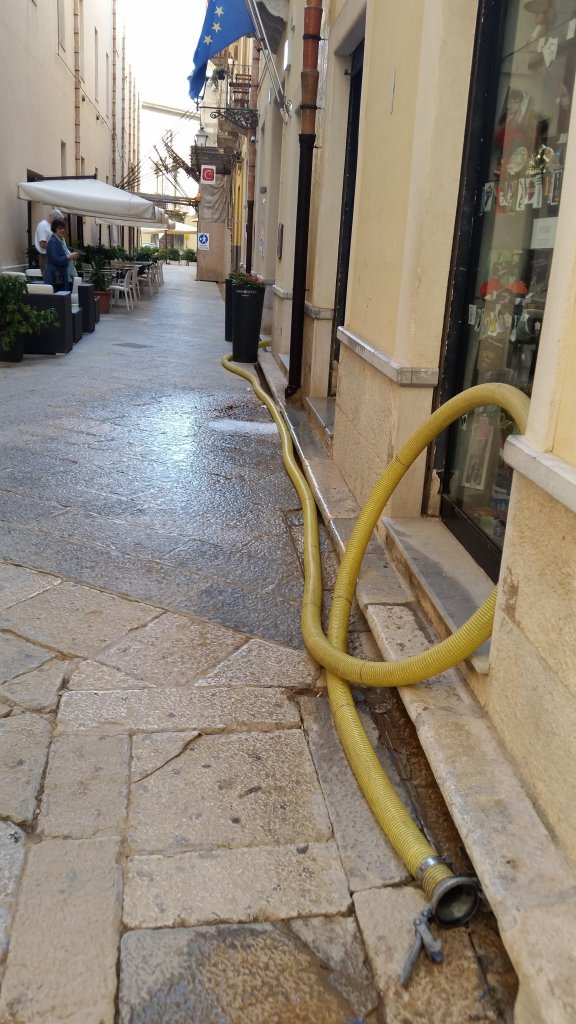
photo by J Zurer
While waiting for the water, Jim and I had a brisk walk to the tip of the little peninsula to the Torre di Ligny, the iconic square watchtower (Spanish, 1671), which houses the well-displayed but teensy collection of nautical artifacts plus two helmets dating from the time of the Second Punic War (3rd cent. BC). It is managed by a cultural association of women called Euploia, which is Greek for “smooth sailing.” The view from the roof was worth the not-too-arduous climb.
I have failed to mention that we have had splendid sunshine and mostly comfortably cool-to-warm temperatures and lots of wind. Remember, the wind around here is one factor in making it suitable for salt production.
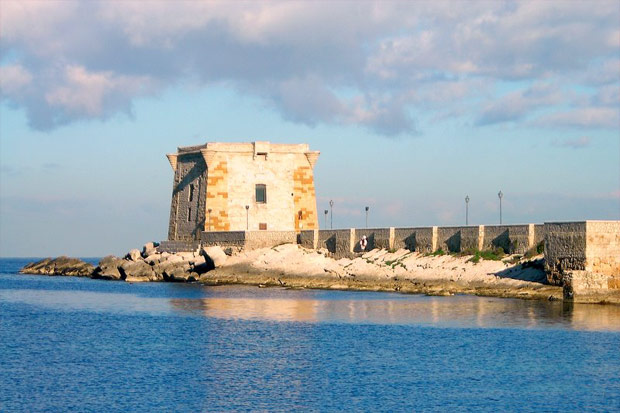
photo from www.hotel-trapani.com

photo from www.vieniatrapani.com
So, having earned our showers, we returned to claim our reward and get spiffed up for the next activity, an expedition to Erice. From the tower we had observed that hilltop Erice (650 m/2133 ft) was enveloped in cloud, and we felt that perhaps it wasn’t the thing. Still, we didn’t have that much time before lunch and we wanted to do something, and Diana had wanted to buy some famous Erice pastries as presents, so we sallied forth and climbed (i.e., drove) up the tortuous half hour (ish) to what is universally regarded as the gem of western Sicily. It’s very pretty, all of gray stone, with little patterns in the cobblestone streets (some sloping enough that the downhill walk was a tad hairy). It was also packed solid with tourists, freezing (the cloud had not lifted), and a lot less charming than I remembered, even though, yes, it really is lovely under the veneer of schlock.
Our main stop was Pasticceria Maria Grammatico, filled with tourists but irresistible nonetheless. Most, if not all, of the sweets were made of almond paste, the pride of Sicily. Jim recognized Sig.ra Grammatico herself, who emerged from the kitchen at some point. Sorry to say, none of us is in a hurry to return to Erice despite fond memories of past visits.
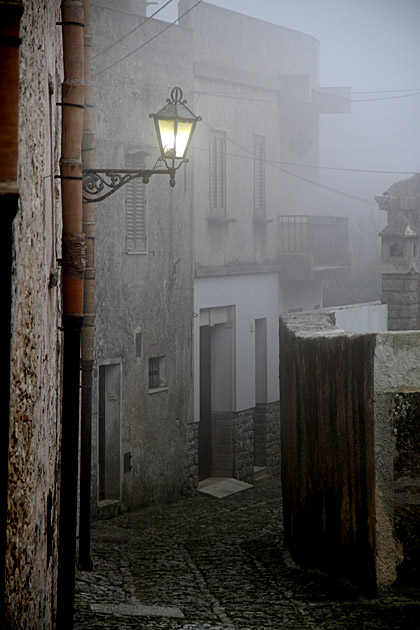
photo from for91days.com

photo from news.com.au
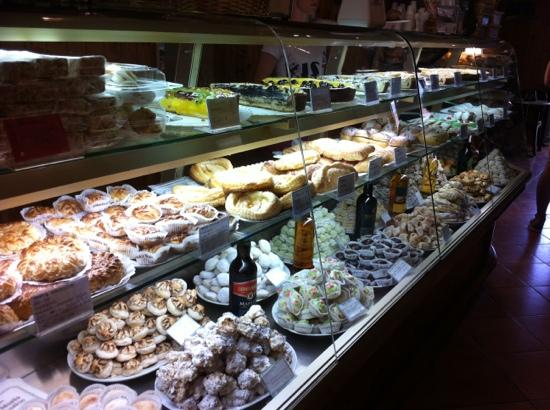
photo from tripadvisor.com
I have to say that most of the rest of the day is lost in a fog of food. From Erice we descended back into the sunshine and drove about 40 minutes inland to an agriturismo called Vultaggio, on the outskirts of Trapani. We arrived late and starving (OK, not literally starving, but very hungry). The setting is rustic (though there is a pretty snappy swimming pool), not in the cozy mountain refuge way but more in the cheap-place-to-take-the-extended-family-on-Sunday way, and everything was translated into the main tourist languages. Nevertheless the menu was one of those gimme-one-of-each types.
Antipasti included excellent salumi from the prestigious Nebrodi pig (for the mountains of that name in eastern Sicily), fine caponata, panelle and chips (just a moment), and a piece of melted caciocavallo served on one of those warming dishes used for bagna caoda in Piedmont. There was also a sort of tripe salad, which Franco and Jim made short work of, all the while saying that trippa alla romana is much better (I have no doubt). Panelle are little rectangles made of chickpea flour, soft on the inside, ever so slight crisp on the outside. They are typically Sicilian but have strong affinities with Ligurian farinata.
Except for Diana’s rather ladylike ravioli with ricotta and pear, the primi were of the why-everybody-loves-rustic type: busiata with very meaty pork ragù or with tomatoes and fresh favas. The secondi were largely grilled meats: excellent pork chops, sausages, and involtini (veal rolls). We drank nero d’avola—what else? (I haven’t been good about recording our wines, but otherwise we always drank Sicilian whites, either grillo or the drier catarratto).
A word about the “chips": seriously? They were perfectly decorous French fries, but served no purpose except to take up room on the plate that could have been given to more panelle. But Jim had pointed out a trend around the Sicilian towns of encroaching chips shops where you might rather see good Sicilian arancini and the like. Globalization among the millennials?
After a pre-siesta by the pool, Jim got us back to base for a more serious rest period. We reassembled well after 8 pm for a walk and found the evening “struscio” in full swing. We detoured into a courtyard where there was a sort of crafts fair, mostly nothing to get the juices flowing. However, one lady, assisted by her pleasant English-speaking son, was selling little pictures made of coral. Diana and I simultaneously zeroed in on these. Diana bought two small gifts which I will not describe in case they are meant to be a surprise.
We concluded our walk with the Scalinata di San Domenico, a stepped side street on which a festival of, let us say, religious art was being held. The center of the street was decorated with a succession of tableaux on religious themes made of various materials including flowers, lots of flowers. You could call this folk art, or you could say, “And you think MY religion is weird?” As we exited at the top, we were asked to make a donation, which Franco, who (of course) had reached the top first, duly did and received two holy cards in return. The holy cards featured Piero della Francesca's Madonna della Misericordia, showing either (a) that church art isn’t all bad or (b) sic transit gloria mundi.
By that time we could face a nightcap at our simpatico but uncomfortable wine bar.
Maureen B. Fant
Elifant Archaeo-Culinary Tours
Day 20: Guest Column: Trapani
Italy 2016: Saturday, May 21:
The day began with a nasty surprise — no water in our hotel — followed by another. The off-hours number provided was not an actual number but the regular number, which was supposed to be forwarded to someone’s cell, only it wasn’t. I mention this not so you’ll feel sorry for us early risers in our unwashed, unflushed, uninformed, and unreassured plight, but so that you will always badger hotels for a proper emergency number if there is nobody on duty 24 hours a day.
By 8-ish we had information that the problem was being dealt with and water would be restored in a "few minutes,” to be understood as “we’re on it, go away.” The few minutes lasted till sometime after 10, which could have been worse. Meanwhile we learned some of the quirks of the local plumbing. You probably don’t care, but I’ll just say the climax of the story was the transfer of water from a truck through a tube that we had to step over to get out the front door.
photo by J Zurer
While waiting for the water, Jim and I had a brisk walk to the tip of the little peninsula to the Torre di Ligny, the iconic square watchtower (Spanish, 1671), which houses the well-displayed but teensy collection of nautical artifacts plus two helmets dating from the time of the Second Punic War (3rd cent. BC). It is managed by a cultural association of women called Euploia, which is Greek for “smooth sailing.” The view from the roof was worth the not-too-arduous climb.
I have failed to mention that we have had splendid sunshine and mostly comfortably cool-to-warm temperatures and lots of wind. Remember, the wind around here is one factor in making it suitable for salt production.

photo from www.hotel-trapani.com
photo from www.vieniatrapani.com
So, having earned our showers, we returned to claim our reward and get spiffed up for the next activity, an expedition to Erice. From the tower we had observed that hilltop Erice (650 m/2133 ft) was enveloped in cloud, and we felt that perhaps it wasn’t the thing. Still, we didn’t have that much time before lunch and we wanted to do something, and Diana had wanted to buy some famous Erice pastries as presents, so we sallied forth and climbed (i.e., drove) up the tortuous half hour (ish) to what is universally regarded as the gem of western Sicily. It’s very pretty, all of gray stone, with little patterns in the cobblestone streets (some sloping enough that the downhill walk was a tad hairy). It was also packed solid with tourists, freezing (the cloud had not lifted), and a lot less charming than I remembered, even though, yes, it really is lovely under the veneer of schlock.
Our main stop was Pasticceria Maria Grammatico, filled with tourists but irresistible nonetheless. Most, if not all, of the sweets were made of almond paste, the pride of Sicily. Jim recognized Sig.ra Grammatico herself, who emerged from the kitchen at some point. Sorry to say, none of us is in a hurry to return to Erice despite fond memories of past visits.

photo from for91days.com

photo from news.com.au

photo from tripadvisor.com
I have to say that most of the rest of the day is lost in a fog of food. From Erice we descended back into the sunshine and drove about 40 minutes inland to an agriturismo called Vultaggio, on the outskirts of Trapani. We arrived late and starving (OK, not literally starving, but very hungry). The setting is rustic (though there is a pretty snappy swimming pool), not in the cozy mountain refuge way but more in the cheap-place-to-take-the-extended-family-on-Sunday way, and everything was translated into the main tourist languages. Nevertheless the menu was one of those gimme-one-of-each types.
Antipasti included excellent salumi from the prestigious Nebrodi pig (for the mountains of that name in eastern Sicily), fine caponata, panelle and chips (just a moment), and a piece of melted caciocavallo served on one of those warming dishes used for bagna caoda in Piedmont. There was also a sort of tripe salad, which Franco and Jim made short work of, all the while saying that trippa alla romana is much better (I have no doubt). Panelle are little rectangles made of chickpea flour, soft on the inside, ever so slight crisp on the outside. They are typically Sicilian but have strong affinities with Ligurian farinata.
Except for Diana’s rather ladylike ravioli with ricotta and pear, the primi were of the why-everybody-loves-rustic type: busiata with very meaty pork ragù or with tomatoes and fresh favas. The secondi were largely grilled meats: excellent pork chops, sausages, and involtini (veal rolls). We drank nero d’avola—what else? (I haven’t been good about recording our wines, but otherwise we always drank Sicilian whites, either grillo or the drier catarratto).
A word about the “chips": seriously? They were perfectly decorous French fries, but served no purpose except to take up room on the plate that could have been given to more panelle. But Jim had pointed out a trend around the Sicilian towns of encroaching chips shops where you might rather see good Sicilian arancini and the like. Globalization among the millennials?
After a pre-siesta by the pool, Jim got us back to base for a more serious rest period. We reassembled well after 8 pm for a walk and found the evening “struscio” in full swing. We detoured into a courtyard where there was a sort of crafts fair, mostly nothing to get the juices flowing. However, one lady, assisted by her pleasant English-speaking son, was selling little pictures made of coral. Diana and I simultaneously zeroed in on these. Diana bought two small gifts which I will not describe in case they are meant to be a surprise.
We concluded our walk with the Scalinata di San Domenico, a stepped side street on which a festival of, let us say, religious art was being held. The center of the street was decorated with a succession of tableaux on religious themes made of various materials including flowers, lots of flowers. You could call this folk art, or you could say, “And you think MY religion is weird?” As we exited at the top, we were asked to make a donation, which Franco, who (of course) had reached the top first, duly did and received two holy cards in return. The holy cards featured Piero della Francesca's Madonna della Misericordia, showing either (a) that church art isn’t all bad or (b) sic transit gloria mundi.
By that time we could face a nightcap at our simpatico but uncomfortable wine bar.
Maureen B. Fant
Elifant Archaeo-Culinary Tours
Pauline
Forums Admin
When we did our trip we spent 3 nights in Sciacca, but did not see much of the town (which I regret). We used it as a base to see Selinunte one day and that other Greek temple and theater closer to Palermo the other day. We stayed in a complex of vacation apartments just outside the center.
One thing I remember about traveling in Sicily is the parking. Towns don't seem to have parking lots. You drive through mile after mile of countryside, then you are in a town and you can't park. Every street spot is taken, no paid car parks. I remember reading a book about someone traveling in Sicily and they just drove around towns endlessly looking for parking, then leaving.
One thing I remember about traveling in Sicily is the parking. Towns don't seem to have parking lots. You drive through mile after mile of countryside, then you are in a town and you can't park. Every street spot is taken, no paid car parks. I remember reading a book about someone traveling in Sicily and they just drove around towns endlessly looking for parking, then leaving.
Parking is a bit hit and miss in Sicily....although Trapani has a gigantic free public lot just outside the centro storico that we used. It was a ten minute walk from the hotel we stayed at. Siracusa also has a big parking garage (pay) on the north side of the island where you can stash your car for Euro 10.00 a day.
But it is a bit of challenge in many places to even scope out the areas where you can pay for parking and then, if there are no "parcometri", you have figure out where to buy parking cards. Once we figured it out here in Cefalu', it was easy to drive to the center and park.
But for a quick drive through and look see, it can be difficult.
But it is a bit of challenge in many places to even scope out the areas where you can pay for parking and then, if there are no "parcometri", you have figure out where to buy parking cards. Once we figured it out here in Cefalu', it was easy to drive to the center and park.
But for a quick drive through and look see, it can be difficult.
Day 21: Trapani-Cefalu
Italy 2016: Sunday May 22
As we are checking out of the hotel on another sunny and warm day, I ask the woman at the desk about getting compensated for the lack of water the day before. At first, she seems confused. I suggest that we might not be charged for our breakfasts. This is above her pay grade so she sends a message to her boss. We wait each other out and finally she calls the boss, relays our request and he agrees. A small victory.....
Before leaving Trapani, we pay a visit to the big regional museum at the Villa Pepoli located in a commercial neighborhood in the modern town. The museum is housed in an old Carmelite monastery
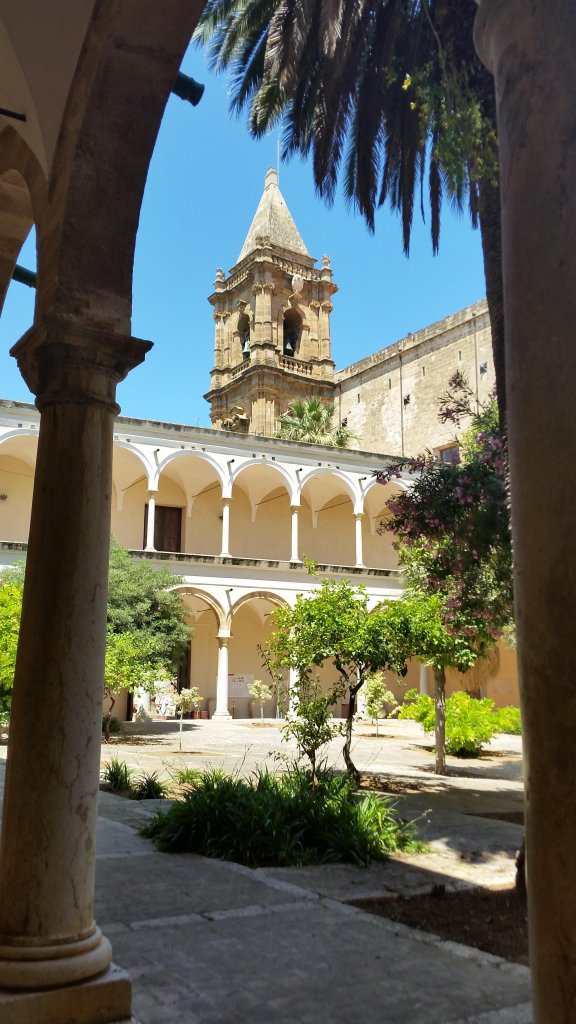
photo by J Zurer
and has an eclectic collection of holdings - paintings, jewelry, handicrafts, etc....some of more interest than others. Some of the pieces that attract our attention.....
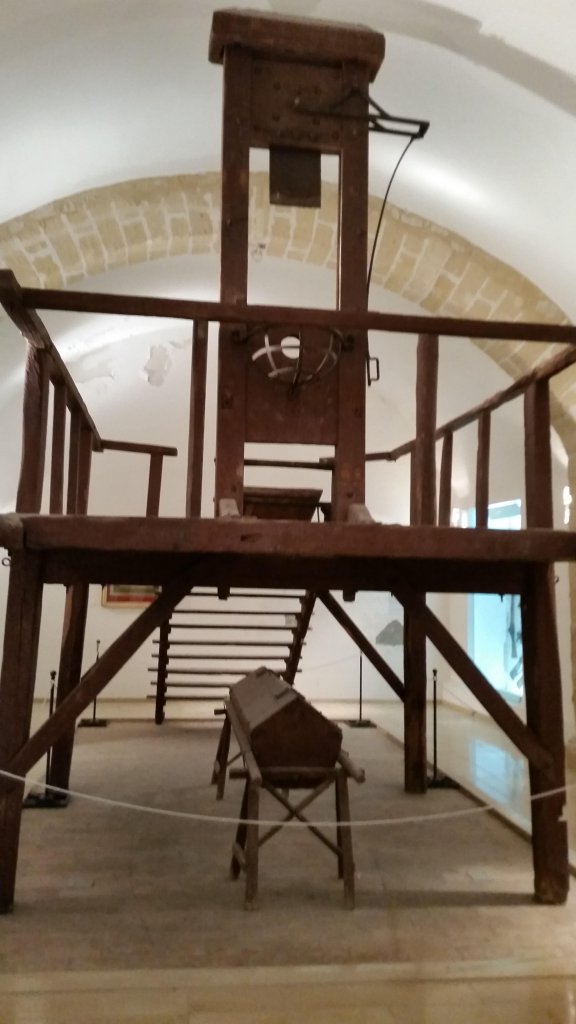
photo by J Zurer
a guillotine
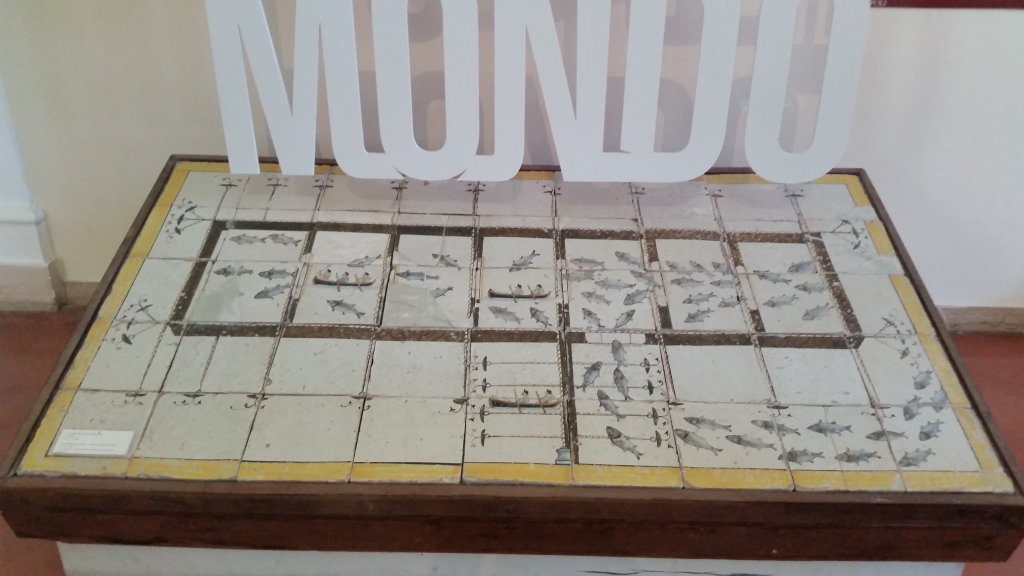
photo by J Zurer
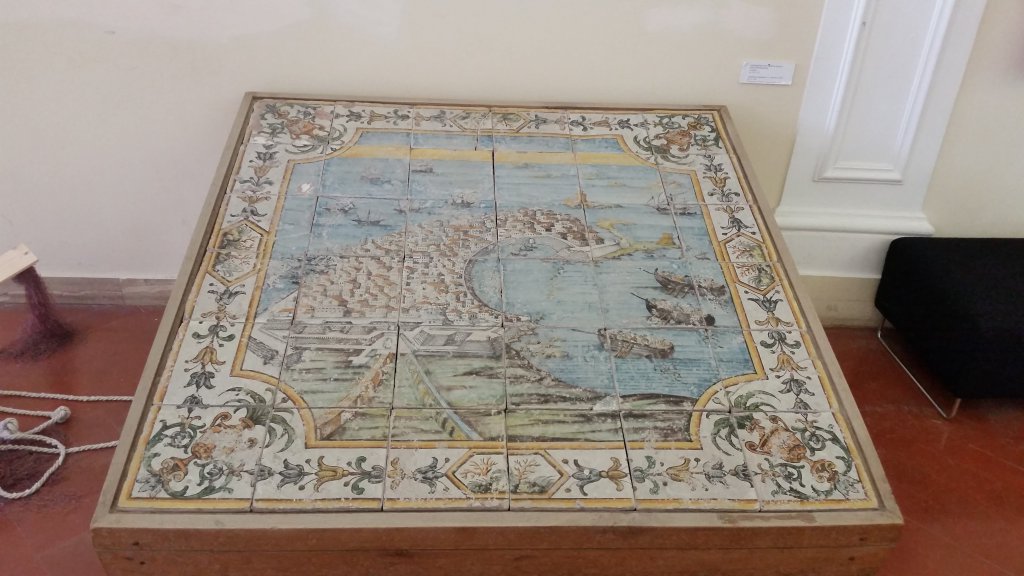
photo by J Zurer
some beautiful tile floors from churches around town
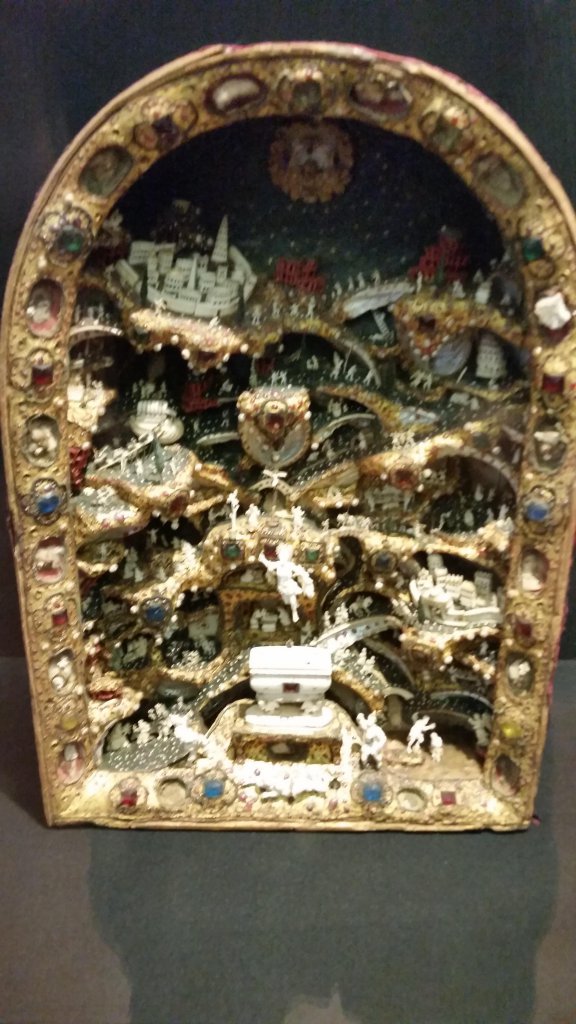
photo by J Zurer
an amazingly intricate carved piece showing Biblical scenes...Abraham and the sacrifice of Isaac is at the bottom left.
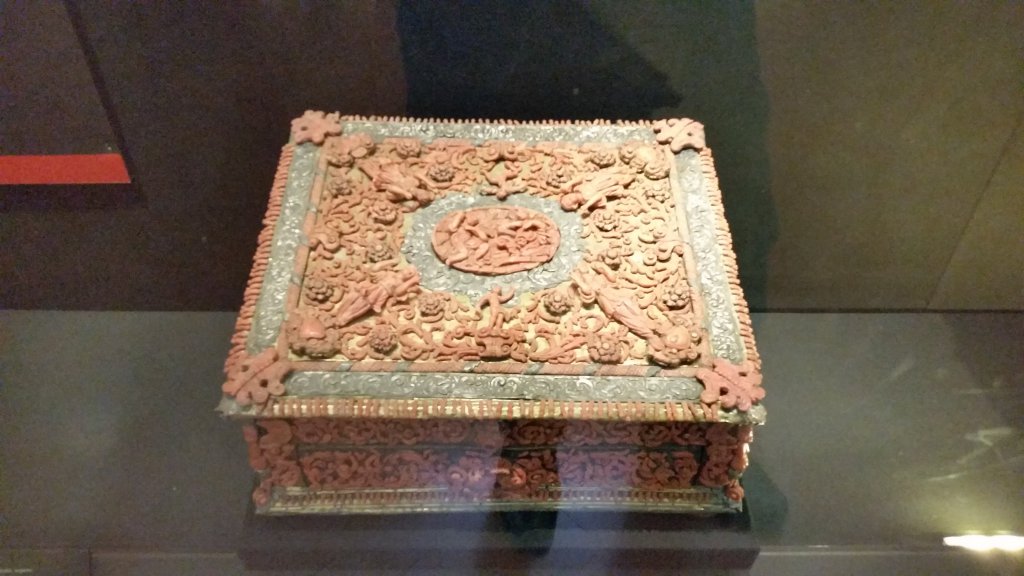
photo by J Zurer
a box with local coral decorations
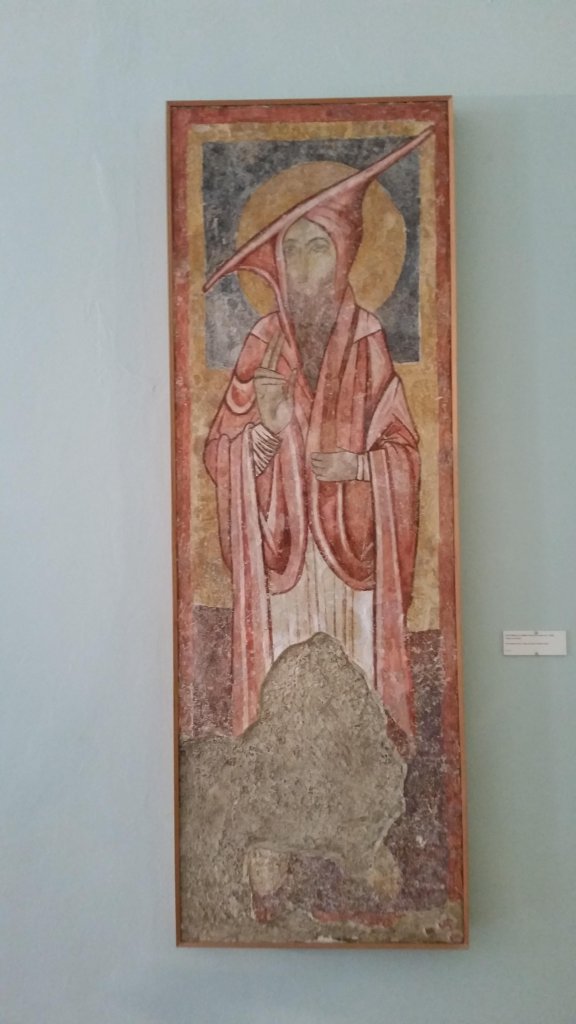
photo by J Zurer
and a very unique painting of a saint with a funny hat that particularly appealed to me.
After a couple of hours, we leave Trapani for lunch in Castellammare del Golfo which is on the way to the Palermo airport. We make a short detour to see the small town of Scopello with its rocky coastline and old tuna fishery.

photo from supercoolbeaches.com
Maureen has chosen a restaurant from the Gambero Rosso guide which is located in a residential section of Castellammare del Golfo...with no view of the water but excellent seafood;

photo from autonoleggiosanvito.it
the clients appear to be mostly Italians out for their big Sunday dinner. The waiter is a young man who is exemplifies the best qualities of Italian waiters...knowledgeable, personable and helpful. I won't try to enumerate all the dishes we ate but we ate a lot.....and most of it was excellent. I have to confess that my choices (marinated raw shrimp and baccala served with a puree of chickpeas) were not as good as those of the rest of the party who seemed to enjoy everything on their plates.
After we say goodbye to Franco and Maureen, we drive on to Cefalu, a beach town an hour east of Palermo where we will stay for the next four nights....another "vacation from our vacation". We find the hotel, check in and enjoy the view from our room. The hotel is beautifully sited, overlooking a cove and the sea.
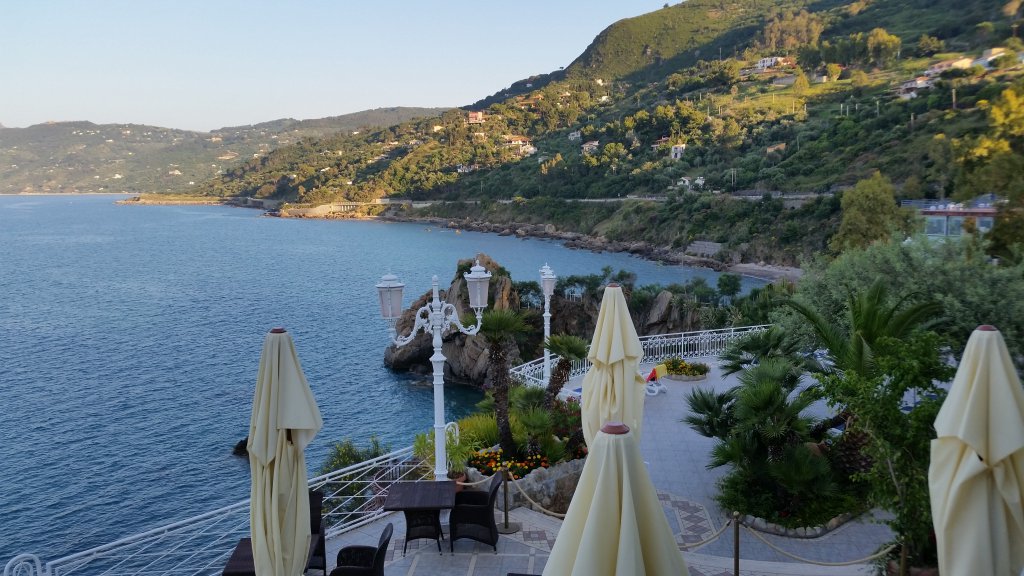
photo by J Zurer
Not being too hungry for dinner, we take the car out and try to get to the center to look around and maybe get a prosecco. Since it was Sunday night, the first two roads we take are blocked off to car traffic but we maneuver to the far side of town and find a place to park. I have to find a place that sells the parking cards....no parking meters; you buy a card for an hour at a time, scratch off the date and the hour you parked and place it on your dashboard.
Here are similar cards from Noto....
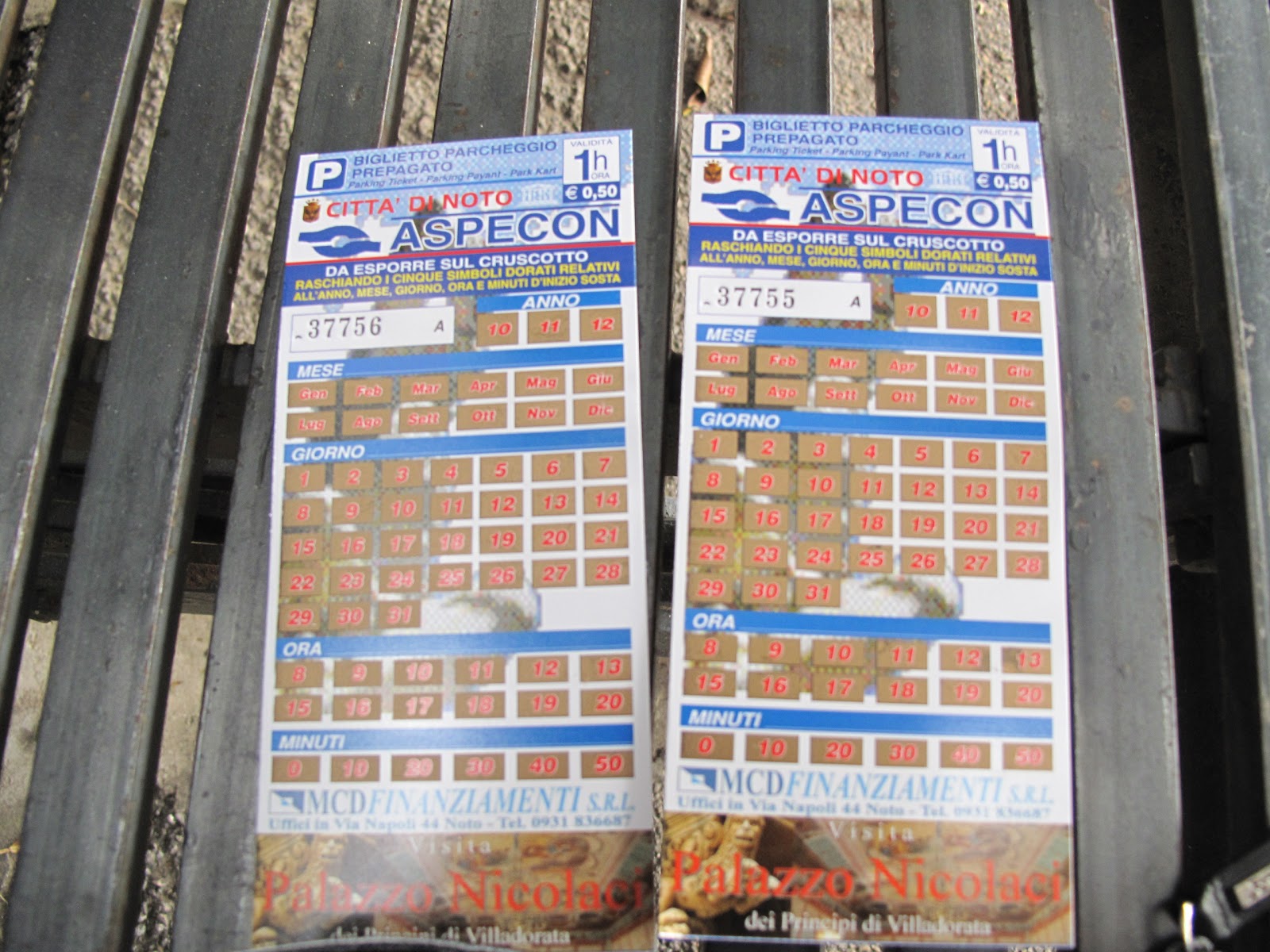
photo from blogspot.com
We decide to sit down in an outdoor cafe overlooking the water and have a light dinner...sandwich and a glass of wine..and then back to the hotel for the night.
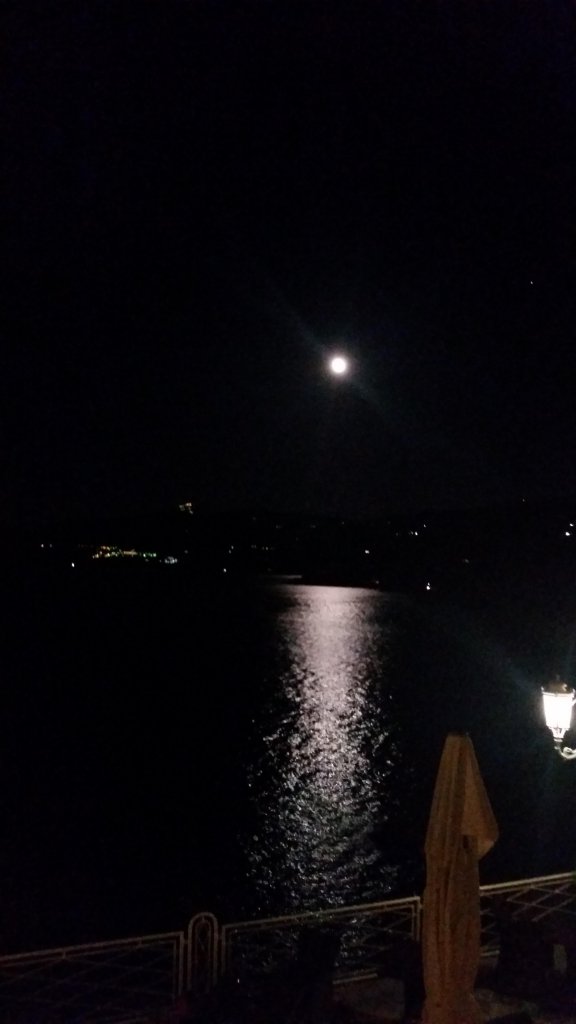
photo by J Zurer
Tomorrow....relaxing and maybe a visit to the Duomo in Cefalu.
Jim and Diana
Italy 2016: Sunday May 22
As we are checking out of the hotel on another sunny and warm day, I ask the woman at the desk about getting compensated for the lack of water the day before. At first, she seems confused. I suggest that we might not be charged for our breakfasts. This is above her pay grade so she sends a message to her boss. We wait each other out and finally she calls the boss, relays our request and he agrees. A small victory.....
Before leaving Trapani, we pay a visit to the big regional museum at the Villa Pepoli located in a commercial neighborhood in the modern town. The museum is housed in an old Carmelite monastery
photo by J Zurer
and has an eclectic collection of holdings - paintings, jewelry, handicrafts, etc....some of more interest than others. Some of the pieces that attract our attention.....
photo by J Zurer
a guillotine
photo by J Zurer
photo by J Zurer
some beautiful tile floors from churches around town
photo by J Zurer
an amazingly intricate carved piece showing Biblical scenes...Abraham and the sacrifice of Isaac is at the bottom left.
photo by J Zurer
a box with local coral decorations
photo by J Zurer
and a very unique painting of a saint with a funny hat that particularly appealed to me.
After a couple of hours, we leave Trapani for lunch in Castellammare del Golfo which is on the way to the Palermo airport. We make a short detour to see the small town of Scopello with its rocky coastline and old tuna fishery.

photo from supercoolbeaches.com
Maureen has chosen a restaurant from the Gambero Rosso guide which is located in a residential section of Castellammare del Golfo...with no view of the water but excellent seafood;

photo from autonoleggiosanvito.it
the clients appear to be mostly Italians out for their big Sunday dinner. The waiter is a young man who is exemplifies the best qualities of Italian waiters...knowledgeable, personable and helpful. I won't try to enumerate all the dishes we ate but we ate a lot.....and most of it was excellent. I have to confess that my choices (marinated raw shrimp and baccala served with a puree of chickpeas) were not as good as those of the rest of the party who seemed to enjoy everything on their plates.
After we say goodbye to Franco and Maureen, we drive on to Cefalu, a beach town an hour east of Palermo where we will stay for the next four nights....another "vacation from our vacation". We find the hotel, check in and enjoy the view from our room. The hotel is beautifully sited, overlooking a cove and the sea.
photo by J Zurer
Not being too hungry for dinner, we take the car out and try to get to the center to look around and maybe get a prosecco. Since it was Sunday night, the first two roads we take are blocked off to car traffic but we maneuver to the far side of town and find a place to park. I have to find a place that sells the parking cards....no parking meters; you buy a card for an hour at a time, scratch off the date and the hour you parked and place it on your dashboard.
Here are similar cards from Noto....
photo from blogspot.com
We decide to sit down in an outdoor cafe overlooking the water and have a light dinner...sandwich and a glass of wine..and then back to the hotel for the night.
photo by J Zurer
Tomorrow....relaxing and maybe a visit to the Duomo in Cefalu.
Jim and Diana
Last edited:
Day 22-26: Cefalu (Part 1)
Italy 2016: Monday May 23 to Thursday, May 27
In the interest of catching up and because this part of the trip was designed as our "vacation from our vacation", I am going to report on our four days in Cefalu in one post.
We are staying at the Hotel Kalura, a big resort hotel favored by German tourists, located on a rocky outcropping about a mile outside the town.

photo from www.hotel-kalura.com
It is beautifully sited with lots of public space (outdoor and indoor),
<image missing>

a swimming pool and a "beach"--in reality, a concrete swimming platform located at the bottom of a stairway of about one hundred steps.
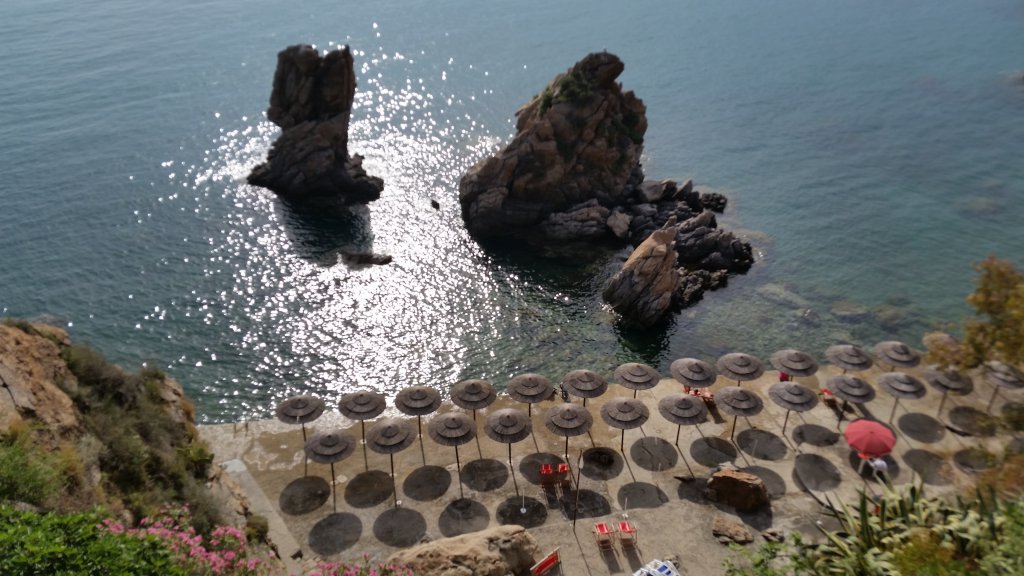
photo by J Zurer

photo from be-better.eu
We spend a lot of time on the terrace....eating breakfast, quilting and enjoying the beautiful weather and the view.
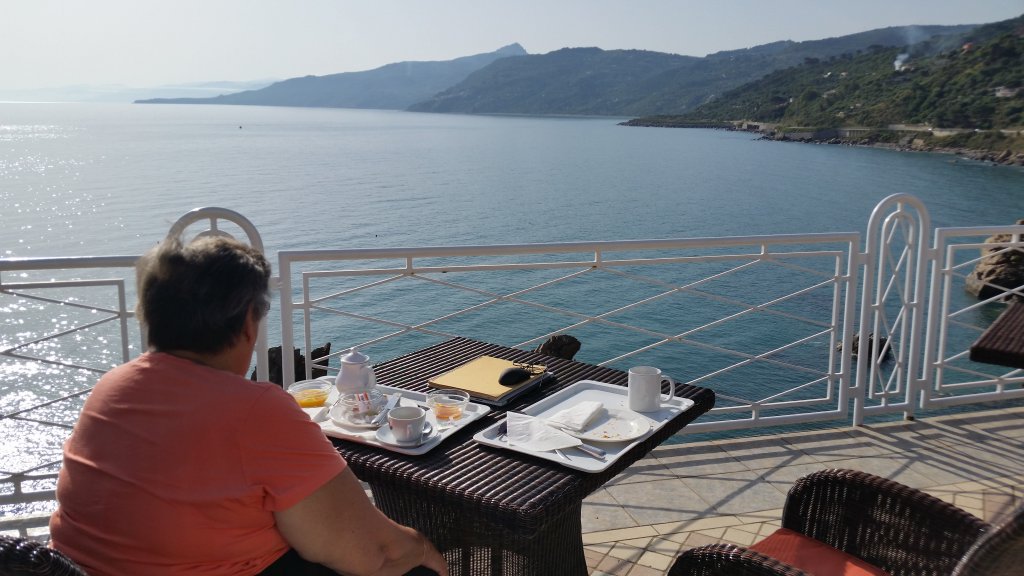
photo by J Zurer
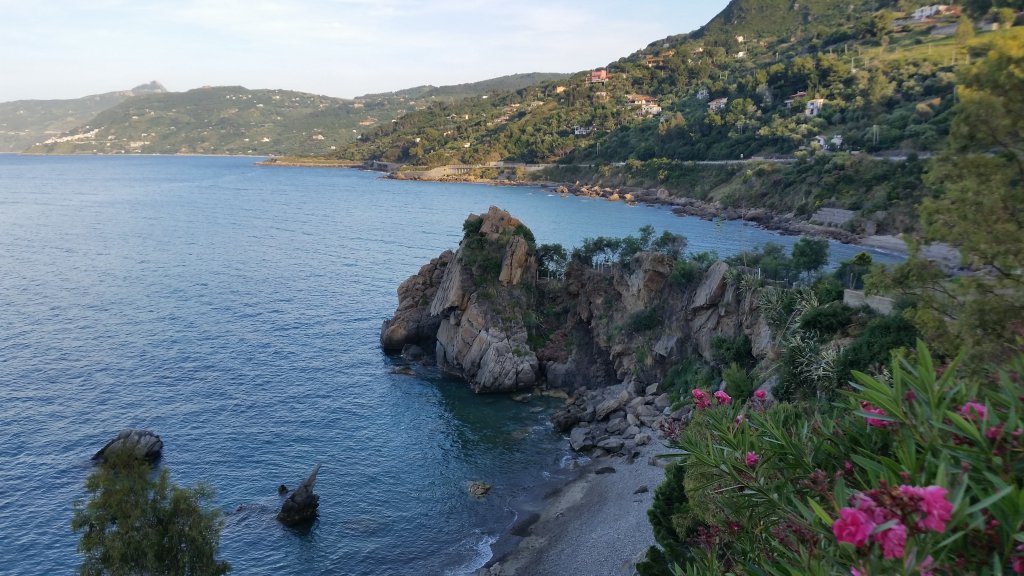
photo by J Zurer
We make several excursions to town....a visit to the 12th century Duomo in the town, located under the big rock that dominates the town.
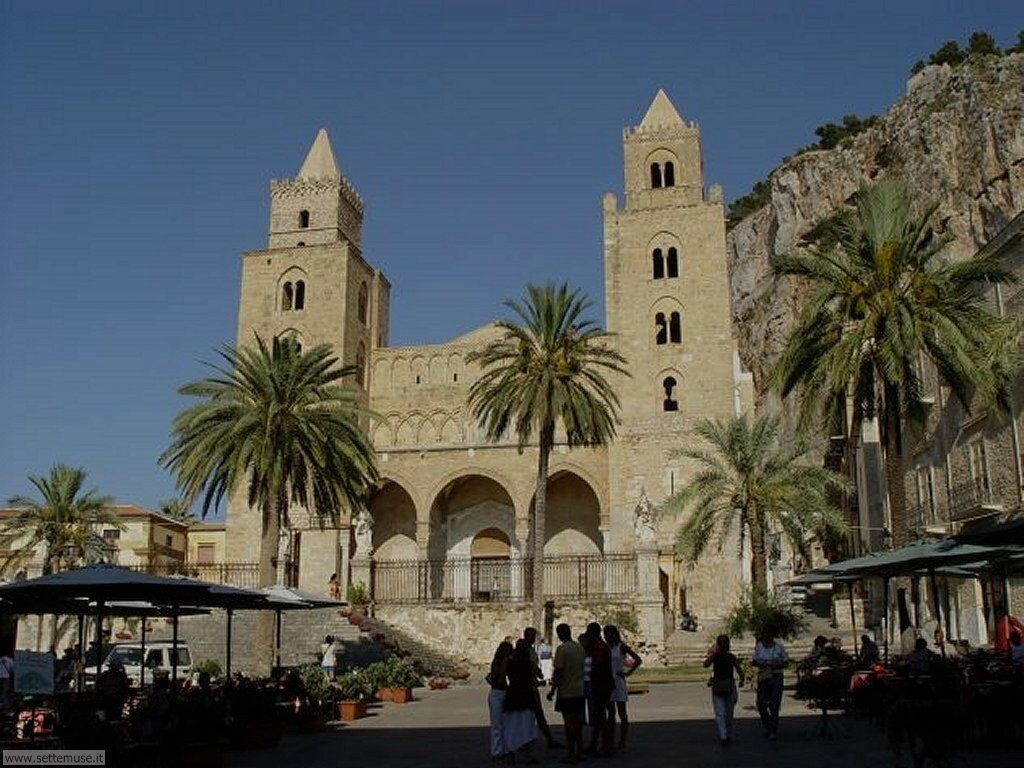
photo from www.settemuse.it
The cathedral is famous for the amazing mosaic of Christ and the apostles in the apse....one of the most refined and vibrant of the mosaics from the period of Norman rule in Sicily.
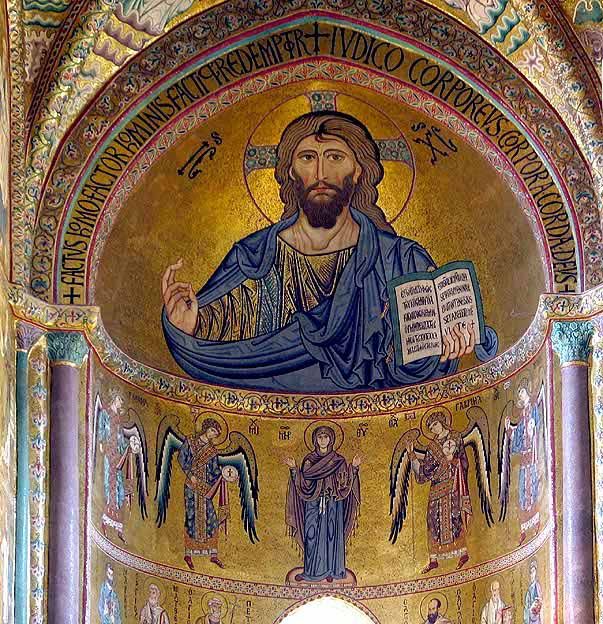
photo from pinimg.com
Italy 2016: Monday May 23 to Thursday, May 27
In the interest of catching up and because this part of the trip was designed as our "vacation from our vacation", I am going to report on our four days in Cefalu in one post.
We are staying at the Hotel Kalura, a big resort hotel favored by German tourists, located on a rocky outcropping about a mile outside the town.

photo from www.hotel-kalura.com
It is beautifully sited with lots of public space (outdoor and indoor),
<image missing>

a swimming pool and a "beach"--in reality, a concrete swimming platform located at the bottom of a stairway of about one hundred steps.
photo by J Zurer

photo from be-better.eu
We spend a lot of time on the terrace....eating breakfast, quilting and enjoying the beautiful weather and the view.
photo by J Zurer
photo by J Zurer
We make several excursions to town....a visit to the 12th century Duomo in the town, located under the big rock that dominates the town.

photo from www.settemuse.it
The cathedral is famous for the amazing mosaic of Christ and the apostles in the apse....one of the most refined and vibrant of the mosaics from the period of Norman rule in Sicily.

photo from pinimg.com
Day 22-25: Cefalu (Part 2)
Italy 2016: Monday May 23 to Thursday, May 26
The adjoining cloister is decorated with columns carved with various biblical scenes as well as animals and plants...it served as the model for the later, more famous cloister at Monreale, outside Palermo.
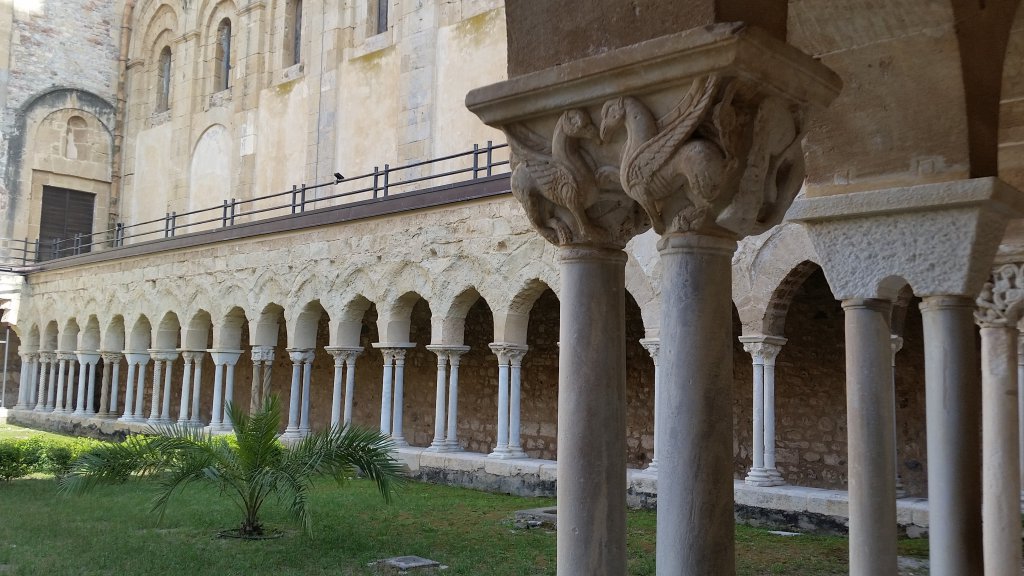
photo by J Zurer
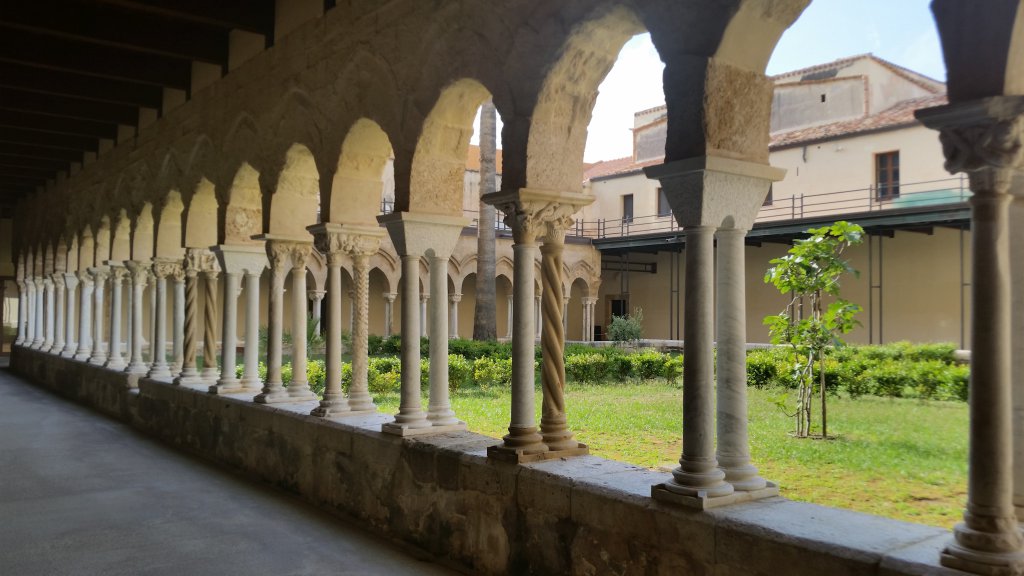
photo by J Zurer
Another day we visited the Mandrisca Museum, one of the many small museums of Italy with eclectic but interesting holdings. Here there is one certified masterpiece...a wonderful 15th century portrait of an unknown man by the Sicilian artist Antonello di Messina (whose work we had seen in the art museum in Siracusa earlier in the trip.)
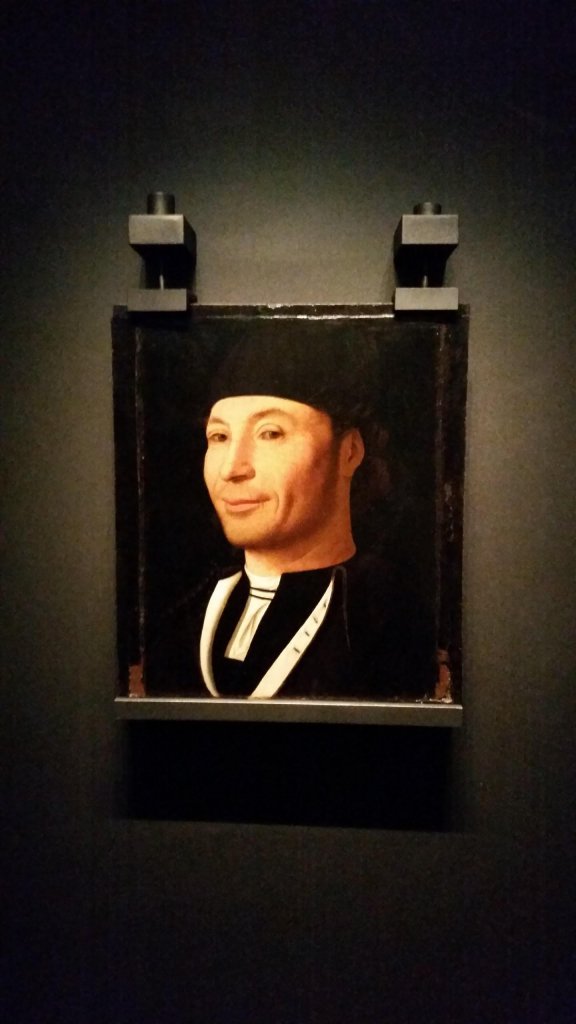
photo by J Zurer
But there are other things that attract our interest as well....
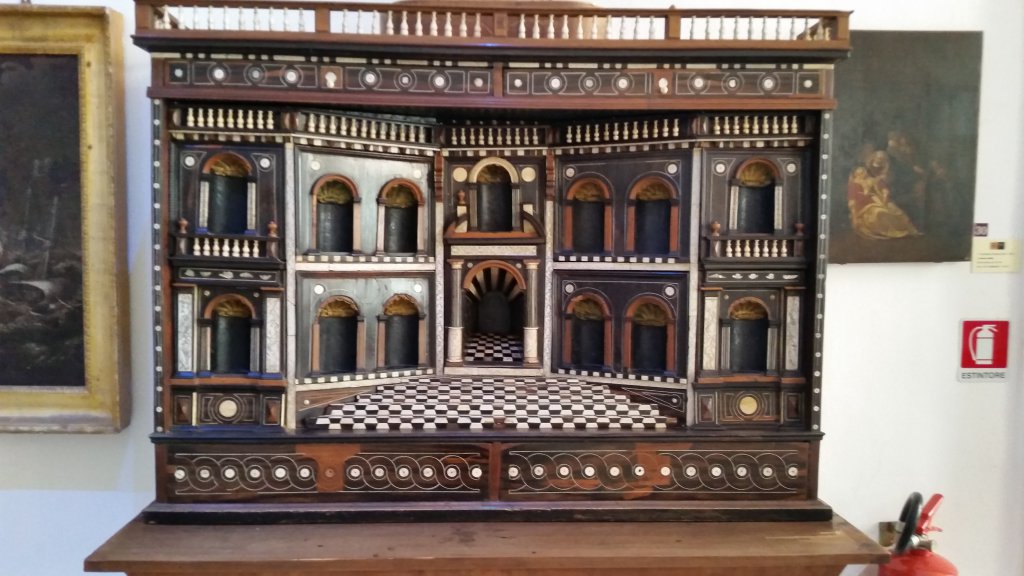
photo by J Zurer
an inlaid cabinet that shows a theater backdrop reminiscent of the Palladian theater in Vicenza
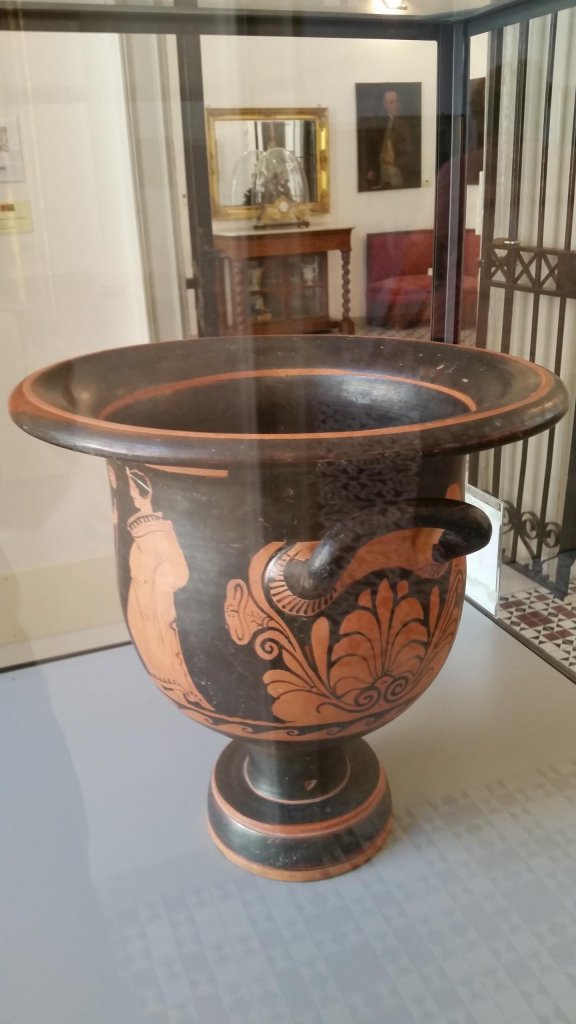
photo by J Zurer
another remarkable Greek vase from the 4th century BC
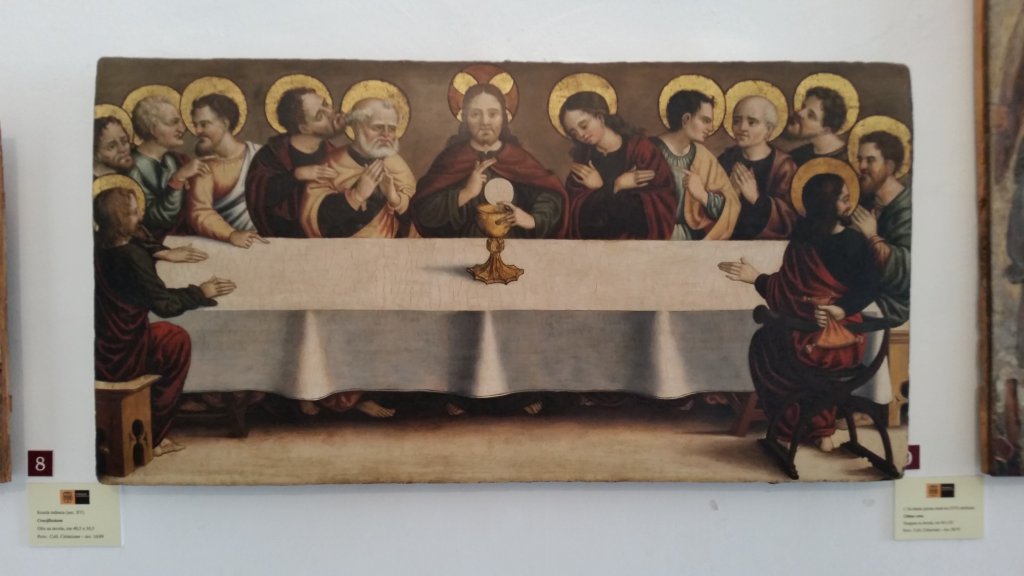
photo by J Zurer
and another Last Supper for my "collection." Can you tell who is the bad guy?
Another day we drive up into the mountains above Cefalu to the very pretty town of Castelbuono...

photo from www.discoverymadonie.com
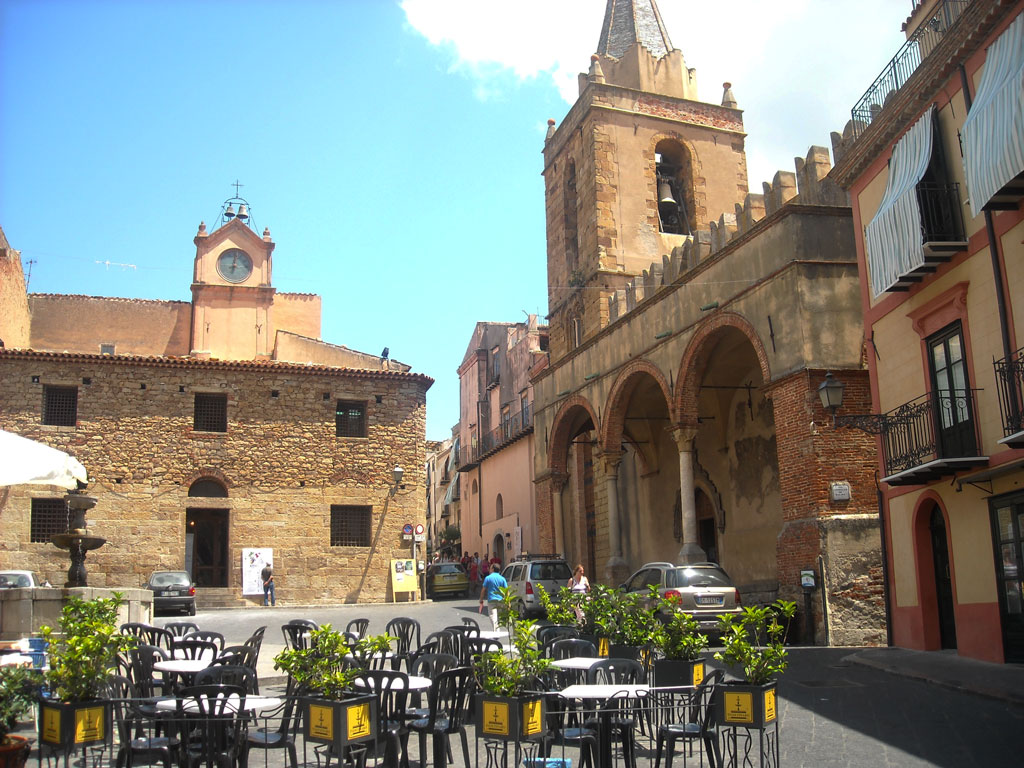
photo from www.visitsicily.info
It is a pretty drive with lovely mountain scenery coming into view at every turn.
We make a circuit of the town trying to find parking near the center and, after the obligatory false starts, find a legal parking space near the post office which is very convenient to the "centro storico". We are looking for some containers to transport the capers we bought at the market in Siracusa so we stop in a very attractive store that has some kitchenware in the window. The owners of the store are very accommodating, bring out several types of containers and we buy a couple. Then Diana takes a cursory look around the shop which has lovely textiles as well as kitchenware and gifts. She is attracted by a tapestry that the owners say is connected to the character of Tancredi in "Il Gattopardo" and we end up buying it for her as her birthday present.
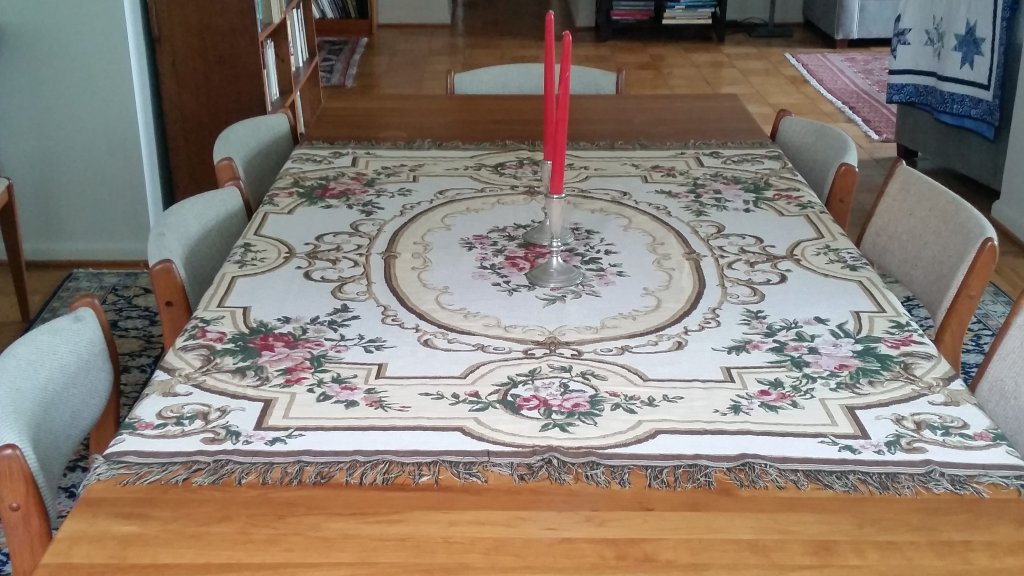
photo by J Zurer
It is now on our dining room table.
Castelbuono is also the center of the production of manna in Sicily and many shops feature it as an ingredient in candy, cakes and ice cream. It is harvested by tapping narrow leaf ash trees, similar to the process of tapping maple trees for syrup. We do buy a box of a candy for a gift but don't have a chance to sample any. Here is a link to a blog post that gives a lot more information about it. https://siciliangodmother.com/2012/09/14/manna-from-heaven-or-from-sicily/
We have a wild goose chase to find a restaurant for lunch. We drive further up the mountain but it turns out that the Slow Food recommended restaurant has closed even though we had called the listed number and made a "reservation." We end up coming back down to town and parking in the same space we had left. We have lunch at a new restaurant (La Tana del Volpe) steps from the parking lot...where we are the only customers. The host is charming with some English (he had spent a couple of months with family in New Jersey) and lunch is fine....but not memorable.
We have one other memorable expedition into Cefalu....driving into town along the water, we enter the center on the Via del Giudecca which takes us into the heart of the old city. The streets are narrow with few other cars and lots of pedestrians. We are not sure where we will end up and hope that we don't have to turn around and retrace our route. It's a bit hair-raising but eventually we pop out in the same street where we had parked on our first night in Cefalu.
So that covers our four nights in Cefalu...we ended up enjoying the town a lot in spite of its being a bit touristy. But once we figured out where to park, it was pretty easy to go back and forth. We ate at the hotel for one lunch and one dinner and the food was very good, especially the grilled fish, although the service left a bit to be desired. One of our dinners was a gelato (after our late lunch in Castelbuono) and the other was at a place called TiVitti, named after a Sicilian card game. We have unmemorable pasta dishes...my spaghetti alle vongole is just okay...but the grilled fish are very good.
Our next stop will be Castel di Tusa, just 30 minutes east of Cefalu.
Jim and Diana
Italy 2016: Monday May 23 to Thursday, May 26
The adjoining cloister is decorated with columns carved with various biblical scenes as well as animals and plants...it served as the model for the later, more famous cloister at Monreale, outside Palermo.
photo by J Zurer
photo by J Zurer
Another day we visited the Mandrisca Museum, one of the many small museums of Italy with eclectic but interesting holdings. Here there is one certified masterpiece...a wonderful 15th century portrait of an unknown man by the Sicilian artist Antonello di Messina (whose work we had seen in the art museum in Siracusa earlier in the trip.)
photo by J Zurer
But there are other things that attract our interest as well....
photo by J Zurer
an inlaid cabinet that shows a theater backdrop reminiscent of the Palladian theater in Vicenza
photo by J Zurer
another remarkable Greek vase from the 4th century BC
photo by J Zurer
and another Last Supper for my "collection." Can you tell who is the bad guy?
Another day we drive up into the mountains above Cefalu to the very pretty town of Castelbuono...

photo from www.discoverymadonie.com

photo from www.visitsicily.info
It is a pretty drive with lovely mountain scenery coming into view at every turn.
We make a circuit of the town trying to find parking near the center and, after the obligatory false starts, find a legal parking space near the post office which is very convenient to the "centro storico". We are looking for some containers to transport the capers we bought at the market in Siracusa so we stop in a very attractive store that has some kitchenware in the window. The owners of the store are very accommodating, bring out several types of containers and we buy a couple. Then Diana takes a cursory look around the shop which has lovely textiles as well as kitchenware and gifts. She is attracted by a tapestry that the owners say is connected to the character of Tancredi in "Il Gattopardo" and we end up buying it for her as her birthday present.
photo by J Zurer
It is now on our dining room table.
Castelbuono is also the center of the production of manna in Sicily and many shops feature it as an ingredient in candy, cakes and ice cream. It is harvested by tapping narrow leaf ash trees, similar to the process of tapping maple trees for syrup. We do buy a box of a candy for a gift but don't have a chance to sample any. Here is a link to a blog post that gives a lot more information about it. https://siciliangodmother.com/2012/09/14/manna-from-heaven-or-from-sicily/
We have a wild goose chase to find a restaurant for lunch. We drive further up the mountain but it turns out that the Slow Food recommended restaurant has closed even though we had called the listed number and made a "reservation." We end up coming back down to town and parking in the same space we had left. We have lunch at a new restaurant (La Tana del Volpe) steps from the parking lot...where we are the only customers. The host is charming with some English (he had spent a couple of months with family in New Jersey) and lunch is fine....but not memorable.
We have one other memorable expedition into Cefalu....driving into town along the water, we enter the center on the Via del Giudecca which takes us into the heart of the old city. The streets are narrow with few other cars and lots of pedestrians. We are not sure where we will end up and hope that we don't have to turn around and retrace our route. It's a bit hair-raising but eventually we pop out in the same street where we had parked on our first night in Cefalu.
So that covers our four nights in Cefalu...we ended up enjoying the town a lot in spite of its being a bit touristy. But once we figured out where to park, it was pretty easy to go back and forth. We ate at the hotel for one lunch and one dinner and the food was very good, especially the grilled fish, although the service left a bit to be desired. One of our dinners was a gelato (after our late lunch in Castelbuono) and the other was at a place called TiVitti, named after a Sicilian card game. We have unmemorable pasta dishes...my spaghetti alle vongole is just okay...but the grilled fish are very good.
Our next stop will be Castel di Tusa, just 30 minutes east of Cefalu.
Jim and Diana
Last edited:
Here is the next installment of Diana's reading list from this trip.
For those interested in what I read the last few weeks in Italy:
Brother of the More Famous Jack by Barbara Trapido. This 1982 debut novel by a South African writer who lives in England, was recommended in the Sunday NY Times' By The Book column by a writer whose name I don't remember but whose favorite author was Philip Roth. It took me a while to get into, with its too clever and oh-so-self aware characters and some flippant anti-Semitic stereotypes. But as we follow the heroine Katherine in her encounters with members of the Goldman family, her misfortunes and then her re-connection with the Goldmans, she becomes a compelling figure. This is a sort of feminist, coming of age novel.
Little Novels of Sicily by Giovanni Verga. Translated by D H Lawrence, first published in 1883. Verga, from Catania, describes his home when Sicily was desperately poor. This collection of stories about oppressed, pious peasants, corrupt priests, and members of the gentry was essential reading for this trip. My favorite story may have been the one with an ass (the animal) as the ostensible main character. I'm a little embarrassed to say, but I queried Lawrence's language sometimes - awkward sentences, I thought. Toward the end of the book there's a very powerful story called Liberty, based on an actual event. Poor people go on a killing spree, murdering members of the hat wearing gentry and their families. (All other men wore stocking-like caps.) The savage blood-letting is prompted by news of Garibaldi's imminent arrival, but when he does come, some of the perpetrators are imprisoned, tried and hung. The last line is: "Where are you taking me? To the galleys? Oh, why? I never got so much as half a yard of land. If they'd told me what liberty was like - !"
The Master by Colm Toibin. For my book group, though I missed the May discussion. I thought it was great. A novel about Henry James, that focuses on 4 years of his life, his writing and his family. At first I thought it was going to be all about his repressed homosexuality, but although that does come up again in the book, the main themes are how all of his life informs his writing. All aspects of his life and relationships, in America, England, Ireland and Italy are explored and what sort of a man and writer James is becomes revealed. Toibin uses James' words without quotation marks and also puts words into his mouth and thoughts into his head, but it all works beautifully. You don't have to know or love Henry James' work to love this book. If you do, it's a bonus but I'd recommend The Master to everyone.
For those interested in what I read the last few weeks in Italy:
Brother of the More Famous Jack by Barbara Trapido. This 1982 debut novel by a South African writer who lives in England, was recommended in the Sunday NY Times' By The Book column by a writer whose name I don't remember but whose favorite author was Philip Roth. It took me a while to get into, with its too clever and oh-so-self aware characters and some flippant anti-Semitic stereotypes. But as we follow the heroine Katherine in her encounters with members of the Goldman family, her misfortunes and then her re-connection with the Goldmans, she becomes a compelling figure. This is a sort of feminist, coming of age novel.
Little Novels of Sicily by Giovanni Verga. Translated by D H Lawrence, first published in 1883. Verga, from Catania, describes his home when Sicily was desperately poor. This collection of stories about oppressed, pious peasants, corrupt priests, and members of the gentry was essential reading for this trip. My favorite story may have been the one with an ass (the animal) as the ostensible main character. I'm a little embarrassed to say, but I queried Lawrence's language sometimes - awkward sentences, I thought. Toward the end of the book there's a very powerful story called Liberty, based on an actual event. Poor people go on a killing spree, murdering members of the hat wearing gentry and their families. (All other men wore stocking-like caps.) The savage blood-letting is prompted by news of Garibaldi's imminent arrival, but when he does come, some of the perpetrators are imprisoned, tried and hung. The last line is: "Where are you taking me? To the galleys? Oh, why? I never got so much as half a yard of land. If they'd told me what liberty was like - !"
The Master by Colm Toibin. For my book group, though I missed the May discussion. I thought it was great. A novel about Henry James, that focuses on 4 years of his life, his writing and his family. At first I thought it was going to be all about his repressed homosexuality, but although that does come up again in the book, the main themes are how all of his life informs his writing. All aspects of his life and relationships, in America, England, Ireland and Italy are explored and what sort of a man and writer James is becomes revealed. Toibin uses James' words without quotation marks and also puts words into his mouth and thoughts into his head, but it all works beautifully. You don't have to know or love Henry James' work to love this book. If you do, it's a bonus but I'd recommend The Master to everyone.
The Final Days: Castel di Tusa/Reggio Calabria/Santa Maria di Castellabate/Fregene
Italy 2016: May 26-June 1
We are home and I want to briefly recap the last part of our trip.
Day 25 - Castel di Tusa
Thursday, May 26
We left Cefalu and drove 30 minutes east to the small fishing village of Castel di Tusa in order to stay at a hotel that I had read about for many years. The Atelier sul Mare is more a modern art installation and political statement than just a hotel....twenty of the bedrooms were designed by modern artists who were encouraged to make artistic statements. The lobby of the hotel is covered with reproductions of newspaper notices about the hotel and its creator, Antonio Presti.
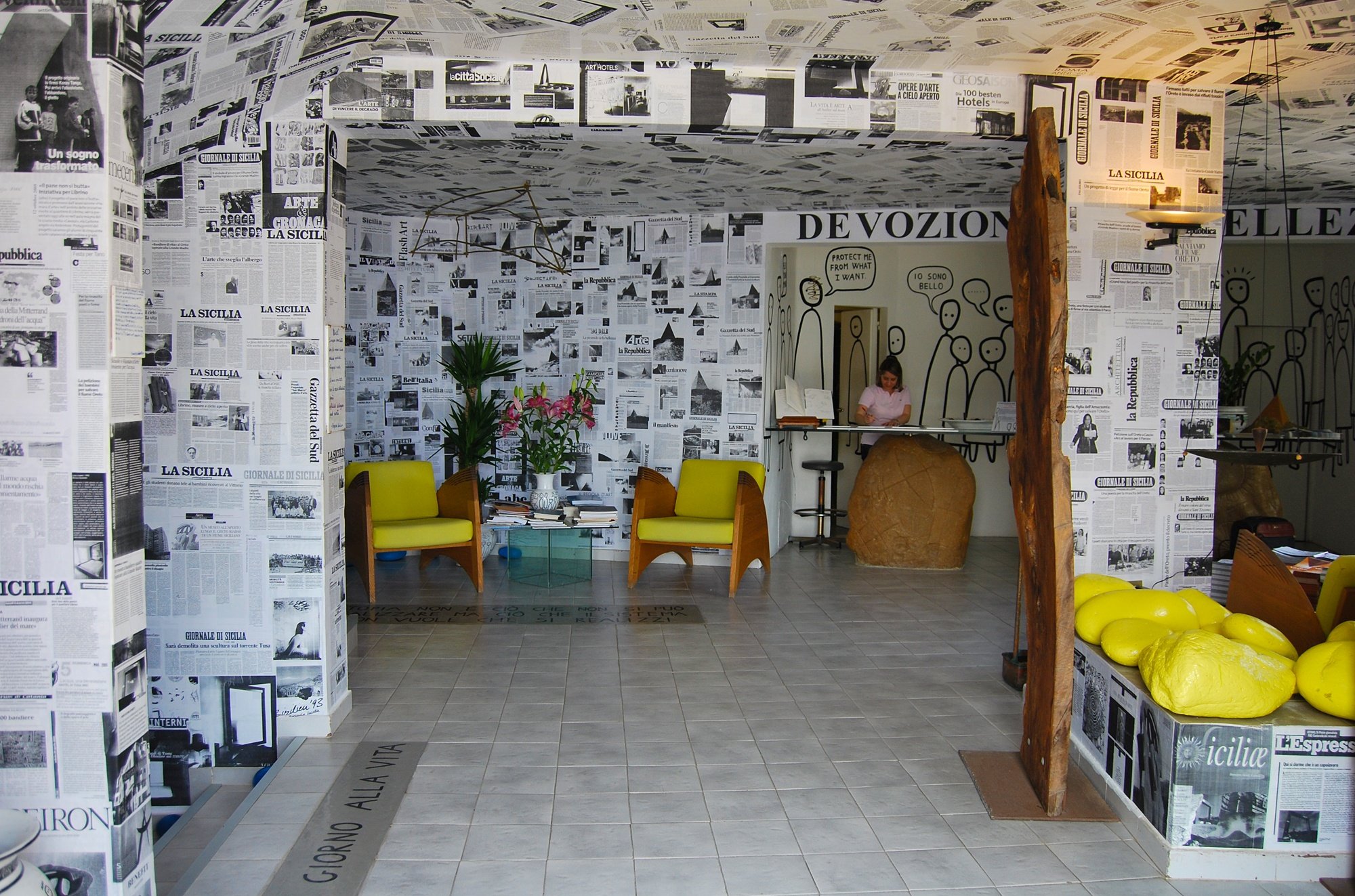
photo from www.coolturehunter.it
The twenty "art rooms" are almost impossible to describe. We are shown a number of them before we check in and get to choose which one we want to stay in. Then we join the regularly scheduled daily tour that allows a look at a number of the rooms...
You can click through the rooms at this web site: http://www.unusualhotelsoftheworld.com/MuseumHotelAteliersulMare
or on the hotel's own web site: http://www.ateliersulmare.com/en/.
We chose to stay in "The Room of the Prophet" designed by the hotel's creator, Antonio Presti, and dedicated to the writer and filmmaker Pier Paolo Pasolini, who was murdered in Rome in 1975. Intended to resemble a Yemenite mud hut with walls and ceilings of mud and straw, the room is furnished only with a bed (in a mud and straw frame) which looks out through a floor to ceiling window on the sea and mountains outside. No chairs, no furniture (save the bed),

photo from sprks.com
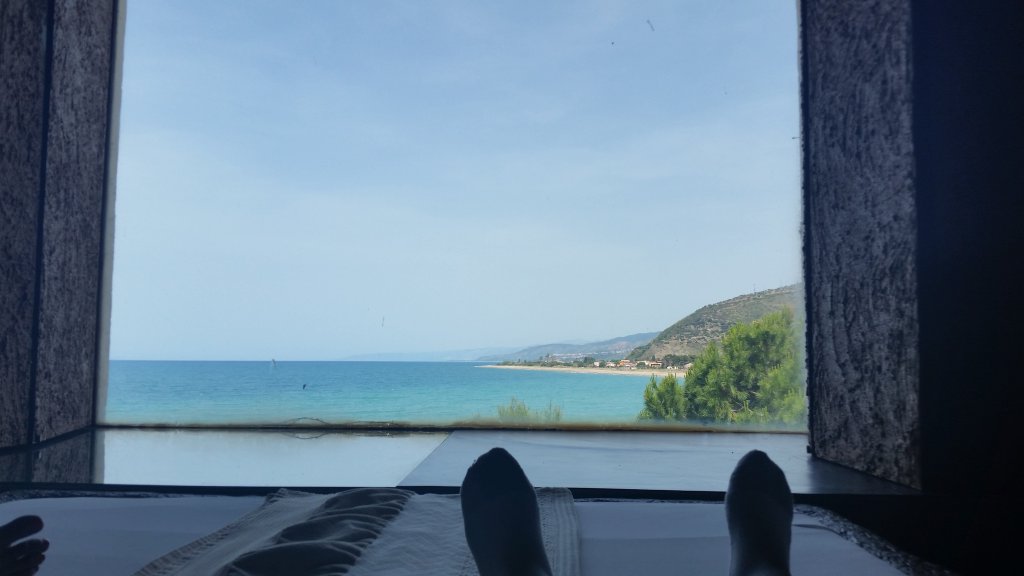
photo by J Zurer
I am including a link to a description of the hotel and the room by another traveler: https://secretgardenhome.com/2014/0...hotel-atelier-sul-mare-castel-di-tusa-sicily/.
During the day, we take the car out to visit the outdoor art installations--the Fiumara d'Arte--scattered in the hills around Castel di Tusa....organized by the owner of the hotel. Well worth taking a look at the web site to see them: http://www.ateliersulmare.com/en/fiumara_en/storia_fiumara_en.html.
And we had a great experience to end the day.....from my Facebook posting.
A nice story to report....We had a mishap with our car yesterday. After driving all over the hills on winding, narrow, rutted roads visiting the installations that are part of the Fiumara d'Arte, as I made a sharp turn onto the main road, I drove the car over a low ledge and got it stuck. The car behind us noticed our impending disaster and tried to warn us but I didn't hear. Once stuck, the driver and his sisters jumped out of the car and tried to figure out what to do.
Other cars passing by stopped when they saw the incident and it seemed that everyone knew everybody. Soon there was a group of 6 or 7 people gathered. They called someone with a truck who tried to pull us out but the rope broke. I was ready to call Europcar to send a tow truck but they all said no....
After about 45 minutes, they stuffed some rocks under the front wheel to raise the car and drove it off. Handshakes all around and kisses from the sisters and their brother. Everyone was friendly and supportive and some of them spoke of their relatives in the US.
A potential headache causing situation turns into a real "warm and fuzzy....." You gotta love Italy.
Day 26 - Reggio Calabria
Friday May 27
The next day, we took the ferry from Messina to the mainland and visited our friend Giuseppe Aloi in Reggio Calabria, staying overnight in his beautiful apartment. We went to see the spectacular Riace bronzes in the newly re-opened Museo Nazionale della Magna Grecia and did a laundry.
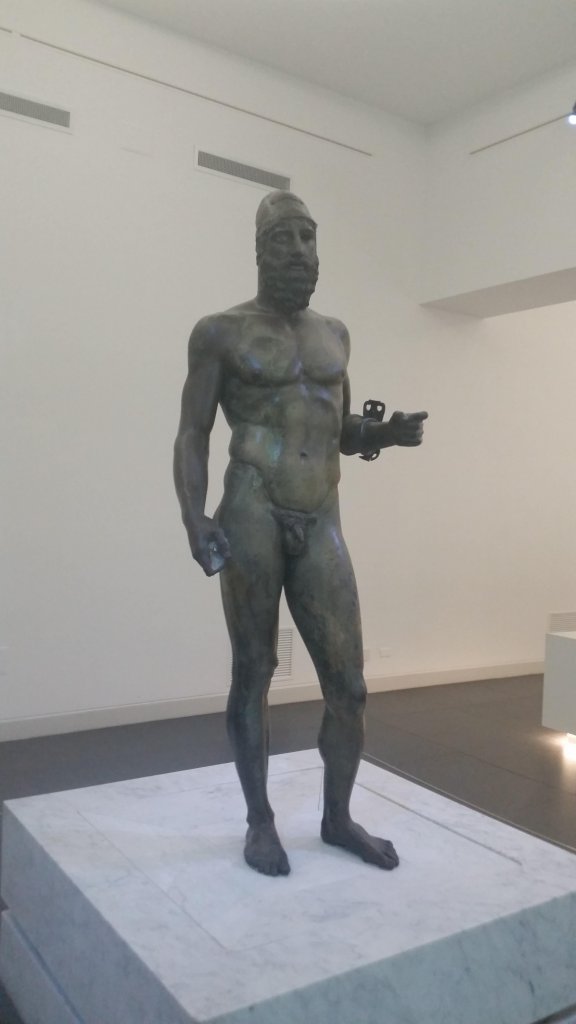
photo by J Zurer
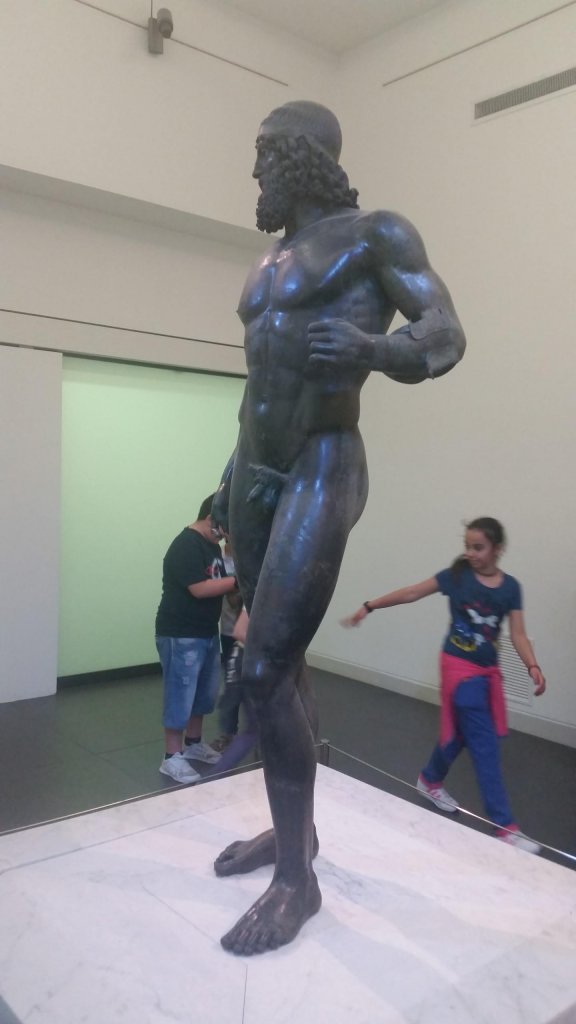
photo by J Zurer
Days 27 - 30: Santa Maria di Castellabate, Fregene
Saturday, May 28-Tuesday, May 31
We drove up the coast from Reggio Calabria to re-visit Santa Maria di Castellabate on the Cilento coast. I had been sick last year when we stayed there and the people at the Villa Sirio were very kind to us so I wanted to return. The drive that goes past Maratea is a winding, narrow coast road hugging the side of the hills and compares favorably to parts of the Amalfi Coast drive, with lots less traffic.
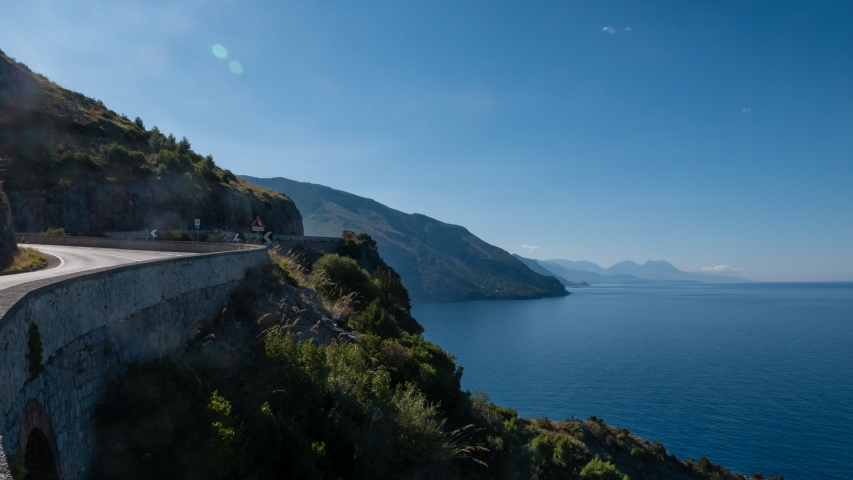
photo from italy-cycling-guide.info
And the road through Cilento National Park is also a pleasure to drive.
We have a relaxing time in the very attractive and pleasant village of Santa Maria di Castellabate...sitting (and quilting) in the sun, strolling around town, driving up a particularly challenging road to the hill town of Castellabate (taking the no less curvy but calmer road back down) and having a terrific lunch (probably the best of the trip) at da Carmine in Ogliastro Marina with friends (Valerie and Bryan Schneider) who drove up from Basilicata to see us. We also had a very warm reunion with the family and staff of the hotel who had been so attentive to us last year.
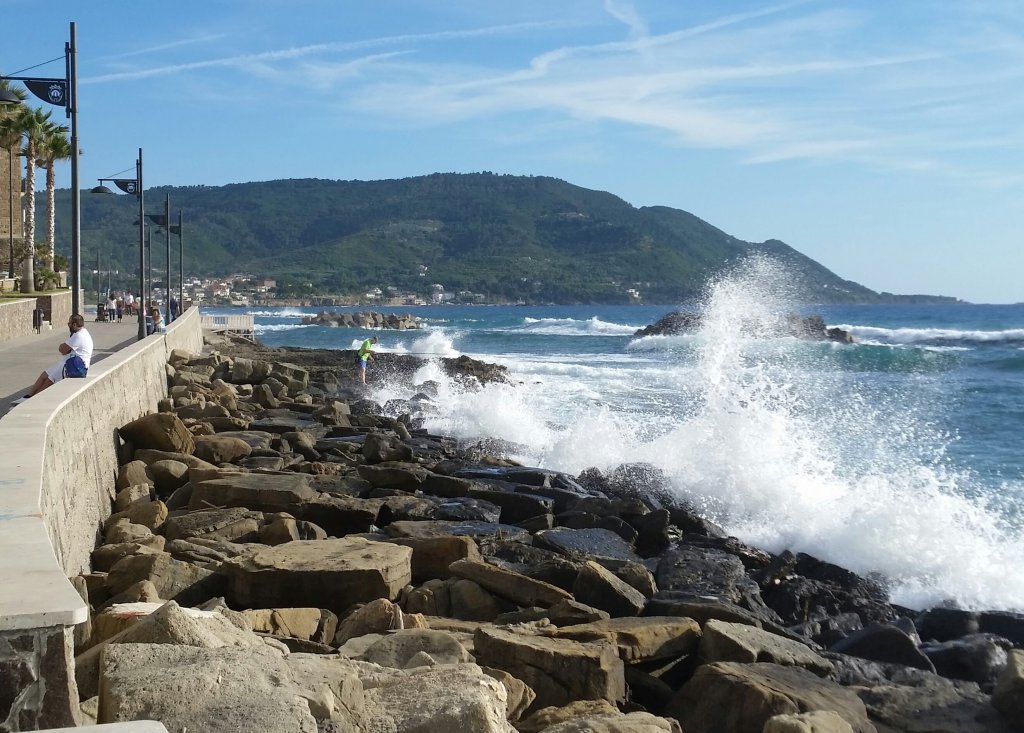
photo by J Zurer
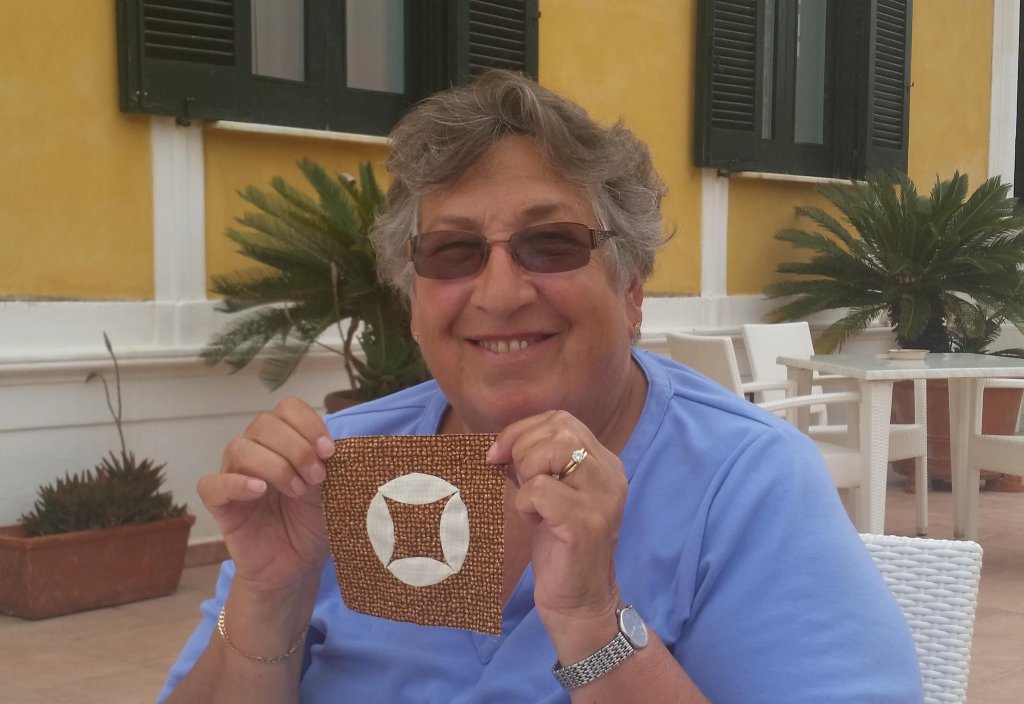
photo by J Zurer
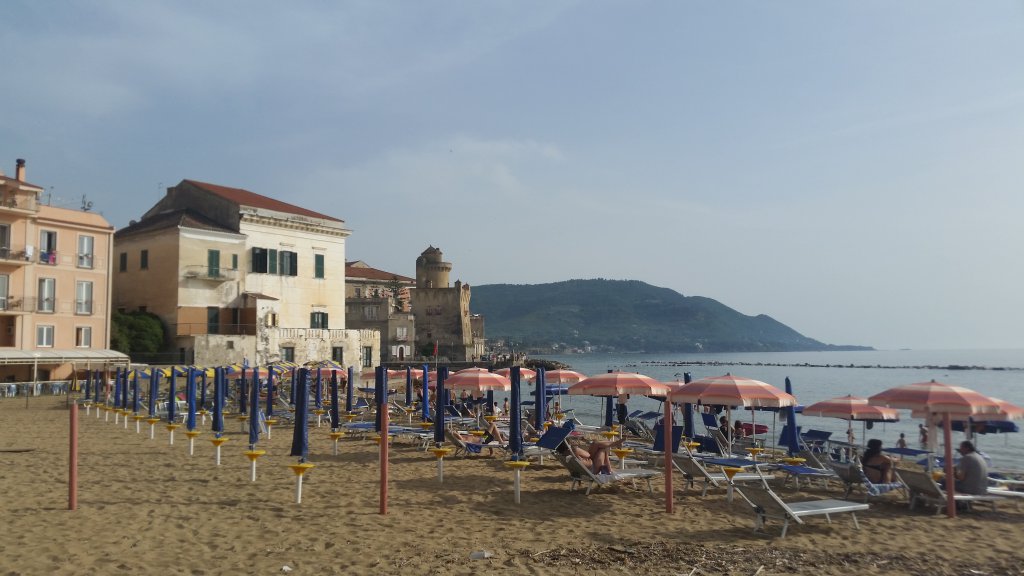
photo by J Zurer
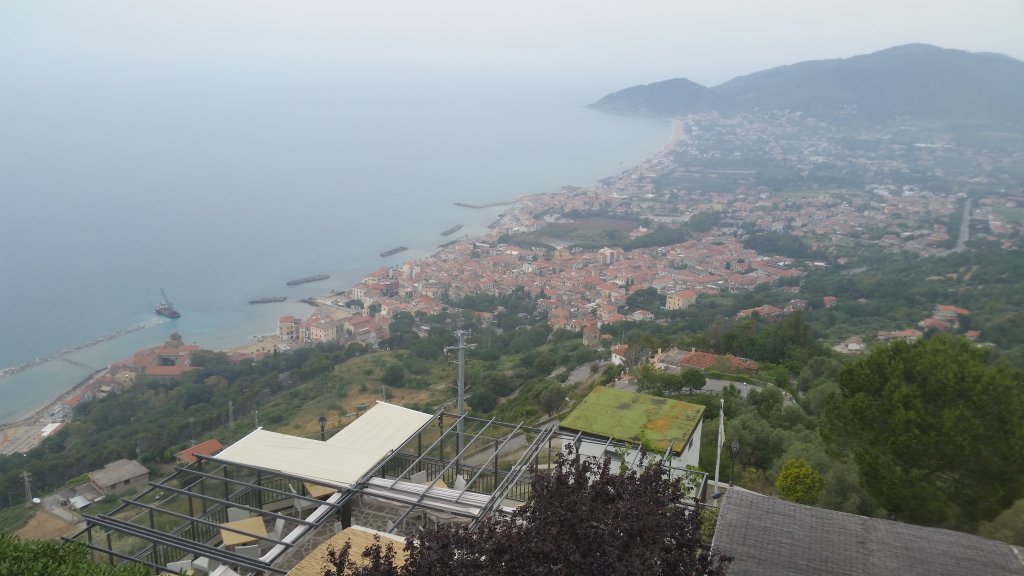
photo by J Zurer
On the night before the flight home, we stayed in Fregene, a very restrained resort town just outside of Rome. We stopped for lunch for a porchetta sandwich in Frascati.
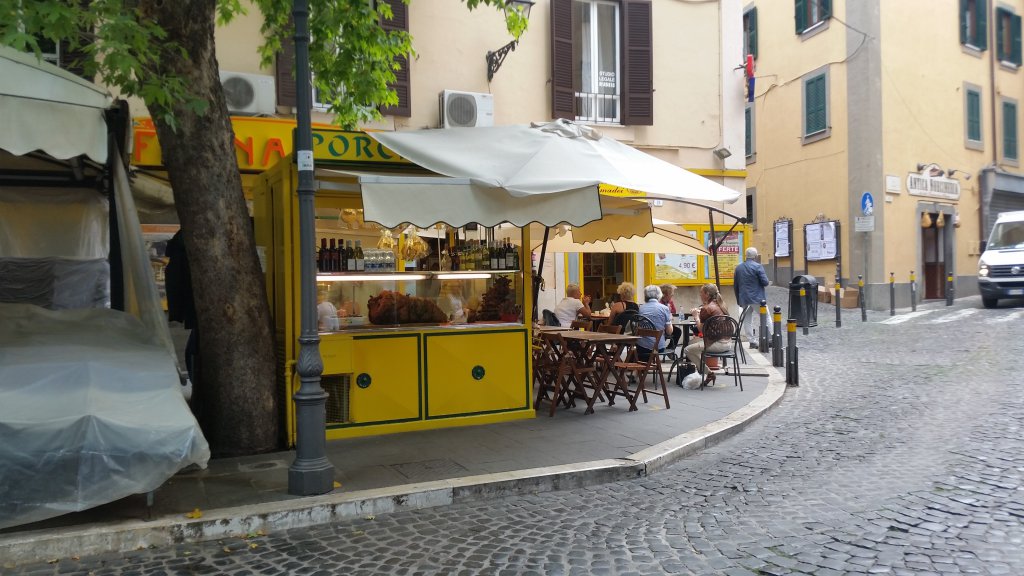
photo by J Zurer
and had our final dinner of cucina Romana (cacio e pepe, grilled sausage, lamb chops and cicoria) at a pleasant, low-key trattoria in Fregene.
It was a great trip...we really enjoyed our time in Sicily and the weather was almost perfect the whole time. Now to plan Zurers in Italy 2017.
Jim and Diana
Italy 2016: May 26-June 1
We are home and I want to briefly recap the last part of our trip.
Day 25 - Castel di Tusa
Thursday, May 26
We left Cefalu and drove 30 minutes east to the small fishing village of Castel di Tusa in order to stay at a hotel that I had read about for many years. The Atelier sul Mare is more a modern art installation and political statement than just a hotel....twenty of the bedrooms were designed by modern artists who were encouraged to make artistic statements. The lobby of the hotel is covered with reproductions of newspaper notices about the hotel and its creator, Antonio Presti.

photo from www.coolturehunter.it
The twenty "art rooms" are almost impossible to describe. We are shown a number of them before we check in and get to choose which one we want to stay in. Then we join the regularly scheduled daily tour that allows a look at a number of the rooms...
You can click through the rooms at this web site: http://www.unusualhotelsoftheworld.com/MuseumHotelAteliersulMare
or on the hotel's own web site: http://www.ateliersulmare.com/en/.
We chose to stay in "The Room of the Prophet" designed by the hotel's creator, Antonio Presti, and dedicated to the writer and filmmaker Pier Paolo Pasolini, who was murdered in Rome in 1975. Intended to resemble a Yemenite mud hut with walls and ceilings of mud and straw, the room is furnished only with a bed (in a mud and straw frame) which looks out through a floor to ceiling window on the sea and mountains outside. No chairs, no furniture (save the bed),

photo from sprks.com
photo by J Zurer
I am including a link to a description of the hotel and the room by another traveler: https://secretgardenhome.com/2014/0...hotel-atelier-sul-mare-castel-di-tusa-sicily/.
During the day, we take the car out to visit the outdoor art installations--the Fiumara d'Arte--scattered in the hills around Castel di Tusa....organized by the owner of the hotel. Well worth taking a look at the web site to see them: http://www.ateliersulmare.com/en/fiumara_en/storia_fiumara_en.html.
And we had a great experience to end the day.....from my Facebook posting.
A nice story to report....We had a mishap with our car yesterday. After driving all over the hills on winding, narrow, rutted roads visiting the installations that are part of the Fiumara d'Arte, as I made a sharp turn onto the main road, I drove the car over a low ledge and got it stuck. The car behind us noticed our impending disaster and tried to warn us but I didn't hear. Once stuck, the driver and his sisters jumped out of the car and tried to figure out what to do.
Other cars passing by stopped when they saw the incident and it seemed that everyone knew everybody. Soon there was a group of 6 or 7 people gathered. They called someone with a truck who tried to pull us out but the rope broke. I was ready to call Europcar to send a tow truck but they all said no....
After about 45 minutes, they stuffed some rocks under the front wheel to raise the car and drove it off. Handshakes all around and kisses from the sisters and their brother. Everyone was friendly and supportive and some of them spoke of their relatives in the US.
A potential headache causing situation turns into a real "warm and fuzzy....." You gotta love Italy.
Day 26 - Reggio Calabria
Friday May 27
The next day, we took the ferry from Messina to the mainland and visited our friend Giuseppe Aloi in Reggio Calabria, staying overnight in his beautiful apartment. We went to see the spectacular Riace bronzes in the newly re-opened Museo Nazionale della Magna Grecia and did a laundry.
photo by J Zurer
photo by J Zurer
Days 27 - 30: Santa Maria di Castellabate, Fregene
Saturday, May 28-Tuesday, May 31
We drove up the coast from Reggio Calabria to re-visit Santa Maria di Castellabate on the Cilento coast. I had been sick last year when we stayed there and the people at the Villa Sirio were very kind to us so I wanted to return. The drive that goes past Maratea is a winding, narrow coast road hugging the side of the hills and compares favorably to parts of the Amalfi Coast drive, with lots less traffic.

photo from italy-cycling-guide.info
And the road through Cilento National Park is also a pleasure to drive.
We have a relaxing time in the very attractive and pleasant village of Santa Maria di Castellabate...sitting (and quilting) in the sun, strolling around town, driving up a particularly challenging road to the hill town of Castellabate (taking the no less curvy but calmer road back down) and having a terrific lunch (probably the best of the trip) at da Carmine in Ogliastro Marina with friends (Valerie and Bryan Schneider) who drove up from Basilicata to see us. We also had a very warm reunion with the family and staff of the hotel who had been so attentive to us last year.
photo by J Zurer
photo by J Zurer
photo by J Zurer
photo by J Zurer
On the night before the flight home, we stayed in Fregene, a very restrained resort town just outside of Rome. We stopped for lunch for a porchetta sandwich in Frascati.
photo by J Zurer
and had our final dinner of cucina Romana (cacio e pepe, grilled sausage, lamb chops and cicoria) at a pleasant, low-key trattoria in Fregene.
It was a great trip...we really enjoyed our time in Sicily and the weather was almost perfect the whole time. Now to plan Zurers in Italy 2017.
Jim and Diana
SusanSeattle
100+ Posts
Thanks for the amazing trip report. I've enjoyed the descriptions & the photos! Now I have another place I want to visit.
How to Find Information
Search using the search button in the upper right. Search all forums or current forum by keyword or member. Advanced search gives you more options.
Filter forum threads using the filter pulldown above the threads. Filter by prefix, member, date. Or click on a thread title prefix to see all threads with that prefix.
Recommended Guides, Apps and Books
52 Things to See and Do in Basilicata by Valerie Fortney Italian Ancestral Journeys by Bryan Schneider Italian Food & Life Rules by Ann Reavis Italian Food Decoder App by Dana Facaros, Michael Pauls French Food Decoder App by Dana Facaros, Michael Pauls She Left No Note, Lake Iseo Italy Mystery 1 by J L Crellina Tuscan Traveler, Living in Italy by Ann Reavis
